End User Perception of Medical Technologies
VerifiedAdded on 2020/01/23
|35
|12906
|97
Essay
AI Summary
This assignment explores end user perceptions of various medical technologies, particularly narrow-band imaging for oral cancer detection and ultrasound elastography. It utilizes theoretical frameworks like the Technology Acceptance Model (TAM), Matching Person and Technology Model (MPT), and Extended TAM to understand factors influencing technology adoption. The focus is on KSA hospitals and incorporates relevant studies and illustrations to support the analysis.
Contribute Materials
Your contribution can guide someone’s learning journey. Share your
documents today.
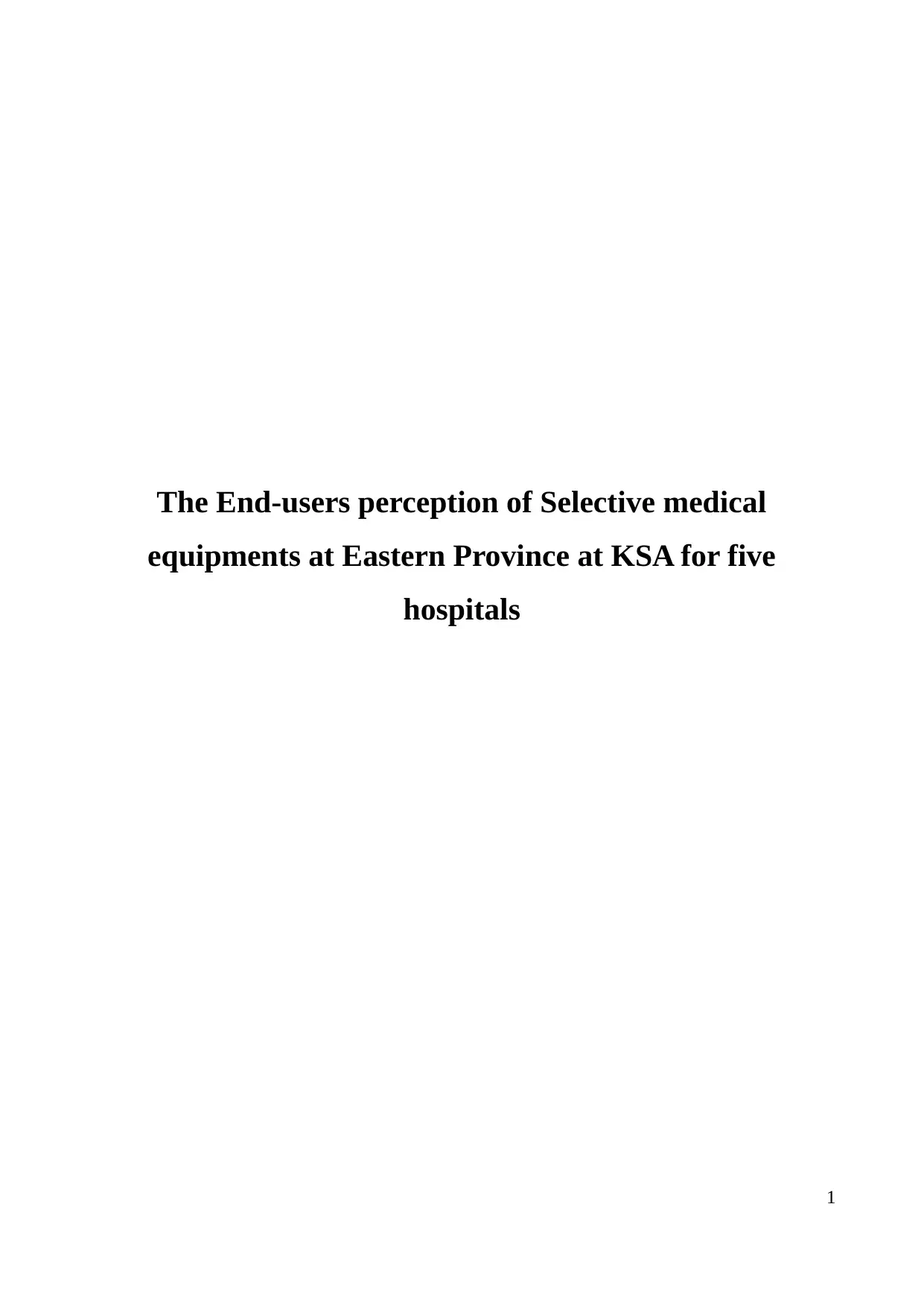
The End-users perception of Selective medical
equipments at Eastern Province at KSA for five
hospitals
1
equipments at Eastern Province at KSA for five
hospitals
1
Secure Best Marks with AI Grader
Need help grading? Try our AI Grader for instant feedback on your assignments.
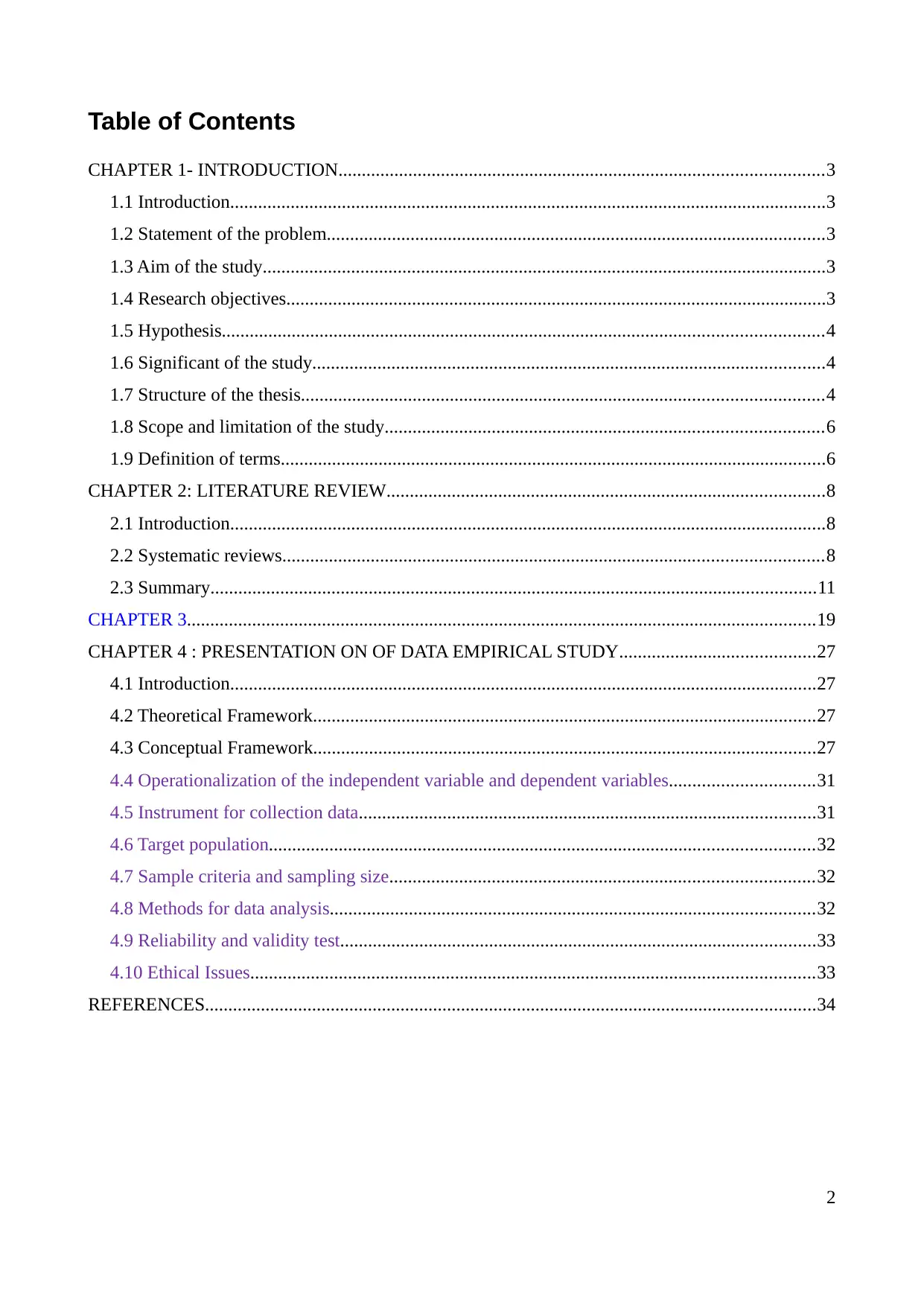
Table of Contents
CHAPTER 1- INTRODUCTION........................................................................................................3
1.1 Introduction................................................................................................................................3
1.2 Statement of the problem...........................................................................................................3
1.3 Aim of the study.........................................................................................................................3
1.4 Research objectives....................................................................................................................3
1.5 Hypothesis.................................................................................................................................4
1.6 Significant of the study..............................................................................................................4
1.7 Structure of the thesis................................................................................................................4
1.8 Scope and limitation of the study..............................................................................................6
1.9 Definition of terms.....................................................................................................................6
CHAPTER 2: LITERATURE REVIEW..............................................................................................8
2.1 Introduction................................................................................................................................8
2.2 Systematic reviews....................................................................................................................8
2.3 Summary..................................................................................................................................11
CHAPTER 3.......................................................................................................................................19
CHAPTER 4 : PRESENTATION ON OF DATA EMPIRICAL STUDY..........................................27
4.1 Introduction..............................................................................................................................27
4.2 Theoretical Framework............................................................................................................27
4.3 Conceptual Framework............................................................................................................27
4.4 Operationalization of the independent variable and dependent variables...............................31
4.5 Instrument for collection data..................................................................................................31
4.6 Target population.....................................................................................................................32
4.7 Sample criteria and sampling size...........................................................................................32
4.8 Methods for data analysis........................................................................................................32
4.9 Reliability and validity test......................................................................................................33
4.10 Ethical Issues.........................................................................................................................33
REFERENCES...................................................................................................................................34
2
CHAPTER 1- INTRODUCTION........................................................................................................3
1.1 Introduction................................................................................................................................3
1.2 Statement of the problem...........................................................................................................3
1.3 Aim of the study.........................................................................................................................3
1.4 Research objectives....................................................................................................................3
1.5 Hypothesis.................................................................................................................................4
1.6 Significant of the study..............................................................................................................4
1.7 Structure of the thesis................................................................................................................4
1.8 Scope and limitation of the study..............................................................................................6
1.9 Definition of terms.....................................................................................................................6
CHAPTER 2: LITERATURE REVIEW..............................................................................................8
2.1 Introduction................................................................................................................................8
2.2 Systematic reviews....................................................................................................................8
2.3 Summary..................................................................................................................................11
CHAPTER 3.......................................................................................................................................19
CHAPTER 4 : PRESENTATION ON OF DATA EMPIRICAL STUDY..........................................27
4.1 Introduction..............................................................................................................................27
4.2 Theoretical Framework............................................................................................................27
4.3 Conceptual Framework............................................................................................................27
4.4 Operationalization of the independent variable and dependent variables...............................31
4.5 Instrument for collection data..................................................................................................31
4.6 Target population.....................................................................................................................32
4.7 Sample criteria and sampling size...........................................................................................32
4.8 Methods for data analysis........................................................................................................32
4.9 Reliability and validity test......................................................................................................33
4.10 Ethical Issues.........................................................................................................................33
REFERENCES...................................................................................................................................34
2
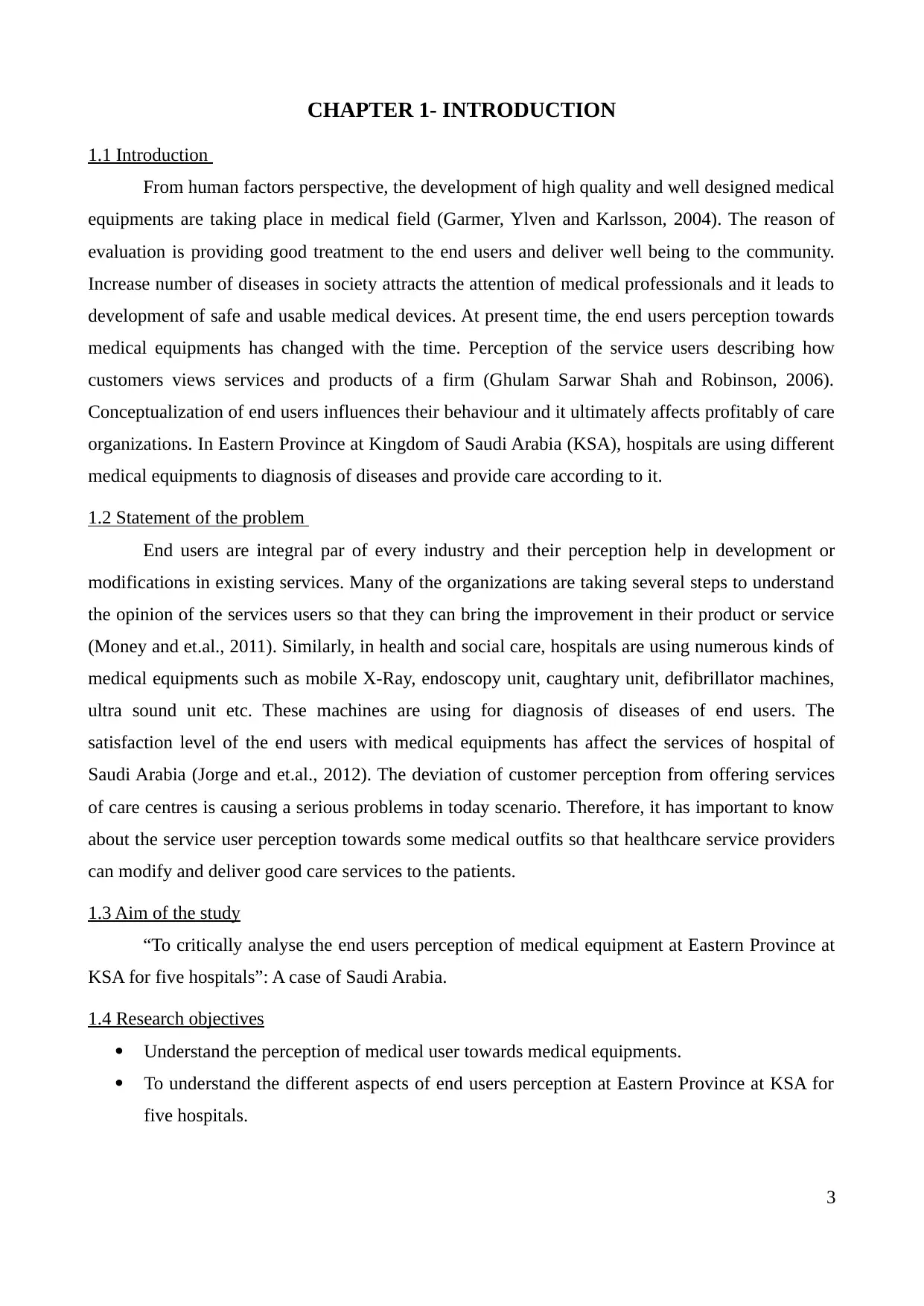
CHAPTER 1- INTRODUCTION
1.1 Introduction
From human factors perspective, the development of high quality and well designed medical
equipments are taking place in medical field (Garmer, Ylven and Karlsson, 2004). The reason of
evaluation is providing good treatment to the end users and deliver well being to the community.
Increase number of diseases in society attracts the attention of medical professionals and it leads to
development of safe and usable medical devices. At present time, the end users perception towards
medical equipments has changed with the time. Perception of the service users describing how
customers views services and products of a firm (Ghulam Sarwar Shah and Robinson, 2006).
Conceptualization of end users influences their behaviour and it ultimately affects profitably of care
organizations. In Eastern Province at Kingdom of Saudi Arabia (KSA), hospitals are using different
medical equipments to diagnosis of diseases and provide care according to it.
1.2 Statement of the problem
End users are integral par of every industry and their perception help in development or
modifications in existing services. Many of the organizations are taking several steps to understand
the opinion of the services users so that they can bring the improvement in their product or service
(Money and et.al., 2011). Similarly, in health and social care, hospitals are using numerous kinds of
medical equipments such as mobile X-Ray, endoscopy unit, caughtary unit, defibrillator machines,
ultra sound unit etc. These machines are using for diagnosis of diseases of end users. The
satisfaction level of the end users with medical equipments has affect the services of hospital of
Saudi Arabia (Jorge and et.al., 2012). The deviation of customer perception from offering services
of care centres is causing a serious problems in today scenario. Therefore, it has important to know
about the service user perception towards some medical outfits so that healthcare service providers
can modify and deliver good care services to the patients.
1.3 Aim of the study
“To critically analyse the end users perception of medical equipment at Eastern Province at
KSA for five hospitals”: A case of Saudi Arabia.
1.4 Research objectives
Understand the perception of medical user towards medical equipments.
To understand the different aspects of end users perception at Eastern Province at KSA for
five hospitals.
3
1.1 Introduction
From human factors perspective, the development of high quality and well designed medical
equipments are taking place in medical field (Garmer, Ylven and Karlsson, 2004). The reason of
evaluation is providing good treatment to the end users and deliver well being to the community.
Increase number of diseases in society attracts the attention of medical professionals and it leads to
development of safe and usable medical devices. At present time, the end users perception towards
medical equipments has changed with the time. Perception of the service users describing how
customers views services and products of a firm (Ghulam Sarwar Shah and Robinson, 2006).
Conceptualization of end users influences their behaviour and it ultimately affects profitably of care
organizations. In Eastern Province at Kingdom of Saudi Arabia (KSA), hospitals are using different
medical equipments to diagnosis of diseases and provide care according to it.
1.2 Statement of the problem
End users are integral par of every industry and their perception help in development or
modifications in existing services. Many of the organizations are taking several steps to understand
the opinion of the services users so that they can bring the improvement in their product or service
(Money and et.al., 2011). Similarly, in health and social care, hospitals are using numerous kinds of
medical equipments such as mobile X-Ray, endoscopy unit, caughtary unit, defibrillator machines,
ultra sound unit etc. These machines are using for diagnosis of diseases of end users. The
satisfaction level of the end users with medical equipments has affect the services of hospital of
Saudi Arabia (Jorge and et.al., 2012). The deviation of customer perception from offering services
of care centres is causing a serious problems in today scenario. Therefore, it has important to know
about the service user perception towards some medical outfits so that healthcare service providers
can modify and deliver good care services to the patients.
1.3 Aim of the study
“To critically analyse the end users perception of medical equipment at Eastern Province at
KSA for five hospitals”: A case of Saudi Arabia.
1.4 Research objectives
Understand the perception of medical user towards medical equipments.
To understand the different aspects of end users perception at Eastern Province at KSA for
five hospitals.
3
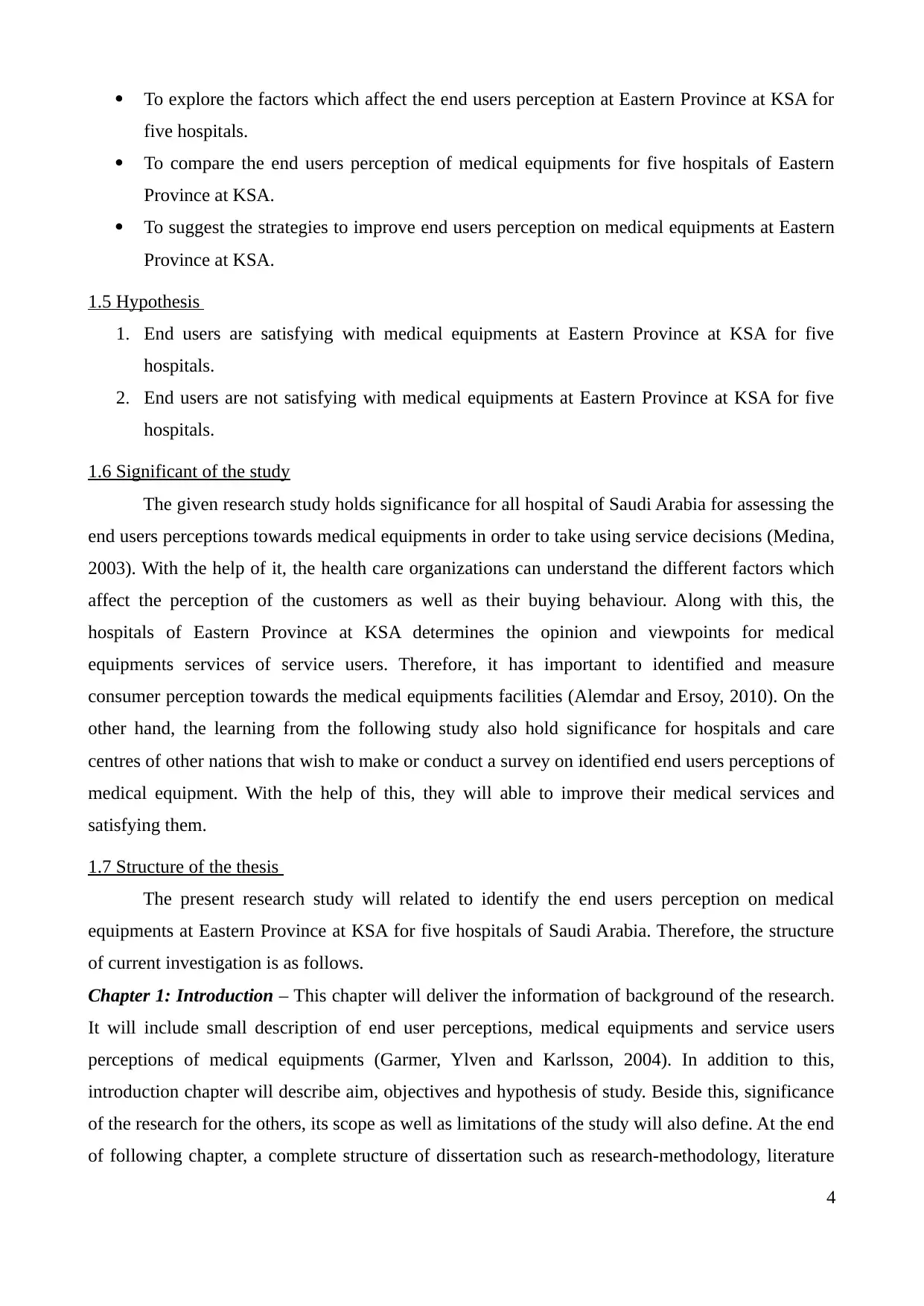
To explore the factors which affect the end users perception at Eastern Province at KSA for
five hospitals.
To compare the end users perception of medical equipments for five hospitals of Eastern
Province at KSA.
To suggest the strategies to improve end users perception on medical equipments at Eastern
Province at KSA.
1.5 Hypothesis
1. End users are satisfying with medical equipments at Eastern Province at KSA for five
hospitals.
2. End users are not satisfying with medical equipments at Eastern Province at KSA for five
hospitals.
1.6 Significant of the study
The given research study holds significance for all hospital of Saudi Arabia for assessing the
end users perceptions towards medical equipments in order to take using service decisions (Medina,
2003). With the help of it, the health care organizations can understand the different factors which
affect the perception of the customers as well as their buying behaviour. Along with this, the
hospitals of Eastern Province at KSA determines the opinion and viewpoints for medical
equipments services of service users. Therefore, it has important to identified and measure
consumer perception towards the medical equipments facilities (Alemdar and Ersoy, 2010). On the
other hand, the learning from the following study also hold significance for hospitals and care
centres of other nations that wish to make or conduct a survey on identified end users perceptions of
medical equipment. With the help of this, they will able to improve their medical services and
satisfying them.
1.7 Structure of the thesis
The present research study will related to identify the end users perception on medical
equipments at Eastern Province at KSA for five hospitals of Saudi Arabia. Therefore, the structure
of current investigation is as follows.
Chapter 1: Introduction – This chapter will deliver the information of background of the research.
It will include small description of end user perceptions, medical equipments and service users
perceptions of medical equipments (Garmer, Ylven and Karlsson, 2004). In addition to this,
introduction chapter will describe aim, objectives and hypothesis of study. Beside this, significance
of the research for the others, its scope as well as limitations of the study will also define. At the end
of following chapter, a complete structure of dissertation such as research-methodology, literature
4
five hospitals.
To compare the end users perception of medical equipments for five hospitals of Eastern
Province at KSA.
To suggest the strategies to improve end users perception on medical equipments at Eastern
Province at KSA.
1.5 Hypothesis
1. End users are satisfying with medical equipments at Eastern Province at KSA for five
hospitals.
2. End users are not satisfying with medical equipments at Eastern Province at KSA for five
hospitals.
1.6 Significant of the study
The given research study holds significance for all hospital of Saudi Arabia for assessing the
end users perceptions towards medical equipments in order to take using service decisions (Medina,
2003). With the help of it, the health care organizations can understand the different factors which
affect the perception of the customers as well as their buying behaviour. Along with this, the
hospitals of Eastern Province at KSA determines the opinion and viewpoints for medical
equipments services of service users. Therefore, it has important to identified and measure
consumer perception towards the medical equipments facilities (Alemdar and Ersoy, 2010). On the
other hand, the learning from the following study also hold significance for hospitals and care
centres of other nations that wish to make or conduct a survey on identified end users perceptions of
medical equipment. With the help of this, they will able to improve their medical services and
satisfying them.
1.7 Structure of the thesis
The present research study will related to identify the end users perception on medical
equipments at Eastern Province at KSA for five hospitals of Saudi Arabia. Therefore, the structure
of current investigation is as follows.
Chapter 1: Introduction – This chapter will deliver the information of background of the research.
It will include small description of end user perceptions, medical equipments and service users
perceptions of medical equipments (Garmer, Ylven and Karlsson, 2004). In addition to this,
introduction chapter will describe aim, objectives and hypothesis of study. Beside this, significance
of the research for the others, its scope as well as limitations of the study will also define. At the end
of following chapter, a complete structure of dissertation such as research-methodology, literature
4
Secure Best Marks with AI Grader
Need help grading? Try our AI Grader for instant feedback on your assignments.

review, data analysis and conclusion will mentioned (Ghulam Sarwar Shah and Robinson, 2006).
These all subsections will help the researcher to identify the end users perception of medical
equipments at Eastern Province at KSA for five hospitals of Saudi Arabia.
Chapter 2: Summary of Literature review – The following chapter will deliver a complete
overview of conducting the research. It will summarize and access what has already been written in
the areas of end users perception for medical equipments. For the study, the different sources of
information will take into the consideration such as books, journals, articles, newspapers etc. The
statements and research of different authors in favour and opposite of end users perception on
medical equipments will include by the researcher in literature review.
Chapter 3: Methodology: Summary of Empirical Study – The chapter will define various
methodology that will used under the following study by the researcher (Bordens and Abbott,
2002). Research approach, strategy, data collection method, research design etc will include under
research methodology section. The justification of selection of all kind of research methodologies
by the researcher will also give under the following chapter.
Chapter 4: Presentation of Data Empirical Study – This section of dissertation help in justifying
the approaches which will used by the scholar during the research. The aspects will cover under the
following chapter are conceptual and theoretical framework, instrument of data collection, sampling
technique, target population, methods and tools of data analysis, reliability and validity test as well
as ethical considerations (Cochran, 2007). The analysed data will be represented by the scholar in
various forms such as table, figures, charts etc.
Chapter 5: Analysis of data – Here, the methodological tools will applied by the researcher to
identify the end user perception on medical equipments at Eastern Province at KSA for five
hospitals of Saudi Arabia. Along with this, the questionnaire will be analyse by the investigator with
respect to the aim of the study (Creswell, 2013). Different kinds of analysis tools will used by the
researcher to analyse the collected data and meet the objectives and aim of the study.
Chapter 6: Discussion and interpretation of the findings – Under the following chapter, the
researcher will interpret the outcomes. Along with this, the main key points of the analysis will be
draw out by the scholar and prove the hypothesis (Csikszentmihalyi and Larson, 2014). Beside this,
the results of five hospitals will compare and determine perception of end users on medical
equipments at Eastern Province at Kingdom of Saudi Arabia.
Chapter 7: Conclusion, implications and recommendations – This chapter will cover the
meaningful conclusion according to the findings of data analysis and discussion sections. In
addition to this, some recommendations will also give by the investigator with the respect of change
in end users perceptions on medical equipments at Eastern Province at KSA for five hospitals of
5
These all subsections will help the researcher to identify the end users perception of medical
equipments at Eastern Province at KSA for five hospitals of Saudi Arabia.
Chapter 2: Summary of Literature review – The following chapter will deliver a complete
overview of conducting the research. It will summarize and access what has already been written in
the areas of end users perception for medical equipments. For the study, the different sources of
information will take into the consideration such as books, journals, articles, newspapers etc. The
statements and research of different authors in favour and opposite of end users perception on
medical equipments will include by the researcher in literature review.
Chapter 3: Methodology: Summary of Empirical Study – The chapter will define various
methodology that will used under the following study by the researcher (Bordens and Abbott,
2002). Research approach, strategy, data collection method, research design etc will include under
research methodology section. The justification of selection of all kind of research methodologies
by the researcher will also give under the following chapter.
Chapter 4: Presentation of Data Empirical Study – This section of dissertation help in justifying
the approaches which will used by the scholar during the research. The aspects will cover under the
following chapter are conceptual and theoretical framework, instrument of data collection, sampling
technique, target population, methods and tools of data analysis, reliability and validity test as well
as ethical considerations (Cochran, 2007). The analysed data will be represented by the scholar in
various forms such as table, figures, charts etc.
Chapter 5: Analysis of data – Here, the methodological tools will applied by the researcher to
identify the end user perception on medical equipments at Eastern Province at KSA for five
hospitals of Saudi Arabia. Along with this, the questionnaire will be analyse by the investigator with
respect to the aim of the study (Creswell, 2013). Different kinds of analysis tools will used by the
researcher to analyse the collected data and meet the objectives and aim of the study.
Chapter 6: Discussion and interpretation of the findings – Under the following chapter, the
researcher will interpret the outcomes. Along with this, the main key points of the analysis will be
draw out by the scholar and prove the hypothesis (Csikszentmihalyi and Larson, 2014). Beside this,
the results of five hospitals will compare and determine perception of end users on medical
equipments at Eastern Province at Kingdom of Saudi Arabia.
Chapter 7: Conclusion, implications and recommendations – This chapter will cover the
meaningful conclusion according to the findings of data analysis and discussion sections. In
addition to this, some recommendations will also give by the investigator with the respect of change
in end users perceptions on medical equipments at Eastern Province at KSA for five hospitals of
5

Saudi Arabia (Daniel and Sam, 2011).
1.8 Scope and limitation of the study
The following study will related to identify the end users perceptions on medical equipments
at Eastern Province at Kingdom of Saudi Arabia. The future scope of the present investigation is
very wide (James and et.al., 2006). This study is conducting for hospitals of Saudi Arabia by
including five medical equipments which are mobile X-Ray, endoscopy unit, caughtary unit,
defibrillator machines, ultra sound unit. In future, this research can be used by the other researchers
for different country hospitals. Along with this, by considering one medical equipments of care
centres, the end users perceptions will be determined (Babulak, 2006).
On the other hand, the researcher will face some limitations during conducting the
investigation (Garmer, Ylven and Karlsson, 2004). The first boundary will availability of less
previous researches on determine the end users perceptions on medical equipments with respect of
Saudi Arabia. This will create a difficulty for the scholar to gather the information on the particular
issue. Second limitation is it will hard to compare end users perception on medical equipments of
five hospitals. It will affect the findings of the investigation (Ghulam Sarwar Shah and Robinson,
2006). Rather than this, the other limitations that will face by the researcher are lack of experience,
lack of time, require huge amount of money to conduct the survey etc.
1.9 Definition of terms
The present research will based on identify the end users perceptions on medical equipments
at Eastern Province at Kingdom of Saudi Arabia. In this regards, the different terms will be used by
the researcher during addressing the study which are as follows.
End user perception: It is refer to a process by which a service user select, organize and interpret
the various information with the purpose of creating a meaningful picture for a specific brand
service or product (Money and et.al., 2011). It the other words, end user perception defines how a
consumer view a particular commodity on his own opinions. Perception of the service users may
deviate from what is offering by a service provider to the community. The relationship between the
companies and its customers is not always based on prices and quality of the services (Jorge and
et.al., 2012). At the time of buying the services of an health care organization, a services user
evaluates the benefits of a particular service and compare it with other firms products. It leads to
bring the changes in the perception of the end users. Therefore, it has important to understand the
reasons behind change in customer perception with respect of healthcare services.
Medical equipments: These are used for particular purpose such as diagnosis and treatment of
diseases, rehabilitation during injury etc. It can either use alone or with the combination of other
6
1.8 Scope and limitation of the study
The following study will related to identify the end users perceptions on medical equipments
at Eastern Province at Kingdom of Saudi Arabia. The future scope of the present investigation is
very wide (James and et.al., 2006). This study is conducting for hospitals of Saudi Arabia by
including five medical equipments which are mobile X-Ray, endoscopy unit, caughtary unit,
defibrillator machines, ultra sound unit. In future, this research can be used by the other researchers
for different country hospitals. Along with this, by considering one medical equipments of care
centres, the end users perceptions will be determined (Babulak, 2006).
On the other hand, the researcher will face some limitations during conducting the
investigation (Garmer, Ylven and Karlsson, 2004). The first boundary will availability of less
previous researches on determine the end users perceptions on medical equipments with respect of
Saudi Arabia. This will create a difficulty for the scholar to gather the information on the particular
issue. Second limitation is it will hard to compare end users perception on medical equipments of
five hospitals. It will affect the findings of the investigation (Ghulam Sarwar Shah and Robinson,
2006). Rather than this, the other limitations that will face by the researcher are lack of experience,
lack of time, require huge amount of money to conduct the survey etc.
1.9 Definition of terms
The present research will based on identify the end users perceptions on medical equipments
at Eastern Province at Kingdom of Saudi Arabia. In this regards, the different terms will be used by
the researcher during addressing the study which are as follows.
End user perception: It is refer to a process by which a service user select, organize and interpret
the various information with the purpose of creating a meaningful picture for a specific brand
service or product (Money and et.al., 2011). It the other words, end user perception defines how a
consumer view a particular commodity on his own opinions. Perception of the service users may
deviate from what is offering by a service provider to the community. The relationship between the
companies and its customers is not always based on prices and quality of the services (Jorge and
et.al., 2012). At the time of buying the services of an health care organization, a services user
evaluates the benefits of a particular service and compare it with other firms products. It leads to
bring the changes in the perception of the end users. Therefore, it has important to understand the
reasons behind change in customer perception with respect of healthcare services.
Medical equipments: These are used for particular purpose such as diagnosis and treatment of
diseases, rehabilitation during injury etc. It can either use alone or with the combination of other
6

accessories. Medical equipments are generally implantable and not easily disposable (Medina,
2003). It is used in the prevention and treatment of illness as well as measuring or correcting the
function of body.
7
2003). It is used in the prevention and treatment of illness as well as measuring or correcting the
function of body.
7
Paraphrase This Document
Need a fresh take? Get an instant paraphrase of this document with our AI Paraphraser
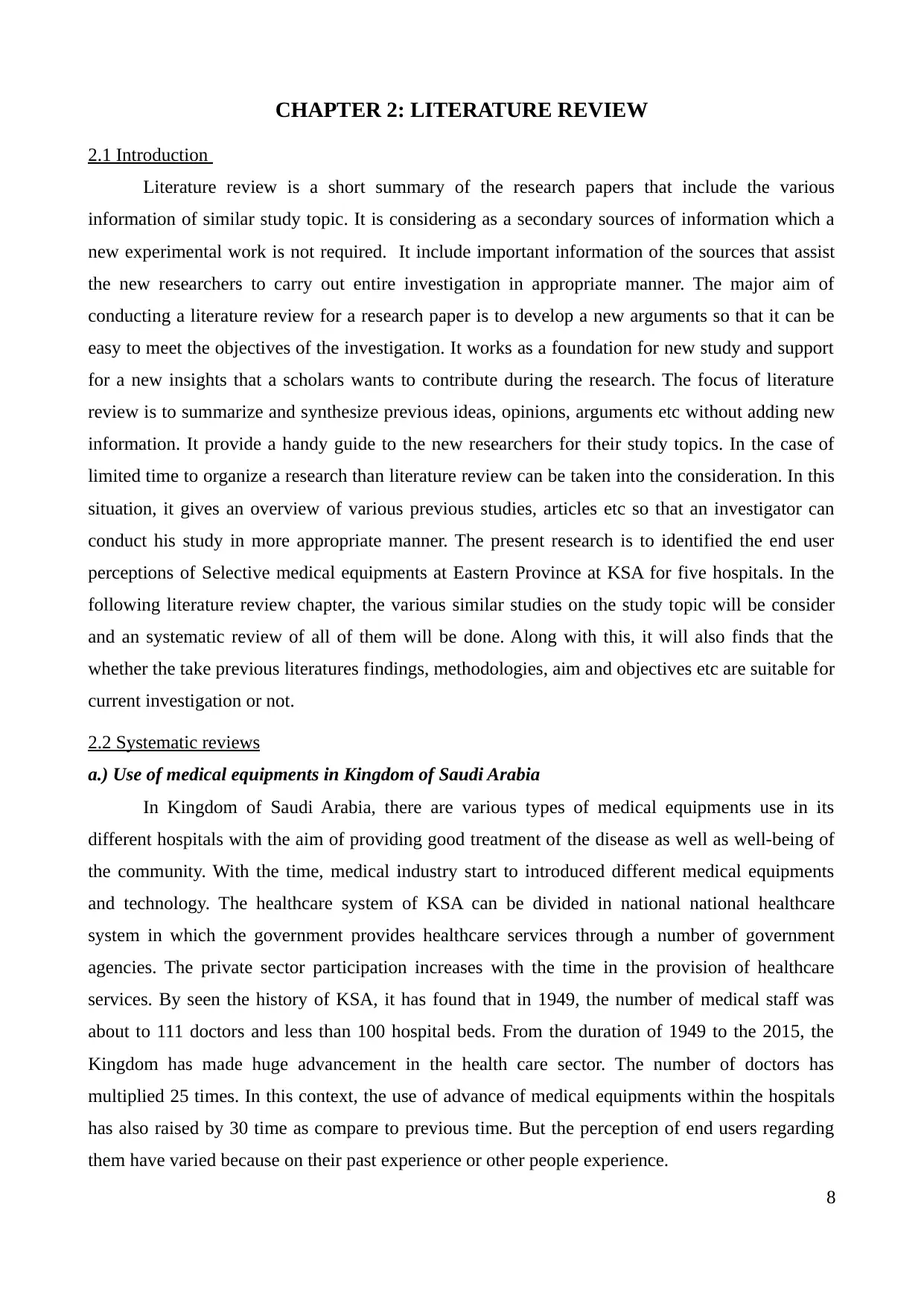
CHAPTER 2: LITERATURE REVIEW
2.1 Introduction
Literature review is a short summary of the research papers that include the various
information of similar study topic. It is considering as a secondary sources of information which a
new experimental work is not required. It include important information of the sources that assist
the new researchers to carry out entire investigation in appropriate manner. The major aim of
conducting a literature review for a research paper is to develop a new arguments so that it can be
easy to meet the objectives of the investigation. It works as a foundation for new study and support
for a new insights that a scholars wants to contribute during the research. The focus of literature
review is to summarize and synthesize previous ideas, opinions, arguments etc without adding new
information. It provide a handy guide to the new researchers for their study topics. In the case of
limited time to organize a research than literature review can be taken into the consideration. In this
situation, it gives an overview of various previous studies, articles etc so that an investigator can
conduct his study in more appropriate manner. The present research is to identified the end user
perceptions of Selective medical equipments at Eastern Province at KSA for five hospitals. In the
following literature review chapter, the various similar studies on the study topic will be consider
and an systematic review of all of them will be done. Along with this, it will also finds that the
whether the take previous literatures findings, methodologies, aim and objectives etc are suitable for
current investigation or not.
2.2 Systematic reviews
a.) Use of medical equipments in Kingdom of Saudi Arabia
In Kingdom of Saudi Arabia, there are various types of medical equipments use in its
different hospitals with the aim of providing good treatment of the disease as well as well-being of
the community. With the time, medical industry start to introduced different medical equipments
and technology. The healthcare system of KSA can be divided in national national healthcare
system in which the government provides healthcare services through a number of government
agencies. The private sector participation increases with the time in the provision of healthcare
services. By seen the history of KSA, it has found that in 1949, the number of medical staff was
about to 111 doctors and less than 100 hospital beds. From the duration of 1949 to the 2015, the
Kingdom has made huge advancement in the health care sector. The number of doctors has
multiplied 25 times. In this context, the use of advance of medical equipments within the hospitals
has also raised by 30 time as compare to previous time. But the perception of end users regarding
them have varied because on their past experience or other people experience.
8
2.1 Introduction
Literature review is a short summary of the research papers that include the various
information of similar study topic. It is considering as a secondary sources of information which a
new experimental work is not required. It include important information of the sources that assist
the new researchers to carry out entire investigation in appropriate manner. The major aim of
conducting a literature review for a research paper is to develop a new arguments so that it can be
easy to meet the objectives of the investigation. It works as a foundation for new study and support
for a new insights that a scholars wants to contribute during the research. The focus of literature
review is to summarize and synthesize previous ideas, opinions, arguments etc without adding new
information. It provide a handy guide to the new researchers for their study topics. In the case of
limited time to organize a research than literature review can be taken into the consideration. In this
situation, it gives an overview of various previous studies, articles etc so that an investigator can
conduct his study in more appropriate manner. The present research is to identified the end user
perceptions of Selective medical equipments at Eastern Province at KSA for five hospitals. In the
following literature review chapter, the various similar studies on the study topic will be consider
and an systematic review of all of them will be done. Along with this, it will also finds that the
whether the take previous literatures findings, methodologies, aim and objectives etc are suitable for
current investigation or not.
2.2 Systematic reviews
a.) Use of medical equipments in Kingdom of Saudi Arabia
In Kingdom of Saudi Arabia, there are various types of medical equipments use in its
different hospitals with the aim of providing good treatment of the disease as well as well-being of
the community. With the time, medical industry start to introduced different medical equipments
and technology. The healthcare system of KSA can be divided in national national healthcare
system in which the government provides healthcare services through a number of government
agencies. The private sector participation increases with the time in the provision of healthcare
services. By seen the history of KSA, it has found that in 1949, the number of medical staff was
about to 111 doctors and less than 100 hospital beds. From the duration of 1949 to the 2015, the
Kingdom has made huge advancement in the health care sector. The number of doctors has
multiplied 25 times. In this context, the use of advance of medical equipments within the hospitals
has also raised by 30 time as compare to previous time. But the perception of end users regarding
them have varied because on their past experience or other people experience.
8

b.) Previous studies on end user perception regarding use of medical equipments
Being healthy is an important part of human being life. In order to downcast end users
perception regarding the medical equipments during the treatment vary according to the nature and
characterization of people. Researchers within BMC has been acknowledged that E-Health is an
important information sharing tool in healthcare management across the world. It is develop with
the application of Information and Communication Technology (ICT) with the aim of supporting
health to improve the efficiency and effectiveness of healthcare management and information
delivery. E-health has potentially improved healthcare services and reduce professional isolation
from workplace. It enable healthcare professionals to access end users information and optimize
health interventions results. The positive attitude of healthcare professional towards e-health, they
have learned the new skills to use information and communication technology tools.
The title of the article is Knowledge and attitudes of doctors towards e-health use in
healthcare delivery in government and private hospitals in Northern Uganda: a cross sectional study.
In this context, the objective of the study is to determine the relationship between healthcare
professionals attitudes towards e-health, level of ICT skills and e-health use in healthcare delivery
in government and private hospitals in Northern Uganda. For conducting the following
investigation, the researchers were use cross sectional survey design as a methodology. For
sampling, 68 respondents were selected which has medical doctors. Three government hospitals and
four private hospitals of Northern Uganda participated had in the study. The instrument for
collecting primary information has pretested self-administered questionnaire prepare. For analysis
of collected data and get the outcomes, SPSS software version 19 was use.
From the investigation of collected data, it was observe that 39 out of the 68 respondents i.e.
57.4% use computer for information storing and sharing of patients. On the other hand, 29 out of
the 68 respondents i.e. 48.5% use internet for storing and sharing of information. Along with this,
from the observation, it has clearly found that many of the healthcare professionals had positive
attitudes towards e-health concept. The level of skills which had required to operate e-health and
other ICT tools in healthcare professional was moderate. But, attitudes toward e-health concept did
not made any kind of contribution in predicting the more or excessive use of e-health.
The findings of the analysis suggest that there is a need for hospitals management to
strengthen e-health services in healthcare services delivery in Northern Uganda. Along with this, it
can be summarized that there is a need of complete integration of healthcare systems of Northern
Uganda.
Medical equipments design for diagnosis, treatments and monitoring of diseases and
complexed medical conditions. With the up-gradations in technologies, it is also important to
9
Being healthy is an important part of human being life. In order to downcast end users
perception regarding the medical equipments during the treatment vary according to the nature and
characterization of people. Researchers within BMC has been acknowledged that E-Health is an
important information sharing tool in healthcare management across the world. It is develop with
the application of Information and Communication Technology (ICT) with the aim of supporting
health to improve the efficiency and effectiveness of healthcare management and information
delivery. E-health has potentially improved healthcare services and reduce professional isolation
from workplace. It enable healthcare professionals to access end users information and optimize
health interventions results. The positive attitude of healthcare professional towards e-health, they
have learned the new skills to use information and communication technology tools.
The title of the article is Knowledge and attitudes of doctors towards e-health use in
healthcare delivery in government and private hospitals in Northern Uganda: a cross sectional study.
In this context, the objective of the study is to determine the relationship between healthcare
professionals attitudes towards e-health, level of ICT skills and e-health use in healthcare delivery
in government and private hospitals in Northern Uganda. For conducting the following
investigation, the researchers were use cross sectional survey design as a methodology. For
sampling, 68 respondents were selected which has medical doctors. Three government hospitals and
four private hospitals of Northern Uganda participated had in the study. The instrument for
collecting primary information has pretested self-administered questionnaire prepare. For analysis
of collected data and get the outcomes, SPSS software version 19 was use.
From the investigation of collected data, it was observe that 39 out of the 68 respondents i.e.
57.4% use computer for information storing and sharing of patients. On the other hand, 29 out of
the 68 respondents i.e. 48.5% use internet for storing and sharing of information. Along with this,
from the observation, it has clearly found that many of the healthcare professionals had positive
attitudes towards e-health concept. The level of skills which had required to operate e-health and
other ICT tools in healthcare professional was moderate. But, attitudes toward e-health concept did
not made any kind of contribution in predicting the more or excessive use of e-health.
The findings of the analysis suggest that there is a need for hospitals management to
strengthen e-health services in healthcare services delivery in Northern Uganda. Along with this, it
can be summarized that there is a need of complete integration of healthcare systems of Northern
Uganda.
Medical equipments design for diagnosis, treatments and monitoring of diseases and
complexed medical conditions. With the up-gradations in technologies, it is also important to
9
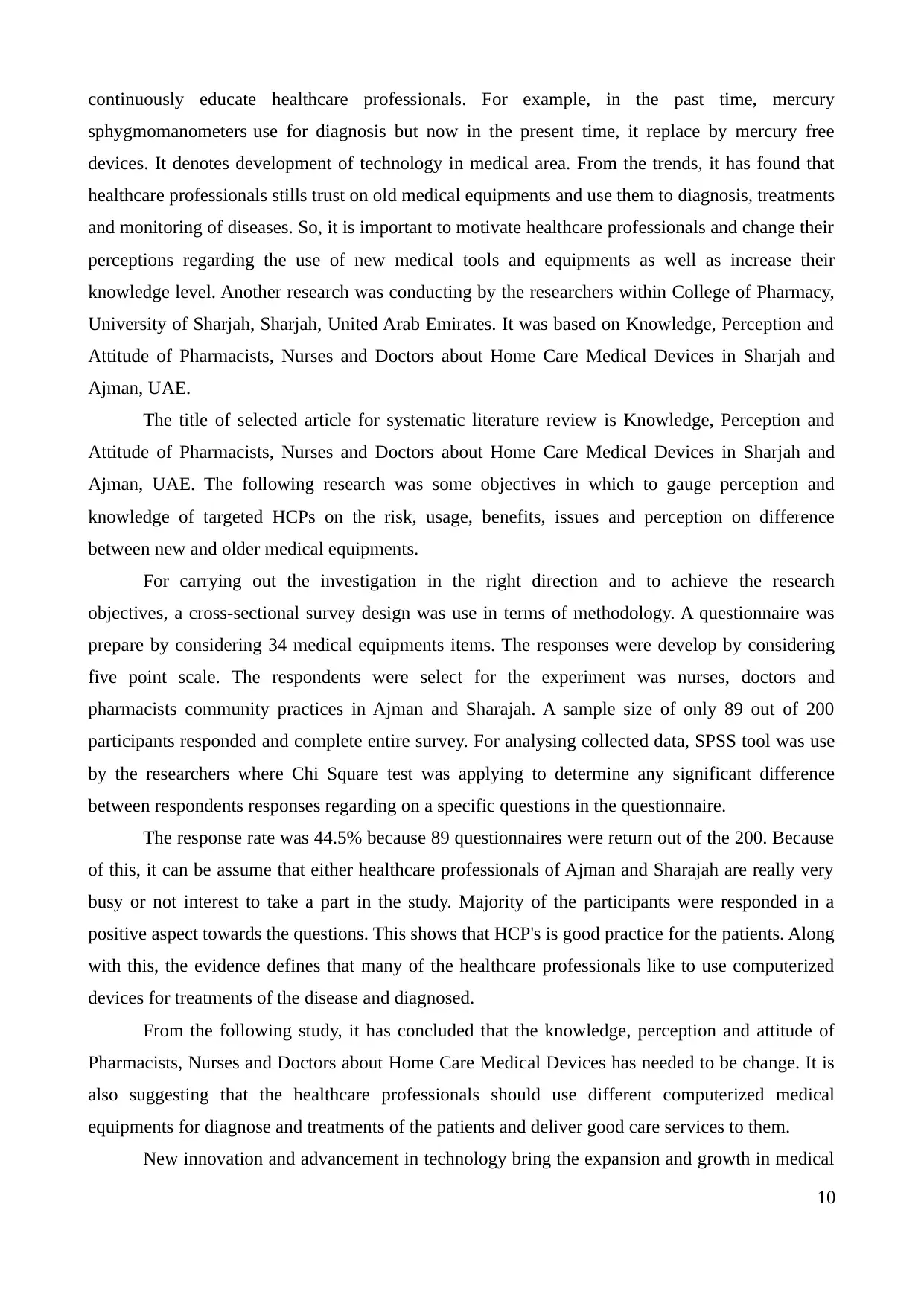
continuously educate healthcare professionals. For example, in the past time, mercury
sphygmomanometers use for diagnosis but now in the present time, it replace by mercury free
devices. It denotes development of technology in medical area. From the trends, it has found that
healthcare professionals stills trust on old medical equipments and use them to diagnosis, treatments
and monitoring of diseases. So, it is important to motivate healthcare professionals and change their
perceptions regarding the use of new medical tools and equipments as well as increase their
knowledge level. Another research was conducting by the researchers within College of Pharmacy,
University of Sharjah, Sharjah, United Arab Emirates. It was based on Knowledge, Perception and
Attitude of Pharmacists, Nurses and Doctors about Home Care Medical Devices in Sharjah and
Ajman, UAE.
The title of selected article for systematic literature review is Knowledge, Perception and
Attitude of Pharmacists, Nurses and Doctors about Home Care Medical Devices in Sharjah and
Ajman, UAE. The following research was some objectives in which to gauge perception and
knowledge of targeted HCPs on the risk, usage, benefits, issues and perception on difference
between new and older medical equipments.
For carrying out the investigation in the right direction and to achieve the research
objectives, a cross-sectional survey design was use in terms of methodology. A questionnaire was
prepare by considering 34 medical equipments items. The responses were develop by considering
five point scale. The respondents were select for the experiment was nurses, doctors and
pharmacists community practices in Ajman and Sharajah. A sample size of only 89 out of 200
participants responded and complete entire survey. For analysing collected data, SPSS tool was use
by the researchers where Chi Square test was applying to determine any significant difference
between respondents responses regarding on a specific questions in the questionnaire.
The response rate was 44.5% because 89 questionnaires were return out of the 200. Because
of this, it can be assume that either healthcare professionals of Ajman and Sharajah are really very
busy or not interest to take a part in the study. Majority of the participants were responded in a
positive aspect towards the questions. This shows that HCP's is good practice for the patients. Along
with this, the evidence defines that many of the healthcare professionals like to use computerized
devices for treatments of the disease and diagnosed.
From the following study, it has concluded that the knowledge, perception and attitude of
Pharmacists, Nurses and Doctors about Home Care Medical Devices has needed to be change. It is
also suggesting that the healthcare professionals should use different computerized medical
equipments for diagnose and treatments of the patients and deliver good care services to them.
New innovation and advancement in technology bring the expansion and growth in medical
10
sphygmomanometers use for diagnosis but now in the present time, it replace by mercury free
devices. It denotes development of technology in medical area. From the trends, it has found that
healthcare professionals stills trust on old medical equipments and use them to diagnosis, treatments
and monitoring of diseases. So, it is important to motivate healthcare professionals and change their
perceptions regarding the use of new medical tools and equipments as well as increase their
knowledge level. Another research was conducting by the researchers within College of Pharmacy,
University of Sharjah, Sharjah, United Arab Emirates. It was based on Knowledge, Perception and
Attitude of Pharmacists, Nurses and Doctors about Home Care Medical Devices in Sharjah and
Ajman, UAE.
The title of selected article for systematic literature review is Knowledge, Perception and
Attitude of Pharmacists, Nurses and Doctors about Home Care Medical Devices in Sharjah and
Ajman, UAE. The following research was some objectives in which to gauge perception and
knowledge of targeted HCPs on the risk, usage, benefits, issues and perception on difference
between new and older medical equipments.
For carrying out the investigation in the right direction and to achieve the research
objectives, a cross-sectional survey design was use in terms of methodology. A questionnaire was
prepare by considering 34 medical equipments items. The responses were develop by considering
five point scale. The respondents were select for the experiment was nurses, doctors and
pharmacists community practices in Ajman and Sharajah. A sample size of only 89 out of 200
participants responded and complete entire survey. For analysing collected data, SPSS tool was use
by the researchers where Chi Square test was applying to determine any significant difference
between respondents responses regarding on a specific questions in the questionnaire.
The response rate was 44.5% because 89 questionnaires were return out of the 200. Because
of this, it can be assume that either healthcare professionals of Ajman and Sharajah are really very
busy or not interest to take a part in the study. Majority of the participants were responded in a
positive aspect towards the questions. This shows that HCP's is good practice for the patients. Along
with this, the evidence defines that many of the healthcare professionals like to use computerized
devices for treatments of the disease and diagnosed.
From the following study, it has concluded that the knowledge, perception and attitude of
Pharmacists, Nurses and Doctors about Home Care Medical Devices has needed to be change. It is
also suggesting that the healthcare professionals should use different computerized medical
equipments for diagnose and treatments of the patients and deliver good care services to them.
New innovation and advancement in technology bring the expansion and growth in medical
10
Secure Best Marks with AI Grader
Need help grading? Try our AI Grader for instant feedback on your assignments.
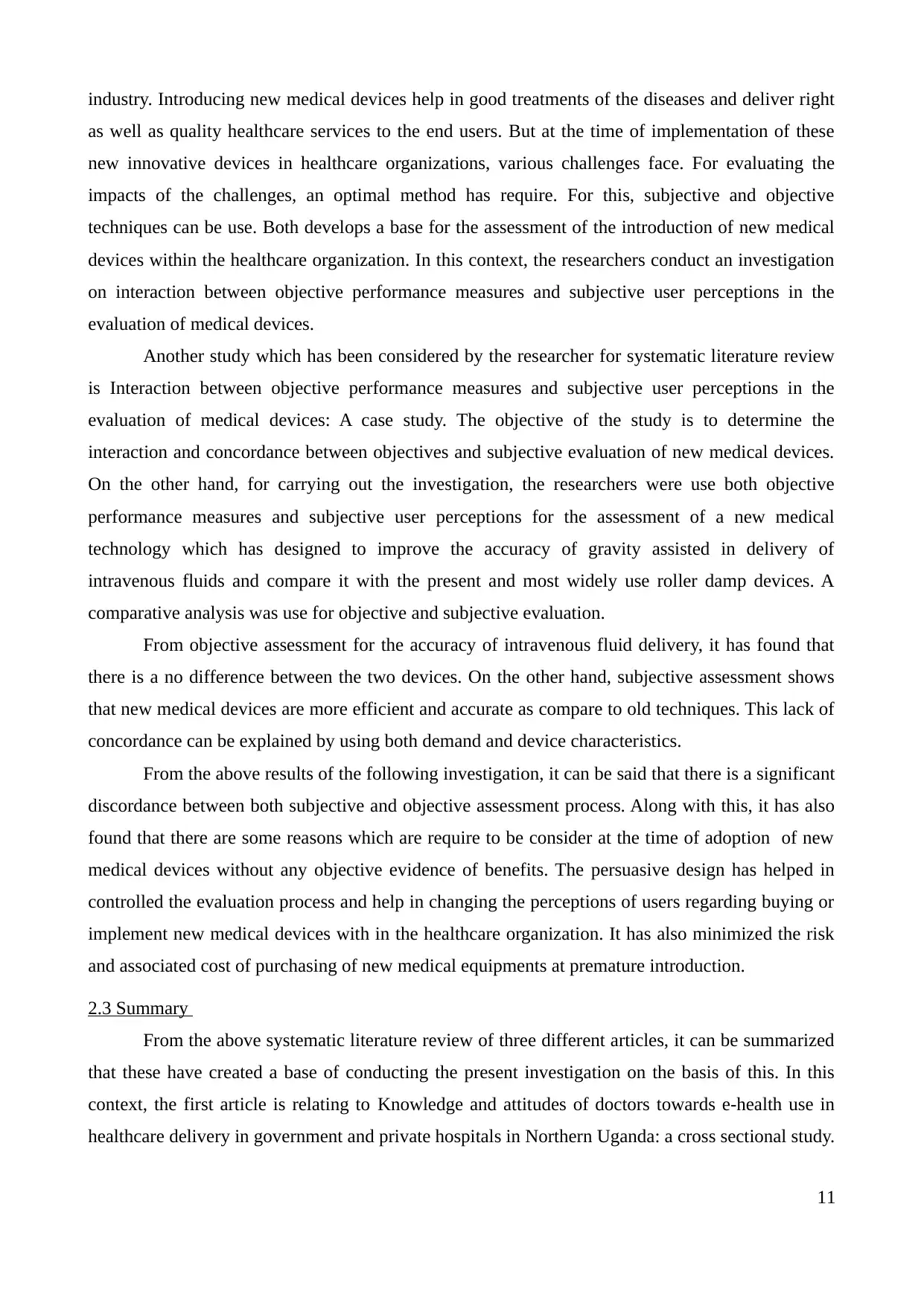
industry. Introducing new medical devices help in good treatments of the diseases and deliver right
as well as quality healthcare services to the end users. But at the time of implementation of these
new innovative devices in healthcare organizations, various challenges face. For evaluating the
impacts of the challenges, an optimal method has require. For this, subjective and objective
techniques can be use. Both develops a base for the assessment of the introduction of new medical
devices within the healthcare organization. In this context, the researchers conduct an investigation
on interaction between objective performance measures and subjective user perceptions in the
evaluation of medical devices.
Another study which has been considered by the researcher for systematic literature review
is Interaction between objective performance measures and subjective user perceptions in the
evaluation of medical devices: A case study. The objective of the study is to determine the
interaction and concordance between objectives and subjective evaluation of new medical devices.
On the other hand, for carrying out the investigation, the researchers were use both objective
performance measures and subjective user perceptions for the assessment of a new medical
technology which has designed to improve the accuracy of gravity assisted in delivery of
intravenous fluids and compare it with the present and most widely use roller damp devices. A
comparative analysis was use for objective and subjective evaluation.
From objective assessment for the accuracy of intravenous fluid delivery, it has found that
there is a no difference between the two devices. On the other hand, subjective assessment shows
that new medical devices are more efficient and accurate as compare to old techniques. This lack of
concordance can be explained by using both demand and device characteristics.
From the above results of the following investigation, it can be said that there is a significant
discordance between both subjective and objective assessment process. Along with this, it has also
found that there are some reasons which are require to be consider at the time of adoption of new
medical devices without any objective evidence of benefits. The persuasive design has helped in
controlled the evaluation process and help in changing the perceptions of users regarding buying or
implement new medical devices with in the healthcare organization. It has also minimized the risk
and associated cost of purchasing of new medical equipments at premature introduction.
2.3 Summary
From the above systematic literature review of three different articles, it can be summarized
that these have created a base of conducting the present investigation on the basis of this. In this
context, the first article is relating to Knowledge and attitudes of doctors towards e-health use in
healthcare delivery in government and private hospitals in Northern Uganda: a cross sectional study.
11
as well as quality healthcare services to the end users. But at the time of implementation of these
new innovative devices in healthcare organizations, various challenges face. For evaluating the
impacts of the challenges, an optimal method has require. For this, subjective and objective
techniques can be use. Both develops a base for the assessment of the introduction of new medical
devices within the healthcare organization. In this context, the researchers conduct an investigation
on interaction between objective performance measures and subjective user perceptions in the
evaluation of medical devices.
Another study which has been considered by the researcher for systematic literature review
is Interaction between objective performance measures and subjective user perceptions in the
evaluation of medical devices: A case study. The objective of the study is to determine the
interaction and concordance between objectives and subjective evaluation of new medical devices.
On the other hand, for carrying out the investigation, the researchers were use both objective
performance measures and subjective user perceptions for the assessment of a new medical
technology which has designed to improve the accuracy of gravity assisted in delivery of
intravenous fluids and compare it with the present and most widely use roller damp devices. A
comparative analysis was use for objective and subjective evaluation.
From objective assessment for the accuracy of intravenous fluid delivery, it has found that
there is a no difference between the two devices. On the other hand, subjective assessment shows
that new medical devices are more efficient and accurate as compare to old techniques. This lack of
concordance can be explained by using both demand and device characteristics.
From the above results of the following investigation, it can be said that there is a significant
discordance between both subjective and objective assessment process. Along with this, it has also
found that there are some reasons which are require to be consider at the time of adoption of new
medical devices without any objective evidence of benefits. The persuasive design has helped in
controlled the evaluation process and help in changing the perceptions of users regarding buying or
implement new medical devices with in the healthcare organization. It has also minimized the risk
and associated cost of purchasing of new medical equipments at premature introduction.
2.3 Summary
From the above systematic literature review of three different articles, it can be summarized
that these have created a base of conducting the present investigation on the basis of this. In this
context, the first article is relating to Knowledge and attitudes of doctors towards e-health use in
healthcare delivery in government and private hospitals in Northern Uganda: a cross sectional study.
11
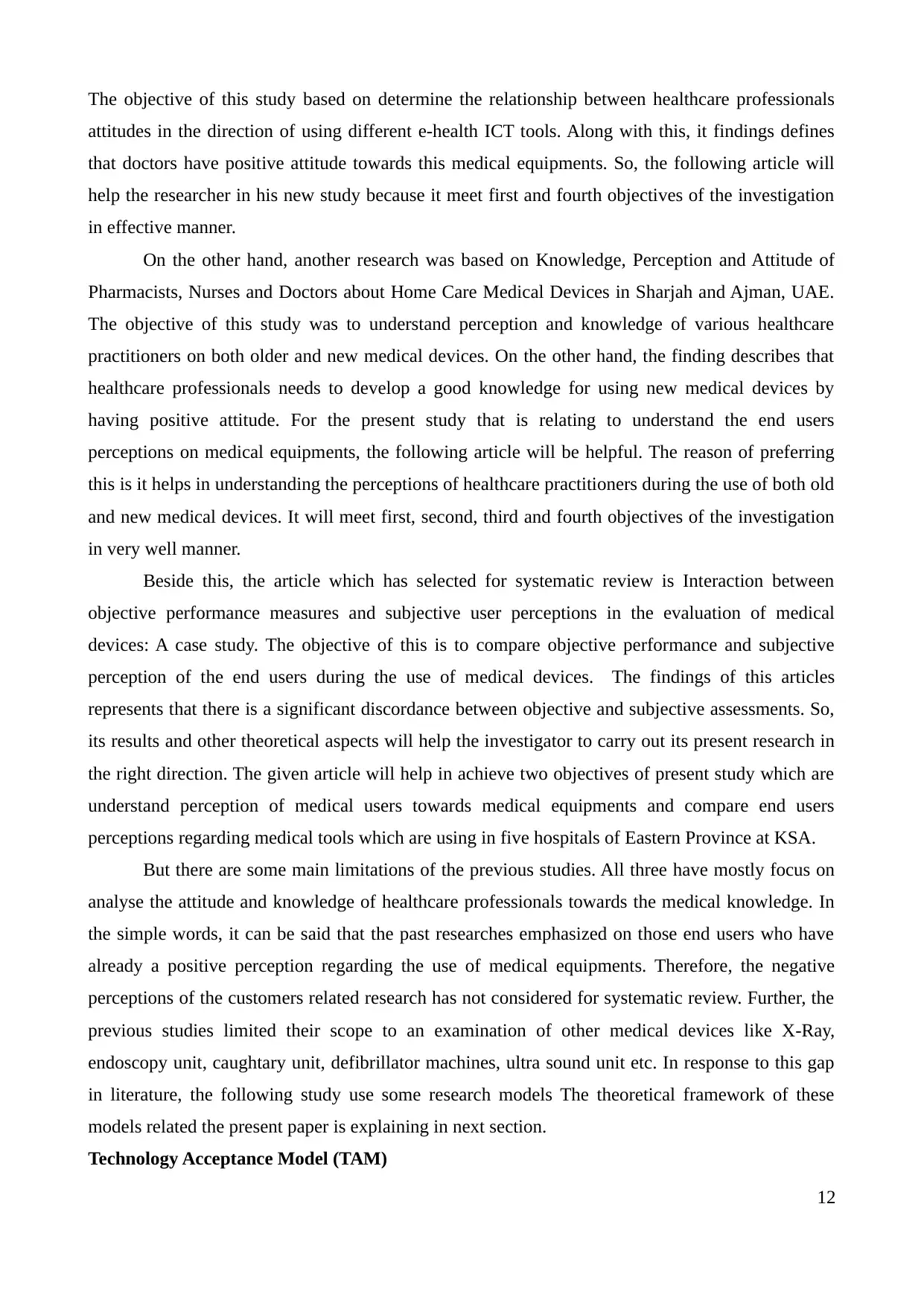
The objective of this study based on determine the relationship between healthcare professionals
attitudes in the direction of using different e-health ICT tools. Along with this, it findings defines
that doctors have positive attitude towards this medical equipments. So, the following article will
help the researcher in his new study because it meet first and fourth objectives of the investigation
in effective manner.
On the other hand, another research was based on Knowledge, Perception and Attitude of
Pharmacists, Nurses and Doctors about Home Care Medical Devices in Sharjah and Ajman, UAE.
The objective of this study was to understand perception and knowledge of various healthcare
practitioners on both older and new medical devices. On the other hand, the finding describes that
healthcare professionals needs to develop a good knowledge for using new medical devices by
having positive attitude. For the present study that is relating to understand the end users
perceptions on medical equipments, the following article will be helpful. The reason of preferring
this is it helps in understanding the perceptions of healthcare practitioners during the use of both old
and new medical devices. It will meet first, second, third and fourth objectives of the investigation
in very well manner.
Beside this, the article which has selected for systematic review is Interaction between
objective performance measures and subjective user perceptions in the evaluation of medical
devices: A case study. The objective of this is to compare objective performance and subjective
perception of the end users during the use of medical devices. The findings of this articles
represents that there is a significant discordance between objective and subjective assessments. So,
its results and other theoretical aspects will help the investigator to carry out its present research in
the right direction. The given article will help in achieve two objectives of present study which are
understand perception of medical users towards medical equipments and compare end users
perceptions regarding medical tools which are using in five hospitals of Eastern Province at KSA.
But there are some main limitations of the previous studies. All three have mostly focus on
analyse the attitude and knowledge of healthcare professionals towards the medical knowledge. In
the simple words, it can be said that the past researches emphasized on those end users who have
already a positive perception regarding the use of medical equipments. Therefore, the negative
perceptions of the customers related research has not considered for systematic review. Further, the
previous studies limited their scope to an examination of other medical devices like X-Ray,
endoscopy unit, caughtary unit, defibrillator machines, ultra sound unit etc. In response to this gap
in literature, the following study use some research models The theoretical framework of these
models related the present paper is explaining in next section.
Technology Acceptance Model (TAM)
12
attitudes in the direction of using different e-health ICT tools. Along with this, it findings defines
that doctors have positive attitude towards this medical equipments. So, the following article will
help the researcher in his new study because it meet first and fourth objectives of the investigation
in effective manner.
On the other hand, another research was based on Knowledge, Perception and Attitude of
Pharmacists, Nurses and Doctors about Home Care Medical Devices in Sharjah and Ajman, UAE.
The objective of this study was to understand perception and knowledge of various healthcare
practitioners on both older and new medical devices. On the other hand, the finding describes that
healthcare professionals needs to develop a good knowledge for using new medical devices by
having positive attitude. For the present study that is relating to understand the end users
perceptions on medical equipments, the following article will be helpful. The reason of preferring
this is it helps in understanding the perceptions of healthcare practitioners during the use of both old
and new medical devices. It will meet first, second, third and fourth objectives of the investigation
in very well manner.
Beside this, the article which has selected for systematic review is Interaction between
objective performance measures and subjective user perceptions in the evaluation of medical
devices: A case study. The objective of this is to compare objective performance and subjective
perception of the end users during the use of medical devices. The findings of this articles
represents that there is a significant discordance between objective and subjective assessments. So,
its results and other theoretical aspects will help the investigator to carry out its present research in
the right direction. The given article will help in achieve two objectives of present study which are
understand perception of medical users towards medical equipments and compare end users
perceptions regarding medical tools which are using in five hospitals of Eastern Province at KSA.
But there are some main limitations of the previous studies. All three have mostly focus on
analyse the attitude and knowledge of healthcare professionals towards the medical knowledge. In
the simple words, it can be said that the past researches emphasized on those end users who have
already a positive perception regarding the use of medical equipments. Therefore, the negative
perceptions of the customers related research has not considered for systematic review. Further, the
previous studies limited their scope to an examination of other medical devices like X-Ray,
endoscopy unit, caughtary unit, defibrillator machines, ultra sound unit etc. In response to this gap
in literature, the following study use some research models The theoretical framework of these
models related the present paper is explaining in next section.
Technology Acceptance Model (TAM)
12
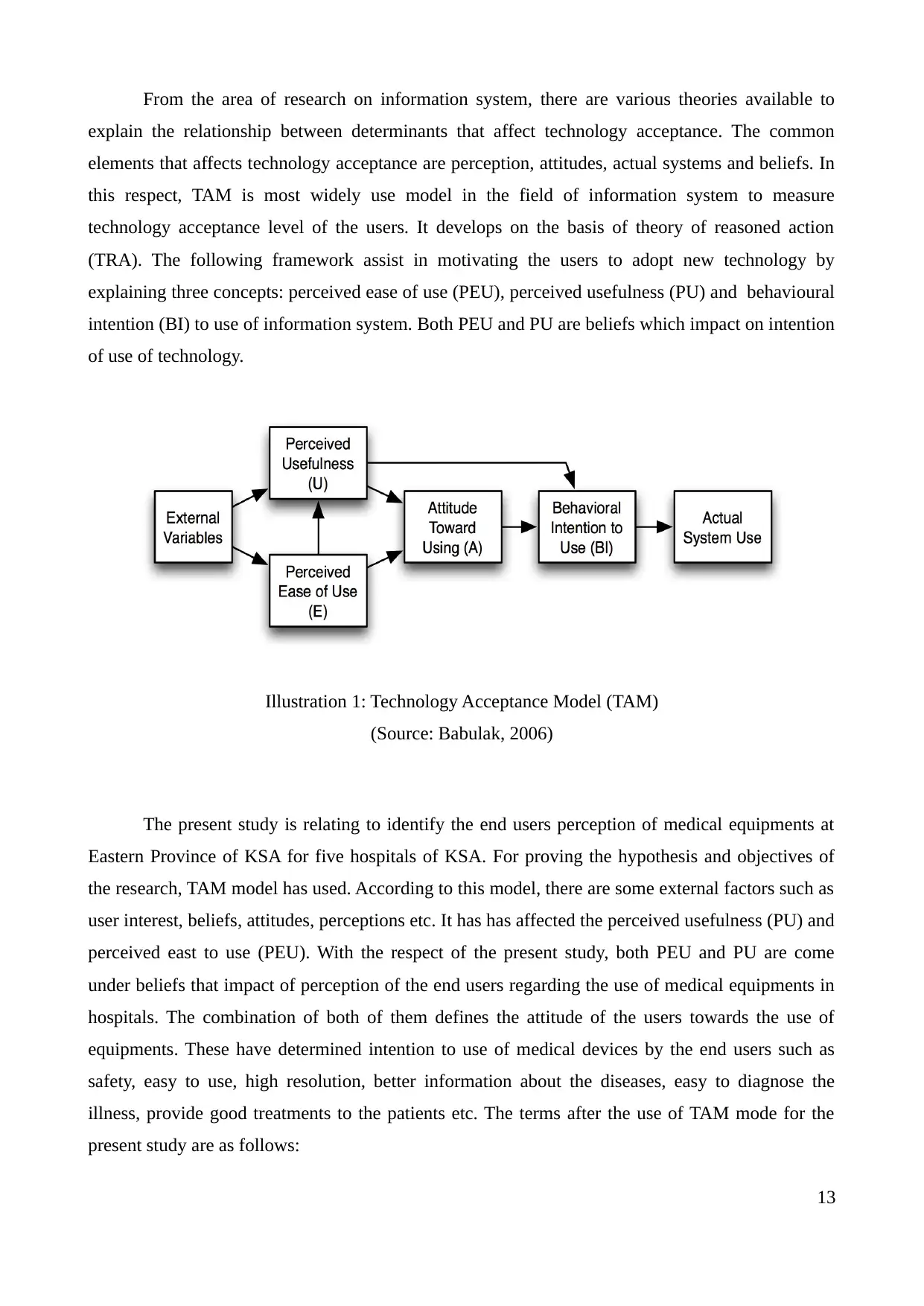
From the area of research on information system, there are various theories available to
explain the relationship between determinants that affect technology acceptance. The common
elements that affects technology acceptance are perception, attitudes, actual systems and beliefs. In
this respect, TAM is most widely use model in the field of information system to measure
technology acceptance level of the users. It develops on the basis of theory of reasoned action
(TRA). The following framework assist in motivating the users to adopt new technology by
explaining three concepts: perceived ease of use (PEU), perceived usefulness (PU) and behavioural
intention (BI) to use of information system. Both PEU and PU are beliefs which impact on intention
of use of technology.
The present study is relating to identify the end users perception of medical equipments at
Eastern Province of KSA for five hospitals of KSA. For proving the hypothesis and objectives of
the research, TAM model has used. According to this model, there are some external factors such as
user interest, beliefs, attitudes, perceptions etc. It has has affected the perceived usefulness (PU) and
perceived east to use (PEU). With the respect of the present study, both PEU and PU are come
under beliefs that impact of perception of the end users regarding the use of medical equipments in
hospitals. The combination of both of them defines the attitude of the users towards the use of
equipments. These have determined intention to use of medical devices by the end users such as
safety, easy to use, high resolution, better information about the diseases, easy to diagnose the
illness, provide good treatments to the patients etc. The terms after the use of TAM mode for the
present study are as follows:
13
Illustration 1: Technology Acceptance Model (TAM)
(Source: Babulak, 2006)
explain the relationship between determinants that affect technology acceptance. The common
elements that affects technology acceptance are perception, attitudes, actual systems and beliefs. In
this respect, TAM is most widely use model in the field of information system to measure
technology acceptance level of the users. It develops on the basis of theory of reasoned action
(TRA). The following framework assist in motivating the users to adopt new technology by
explaining three concepts: perceived ease of use (PEU), perceived usefulness (PU) and behavioural
intention (BI) to use of information system. Both PEU and PU are beliefs which impact on intention
of use of technology.
The present study is relating to identify the end users perception of medical equipments at
Eastern Province of KSA for five hospitals of KSA. For proving the hypothesis and objectives of
the research, TAM model has used. According to this model, there are some external factors such as
user interest, beliefs, attitudes, perceptions etc. It has has affected the perceived usefulness (PU) and
perceived east to use (PEU). With the respect of the present study, both PEU and PU are come
under beliefs that impact of perception of the end users regarding the use of medical equipments in
hospitals. The combination of both of them defines the attitude of the users towards the use of
equipments. These have determined intention to use of medical devices by the end users such as
safety, easy to use, high resolution, better information about the diseases, easy to diagnose the
illness, provide good treatments to the patients etc. The terms after the use of TAM mode for the
present study are as follows:
13
Illustration 1: Technology Acceptance Model (TAM)
(Source: Babulak, 2006)
Paraphrase This Document
Need a fresh take? Get an instant paraphrase of this document with our AI Paraphraser
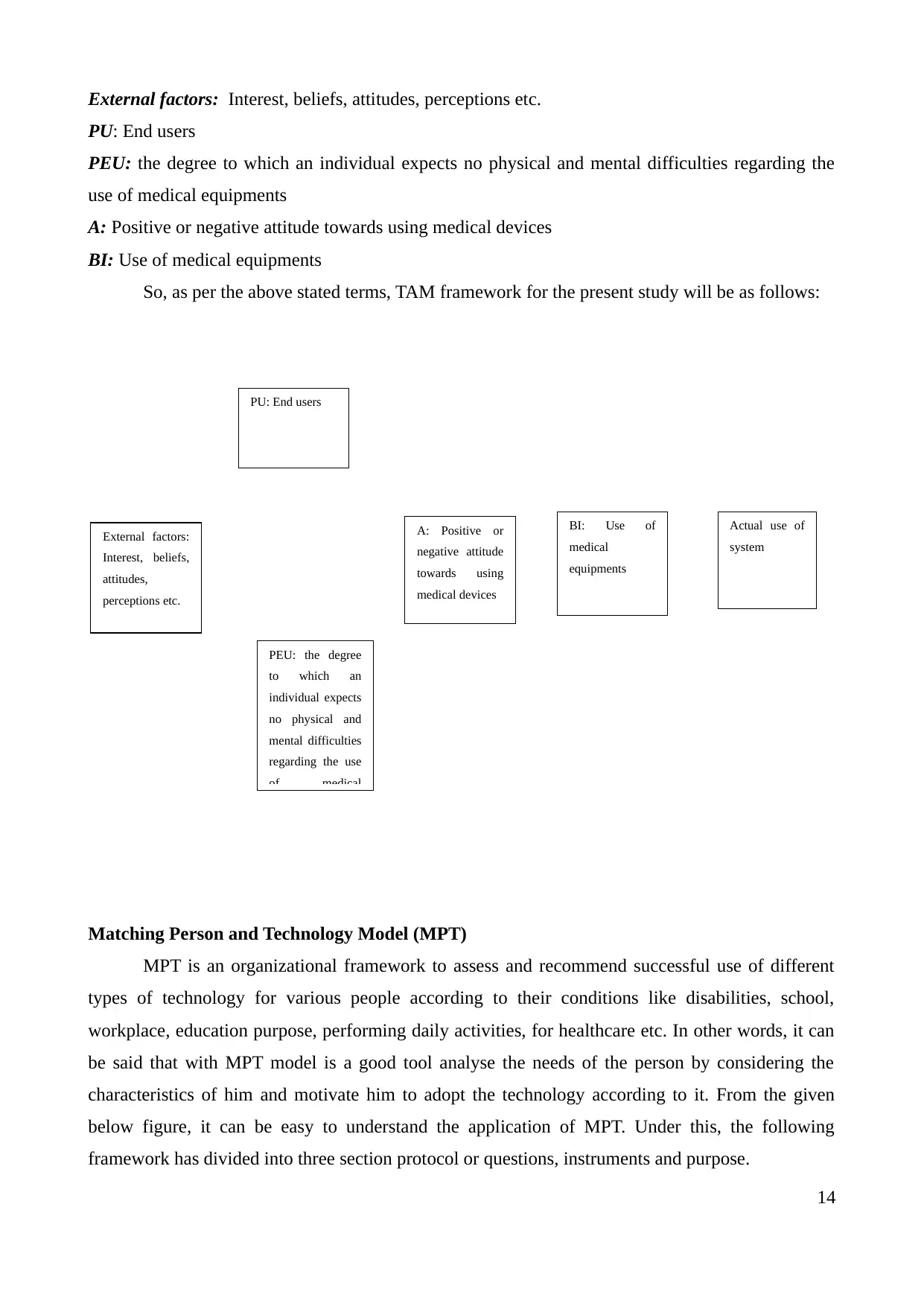
External factors: Interest, beliefs, attitudes, perceptions etc.
PU: End users
PEU: the degree to which an individual expects no physical and mental difficulties regarding the
use of medical equipments
A: Positive or negative attitude towards using medical devices
BI: Use of medical equipments
So, as per the above stated terms, TAM framework for the present study will be as follows:
Matching Person and Technology Model (MPT)
MPT is an organizational framework to assess and recommend successful use of different
types of technology for various people according to their conditions like disabilities, school,
workplace, education purpose, performing daily activities, for healthcare etc. In other words, it can
be said that with MPT model is a good tool analyse the needs of the person by considering the
characteristics of him and motivate him to adopt the technology according to it. From the given
below figure, it can be easy to understand the application of MPT. Under this, the following
framework has divided into three section protocol or questions, instruments and purpose.
14
External factors:
Interest, beliefs,
attitudes,
perceptions etc.
PU: End users
PEU: the degree
to which an
individual expects
no physical and
mental difficulties
regarding the use
of medical
A: Positive or
negative attitude
towards using
medical devices
BI: Use of
medical
equipments
Actual use of
system
PU: End users
PEU: the degree to which an individual expects no physical and mental difficulties regarding the
use of medical equipments
A: Positive or negative attitude towards using medical devices
BI: Use of medical equipments
So, as per the above stated terms, TAM framework for the present study will be as follows:
Matching Person and Technology Model (MPT)
MPT is an organizational framework to assess and recommend successful use of different
types of technology for various people according to their conditions like disabilities, school,
workplace, education purpose, performing daily activities, for healthcare etc. In other words, it can
be said that with MPT model is a good tool analyse the needs of the person by considering the
characteristics of him and motivate him to adopt the technology according to it. From the given
below figure, it can be easy to understand the application of MPT. Under this, the following
framework has divided into three section protocol or questions, instruments and purpose.
14
External factors:
Interest, beliefs,
attitudes,
perceptions etc.
PU: End users
PEU: the degree
to which an
individual expects
no physical and
mental difficulties
regarding the use
of medical
A: Positive or
negative attitude
towards using
medical devices
BI: Use of
medical
equipments
Actual use of
system
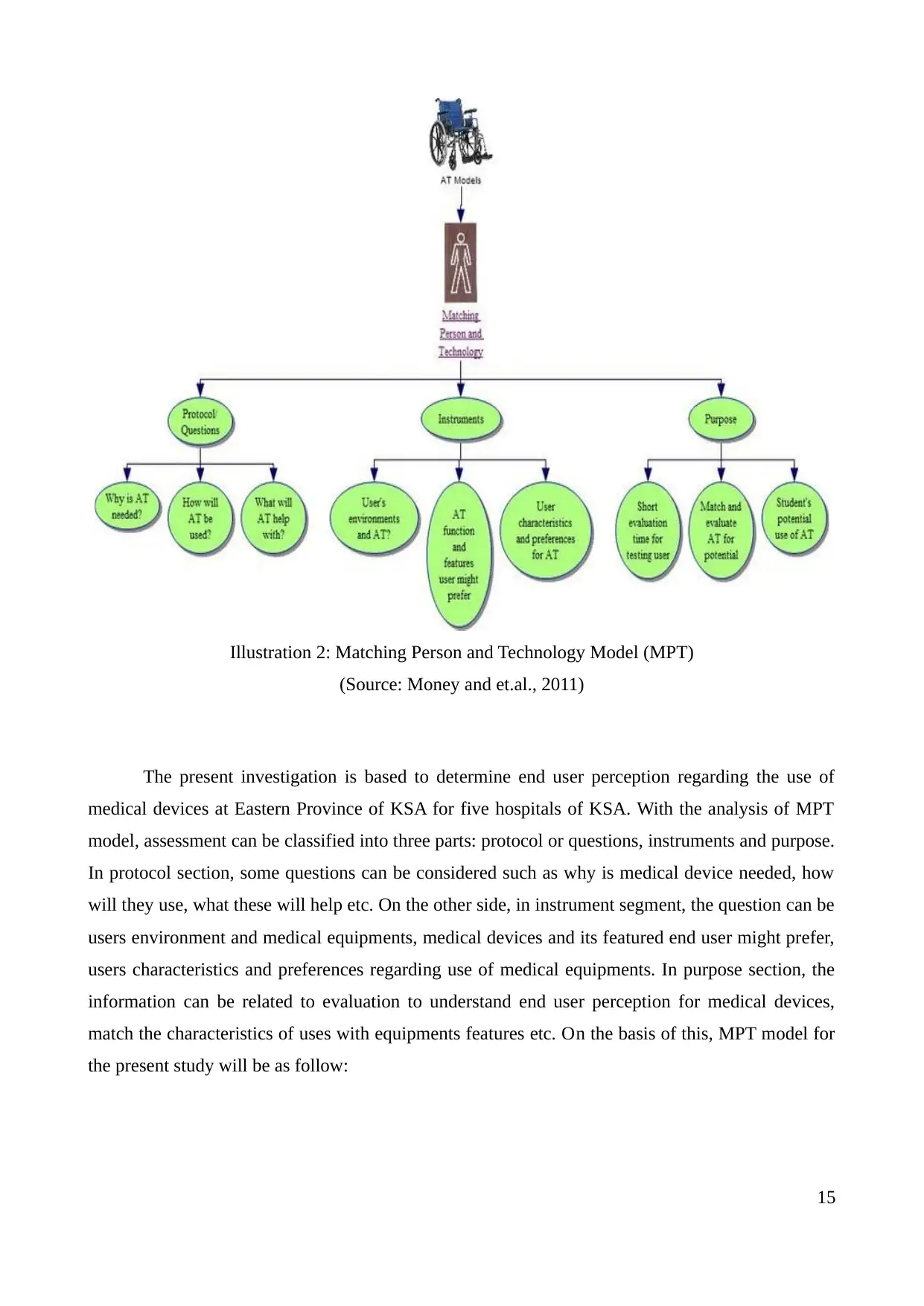
The present investigation is based to determine end user perception regarding the use of
medical devices at Eastern Province of KSA for five hospitals of KSA. With the analysis of MPT
model, assessment can be classified into three parts: protocol or questions, instruments and purpose.
In protocol section, some questions can be considered such as why is medical device needed, how
will they use, what these will help etc. On the other side, in instrument segment, the question can be
users environment and medical equipments, medical devices and its featured end user might prefer,
users characteristics and preferences regarding use of medical equipments. In purpose section, the
information can be related to evaluation to understand end user perception for medical devices,
match the characteristics of uses with equipments features etc. On the basis of this, MPT model for
the present study will be as follow:
15
Illustration 2: Matching Person and Technology Model (MPT)
(Source: Money and et.al., 2011)
medical devices at Eastern Province of KSA for five hospitals of KSA. With the analysis of MPT
model, assessment can be classified into three parts: protocol or questions, instruments and purpose.
In protocol section, some questions can be considered such as why is medical device needed, how
will they use, what these will help etc. On the other side, in instrument segment, the question can be
users environment and medical equipments, medical devices and its featured end user might prefer,
users characteristics and preferences regarding use of medical equipments. In purpose section, the
information can be related to evaluation to understand end user perception for medical devices,
match the characteristics of uses with equipments features etc. On the basis of this, MPT model for
the present study will be as follow:
15
Illustration 2: Matching Person and Technology Model (MPT)
(Source: Money and et.al., 2011)
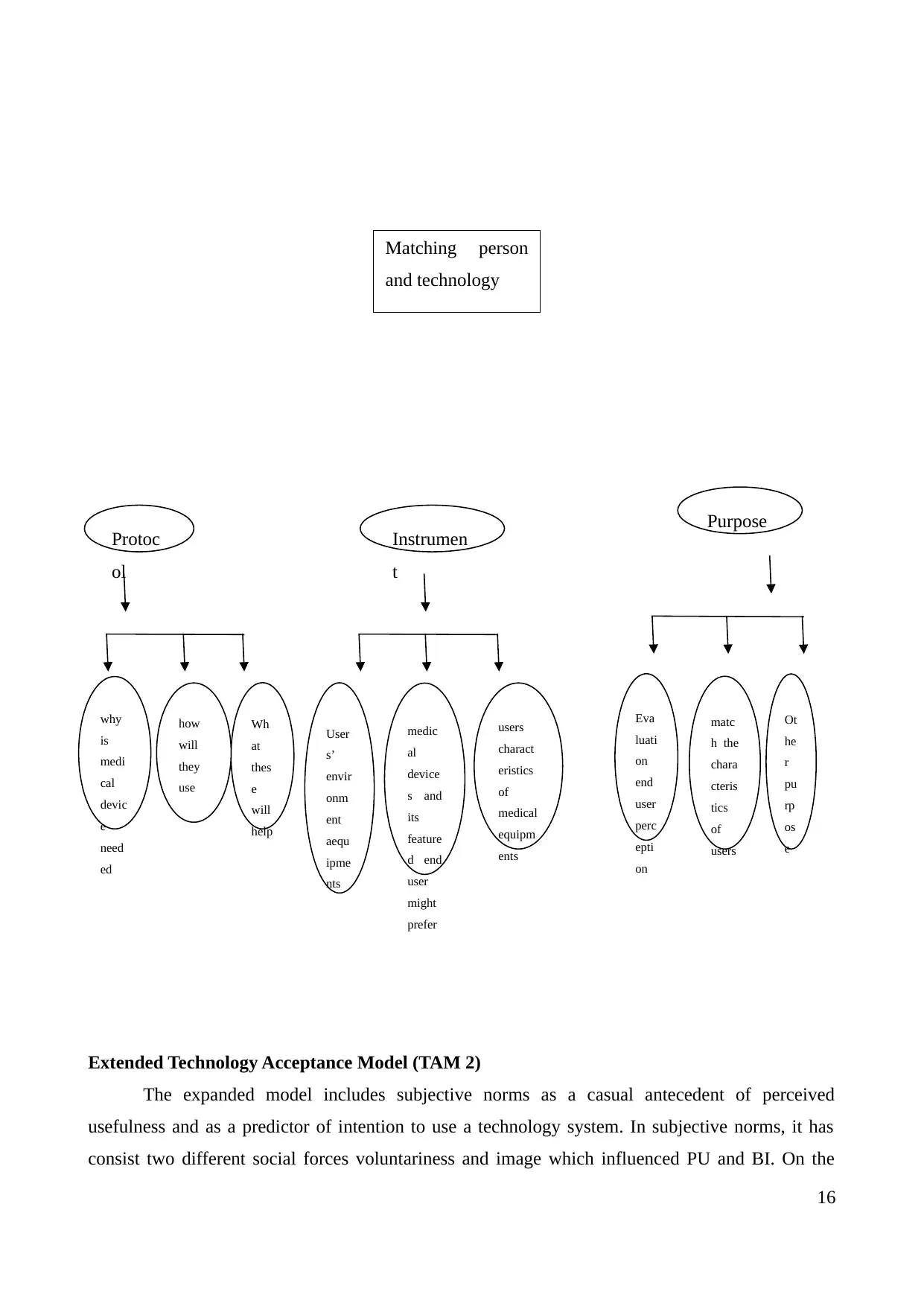
Extended Technology Acceptance Model (TAM 2)
The expanded model includes subjective norms as a casual antecedent of perceived
usefulness and as a predictor of intention to use a technology system. In subjective norms, it has
consist two different social forces voluntariness and image which influenced PU and BI. On the
16
Matching person
and technology
Protoc
ol
Instrumen
t
Purpose
User
s’
envir
onm
ent
aequ
ipme
nts
matc
h the
chara
cteris
tics
of
users
Eva
luati
on
end
user
perc
epti
on
Ot
he
r
pu
rp
os
e
medic
al
device
s and
its
feature
d end
user
might
prefer
users
charact
eristics
of
medical
equipm
ents
Wh
at
thes
e
will
help
how
will
they
use
why
is
medi
cal
devic
e
need
ed
The expanded model includes subjective norms as a casual antecedent of perceived
usefulness and as a predictor of intention to use a technology system. In subjective norms, it has
consist two different social forces voluntariness and image which influenced PU and BI. On the
16
Matching person
and technology
Protoc
ol
Instrumen
t
Purpose
User
s’
envir
onm
ent
aequ
ipme
nts
matc
h the
chara
cteris
tics
of
users
Eva
luati
on
end
user
perc
epti
on
Ot
he
r
pu
rp
os
e
medic
al
device
s and
its
feature
d end
user
might
prefer
users
charact
eristics
of
medical
equipm
ents
Wh
at
thes
e
will
help
how
will
they
use
why
is
medi
cal
devic
e
need
ed
Secure Best Marks with AI Grader
Need help grading? Try our AI Grader for instant feedback on your assignments.
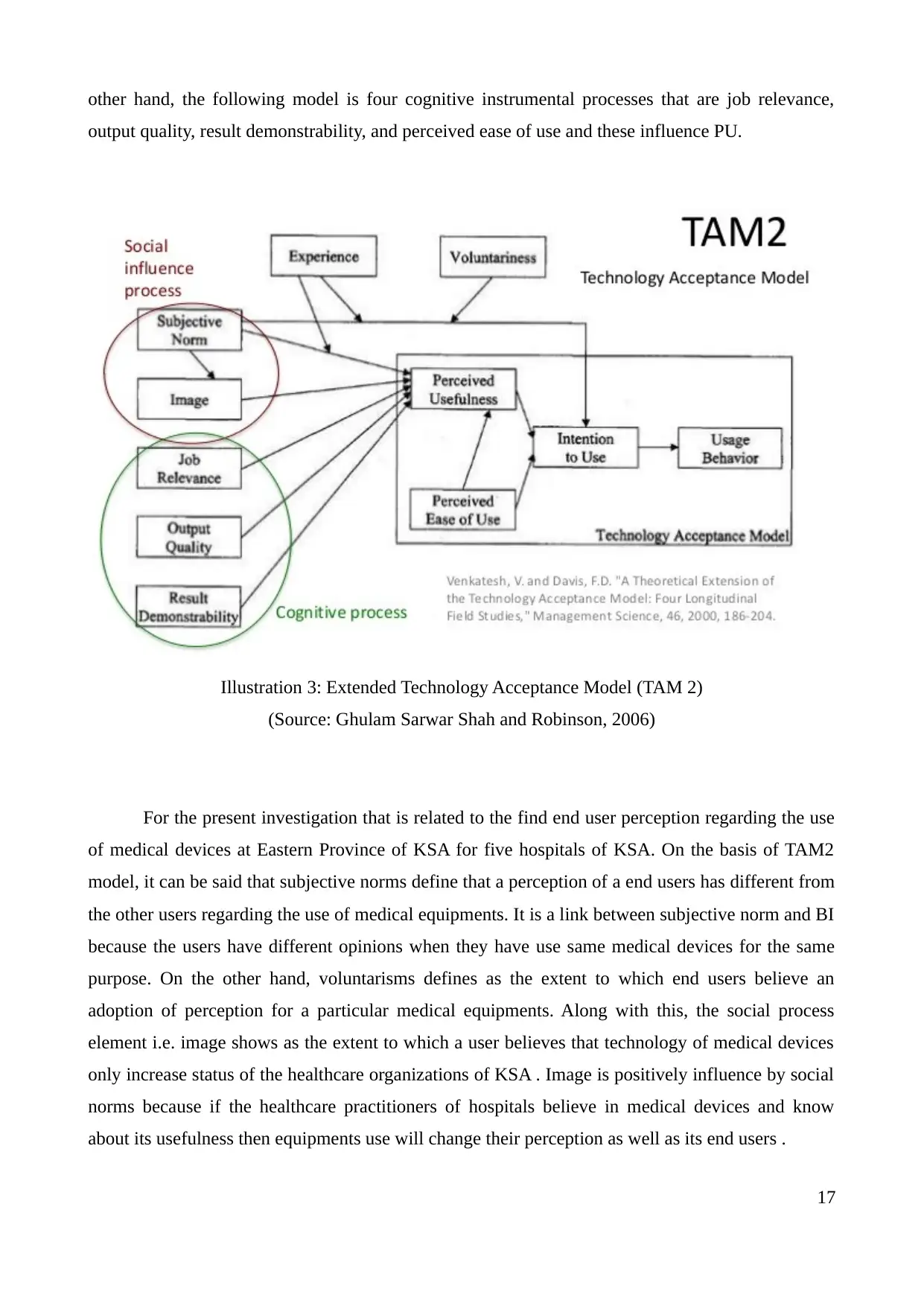
other hand, the following model is four cognitive instrumental processes that are job relevance,
output quality, result demonstrability, and perceived ease of use and these influence PU.
For the present investigation that is related to the find end user perception regarding the use
of medical devices at Eastern Province of KSA for five hospitals of KSA. On the basis of TAM2
model, it can be said that subjective norms define that a perception of a end users has different from
the other users regarding the use of medical equipments. It is a link between subjective norm and BI
because the users have different opinions when they have use same medical devices for the same
purpose. On the other hand, voluntarisms defines as the extent to which end users believe an
adoption of perception for a particular medical equipments. Along with this, the social process
element i.e. image shows as the extent to which a user believes that technology of medical devices
only increase status of the healthcare organizations of KSA . Image is positively influence by social
norms because if the healthcare practitioners of hospitals believe in medical devices and know
about its usefulness then equipments use will change their perception as well as its end users .
17
Illustration 3: Extended Technology Acceptance Model (TAM 2)
(Source: Ghulam Sarwar Shah and Robinson, 2006)
output quality, result demonstrability, and perceived ease of use and these influence PU.
For the present investigation that is related to the find end user perception regarding the use
of medical devices at Eastern Province of KSA for five hospitals of KSA. On the basis of TAM2
model, it can be said that subjective norms define that a perception of a end users has different from
the other users regarding the use of medical equipments. It is a link between subjective norm and BI
because the users have different opinions when they have use same medical devices for the same
purpose. On the other hand, voluntarisms defines as the extent to which end users believe an
adoption of perception for a particular medical equipments. Along with this, the social process
element i.e. image shows as the extent to which a user believes that technology of medical devices
only increase status of the healthcare organizations of KSA . Image is positively influence by social
norms because if the healthcare practitioners of hospitals believe in medical devices and know
about its usefulness then equipments use will change their perception as well as its end users .
17
Illustration 3: Extended Technology Acceptance Model (TAM 2)
(Source: Ghulam Sarwar Shah and Robinson, 2006)

18
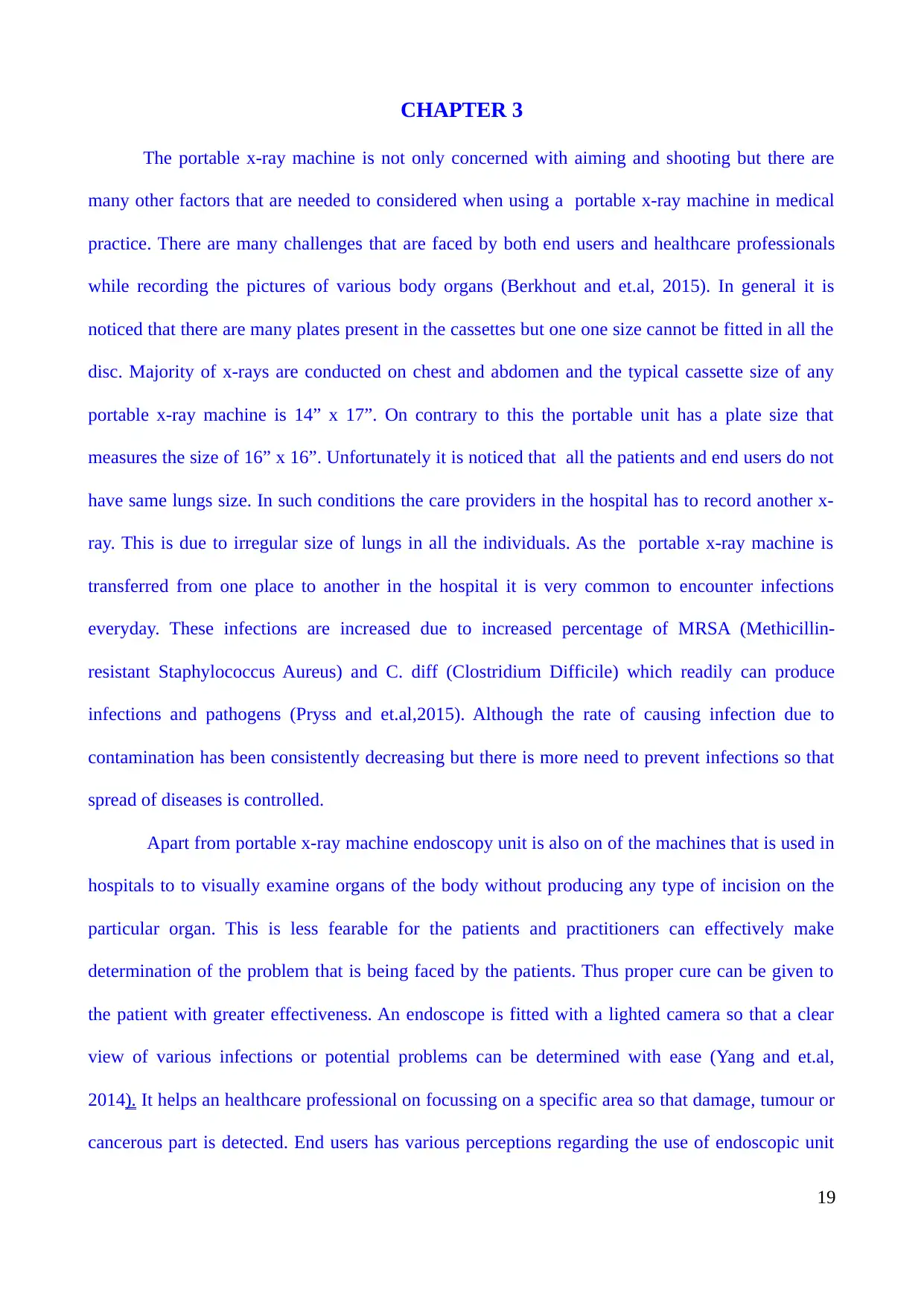
CHAPTER 3
The portable x-ray machine is not only concerned with aiming and shooting but there are
many other factors that are needed to considered when using a portable x-ray machine in medical
practice. There are many challenges that are faced by both end users and healthcare professionals
while recording the pictures of various body organs (Berkhout and et.al, 2015). In general it is
noticed that there are many plates present in the cassettes but one one size cannot be fitted in all the
disc. Majority of x-rays are conducted on chest and abdomen and the typical cassette size of any
portable x-ray machine is 14” x 17”. On contrary to this the portable unit has a plate size that
measures the size of 16” x 16”. Unfortunately it is noticed that all the patients and end users do not
have same lungs size. In such conditions the care providers in the hospital has to record another x-
ray. This is due to irregular size of lungs in all the individuals. As the portable x-ray machine is
transferred from one place to another in the hospital it is very common to encounter infections
everyday. These infections are increased due to increased percentage of MRSA (Methicillin-
resistant Staphylococcus Aureus) and C. diff (Clostridium Difficile) which readily can produce
infections and pathogens (Pryss and et.al,2015). Although the rate of causing infection due to
contamination has been consistently decreasing but there is more need to prevent infections so that
spread of diseases is controlled.
Apart from portable x-ray machine endoscopy unit is also on of the machines that is used in
hospitals to to visually examine organs of the body without producing any type of incision on the
particular organ. This is less fearable for the patients and practitioners can effectively make
determination of the problem that is being faced by the patients. Thus proper cure can be given to
the patient with greater effectiveness. An endoscope is fitted with a lighted camera so that a clear
view of various infections or potential problems can be determined with ease (Yang and et.al,
2014). It helps an healthcare professional on focussing on a specific area so that damage, tumour or
cancerous part is detected. End users has various perceptions regarding the use of endoscopic unit
19
The portable x-ray machine is not only concerned with aiming and shooting but there are
many other factors that are needed to considered when using a portable x-ray machine in medical
practice. There are many challenges that are faced by both end users and healthcare professionals
while recording the pictures of various body organs (Berkhout and et.al, 2015). In general it is
noticed that there are many plates present in the cassettes but one one size cannot be fitted in all the
disc. Majority of x-rays are conducted on chest and abdomen and the typical cassette size of any
portable x-ray machine is 14” x 17”. On contrary to this the portable unit has a plate size that
measures the size of 16” x 16”. Unfortunately it is noticed that all the patients and end users do not
have same lungs size. In such conditions the care providers in the hospital has to record another x-
ray. This is due to irregular size of lungs in all the individuals. As the portable x-ray machine is
transferred from one place to another in the hospital it is very common to encounter infections
everyday. These infections are increased due to increased percentage of MRSA (Methicillin-
resistant Staphylococcus Aureus) and C. diff (Clostridium Difficile) which readily can produce
infections and pathogens (Pryss and et.al,2015). Although the rate of causing infection due to
contamination has been consistently decreasing but there is more need to prevent infections so that
spread of diseases is controlled.
Apart from portable x-ray machine endoscopy unit is also on of the machines that is used in
hospitals to to visually examine organs of the body without producing any type of incision on the
particular organ. This is less fearable for the patients and practitioners can effectively make
determination of the problem that is being faced by the patients. Thus proper cure can be given to
the patient with greater effectiveness. An endoscope is fitted with a lighted camera so that a clear
view of various infections or potential problems can be determined with ease (Yang and et.al,
2014). It helps an healthcare professional on focussing on a specific area so that damage, tumour or
cancerous part is detected. End users has various perceptions regarding the use of endoscopic unit
19
Paraphrase This Document
Need a fresh take? Get an instant paraphrase of this document with our AI Paraphraser
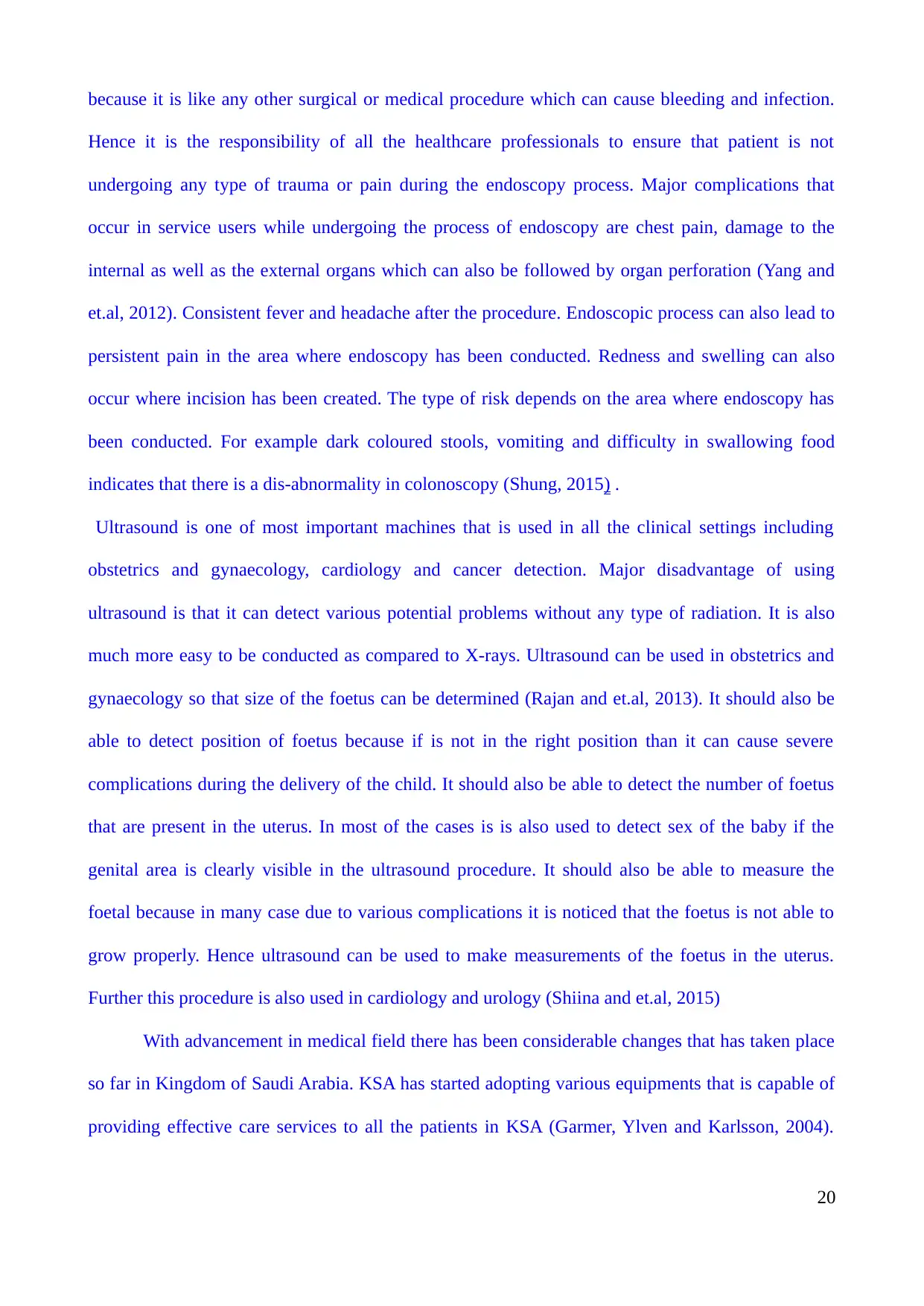
because it is like any other surgical or medical procedure which can cause bleeding and infection.
Hence it is the responsibility of all the healthcare professionals to ensure that patient is not
undergoing any type of trauma or pain during the endoscopy process. Major complications that
occur in service users while undergoing the process of endoscopy are chest pain, damage to the
internal as well as the external organs which can also be followed by organ perforation (Yang and
et.al, 2012). Consistent fever and headache after the procedure. Endoscopic process can also lead to
persistent pain in the area where endoscopy has been conducted. Redness and swelling can also
occur where incision has been created. The type of risk depends on the area where endoscopy has
been conducted. For example dark coloured stools, vomiting and difficulty in swallowing food
indicates that there is a dis-abnormality in colonoscopy (Shung, 2015) .
Ultrasound is one of most important machines that is used in all the clinical settings including
obstetrics and gynaecology, cardiology and cancer detection. Major disadvantage of using
ultrasound is that it can detect various potential problems without any type of radiation. It is also
much more easy to be conducted as compared to X-rays. Ultrasound can be used in obstetrics and
gynaecology so that size of the foetus can be determined (Rajan and et.al, 2013). It should also be
able to detect position of foetus because if is not in the right position than it can cause severe
complications during the delivery of the child. It should also be able to detect the number of foetus
that are present in the uterus. In most of the cases is is also used to detect sex of the baby if the
genital area is clearly visible in the ultrasound procedure. It should also be able to measure the
foetal because in many case due to various complications it is noticed that the foetus is not able to
grow properly. Hence ultrasound can be used to make measurements of the foetus in the uterus.
Further this procedure is also used in cardiology and urology (Shiina and et.al, 2015)
With advancement in medical field there has been considerable changes that has taken place
so far in Kingdom of Saudi Arabia. KSA has started adopting various equipments that is capable of
providing effective care services to all the patients in KSA (Garmer, Ylven and Karlsson, 2004).
20
Hence it is the responsibility of all the healthcare professionals to ensure that patient is not
undergoing any type of trauma or pain during the endoscopy process. Major complications that
occur in service users while undergoing the process of endoscopy are chest pain, damage to the
internal as well as the external organs which can also be followed by organ perforation (Yang and
et.al, 2012). Consistent fever and headache after the procedure. Endoscopic process can also lead to
persistent pain in the area where endoscopy has been conducted. Redness and swelling can also
occur where incision has been created. The type of risk depends on the area where endoscopy has
been conducted. For example dark coloured stools, vomiting and difficulty in swallowing food
indicates that there is a dis-abnormality in colonoscopy (Shung, 2015) .
Ultrasound is one of most important machines that is used in all the clinical settings including
obstetrics and gynaecology, cardiology and cancer detection. Major disadvantage of using
ultrasound is that it can detect various potential problems without any type of radiation. It is also
much more easy to be conducted as compared to X-rays. Ultrasound can be used in obstetrics and
gynaecology so that size of the foetus can be determined (Rajan and et.al, 2013). It should also be
able to detect position of foetus because if is not in the right position than it can cause severe
complications during the delivery of the child. It should also be able to detect the number of foetus
that are present in the uterus. In most of the cases is is also used to detect sex of the baby if the
genital area is clearly visible in the ultrasound procedure. It should also be able to measure the
foetal because in many case due to various complications it is noticed that the foetus is not able to
grow properly. Hence ultrasound can be used to make measurements of the foetus in the uterus.
Further this procedure is also used in cardiology and urology (Shiina and et.al, 2015)
With advancement in medical field there has been considerable changes that has taken place
so far in Kingdom of Saudi Arabia. KSA has started adopting various equipments that is capable of
providing effective care services to all the patients in KSA (Garmer, Ylven and Karlsson, 2004).
20

The healthcare system is basically subdivided in national healthcare systems which is responsible of
providing all the basic health and medical care facilities to service users in KSA. Earlier when KSA
was not able to access various healthcare facilities they were not able to provide different services
so that diseases can be cured. But with advancement they started using major and minor surgical
and medical equipments so that they are able to diagnose different illness and abnormalities present
in various patients. In late 50s KSA did not have more number of medical staff members and
healthcare professionals which caused decline in healthcare services and facilities which were
provided to patients (Ghulam Sarwar Shah and Robinson, 2006). But in late 70s KSA started
investing it financial resources in enhancing the hospital and medical based services by purchasing
and updating new equipments and machineries. This led to enhancement in medical field and
improved the medical services. Earlier in late 50s the number of doctors and other healthcare
professionals were less than 100 and number of beds in the hospitals were not more than 75. Due to
this patients were not admitted and they had to provide them with hospice care. This decreased the
reputation of hospitals in KSA and changed the perceptions of end users who were assessing their
services.
But after the 70s the number of doctors and physicians increased to a considerable number
(Bordens and Abbott, 2002). However, the end user perceptions regarding the healthcare services
have not changed due to experience. Hence, it is required to develop a strategy which can change
the end user perceptions in a positive way so that they are able to use the healthcare services
efficiently. Various research studies have stated that earlier it was very easy to retrieve the
information about any patient from the hospital which became the issue of concern later on. This
situation was not acceptable to any of the users and patients and other service users started
developing negative perceptions about the healthcare facilities and services which was provided to
them (Csikszentmihalyi and Larson, 2014). Majority of the patients were not ready to get treated in
hospitals because the staff members were not able to provide confidentiality and privacy to all the
21
providing all the basic health and medical care facilities to service users in KSA. Earlier when KSA
was not able to access various healthcare facilities they were not able to provide different services
so that diseases can be cured. But with advancement they started using major and minor surgical
and medical equipments so that they are able to diagnose different illness and abnormalities present
in various patients. In late 50s KSA did not have more number of medical staff members and
healthcare professionals which caused decline in healthcare services and facilities which were
provided to patients (Ghulam Sarwar Shah and Robinson, 2006). But in late 70s KSA started
investing it financial resources in enhancing the hospital and medical based services by purchasing
and updating new equipments and machineries. This led to enhancement in medical field and
improved the medical services. Earlier in late 50s the number of doctors and other healthcare
professionals were less than 100 and number of beds in the hospitals were not more than 75. Due to
this patients were not admitted and they had to provide them with hospice care. This decreased the
reputation of hospitals in KSA and changed the perceptions of end users who were assessing their
services.
But after the 70s the number of doctors and physicians increased to a considerable number
(Bordens and Abbott, 2002). However, the end user perceptions regarding the healthcare services
have not changed due to experience. Hence, it is required to develop a strategy which can change
the end user perceptions in a positive way so that they are able to use the healthcare services
efficiently. Various research studies have stated that earlier it was very easy to retrieve the
information about any patient from the hospital which became the issue of concern later on. This
situation was not acceptable to any of the users and patients and other service users started
developing negative perceptions about the healthcare facilities and services which was provided to
them (Csikszentmihalyi and Larson, 2014). Majority of the patients were not ready to get treated in
hospitals because the staff members were not able to provide confidentiality and privacy to all the
21
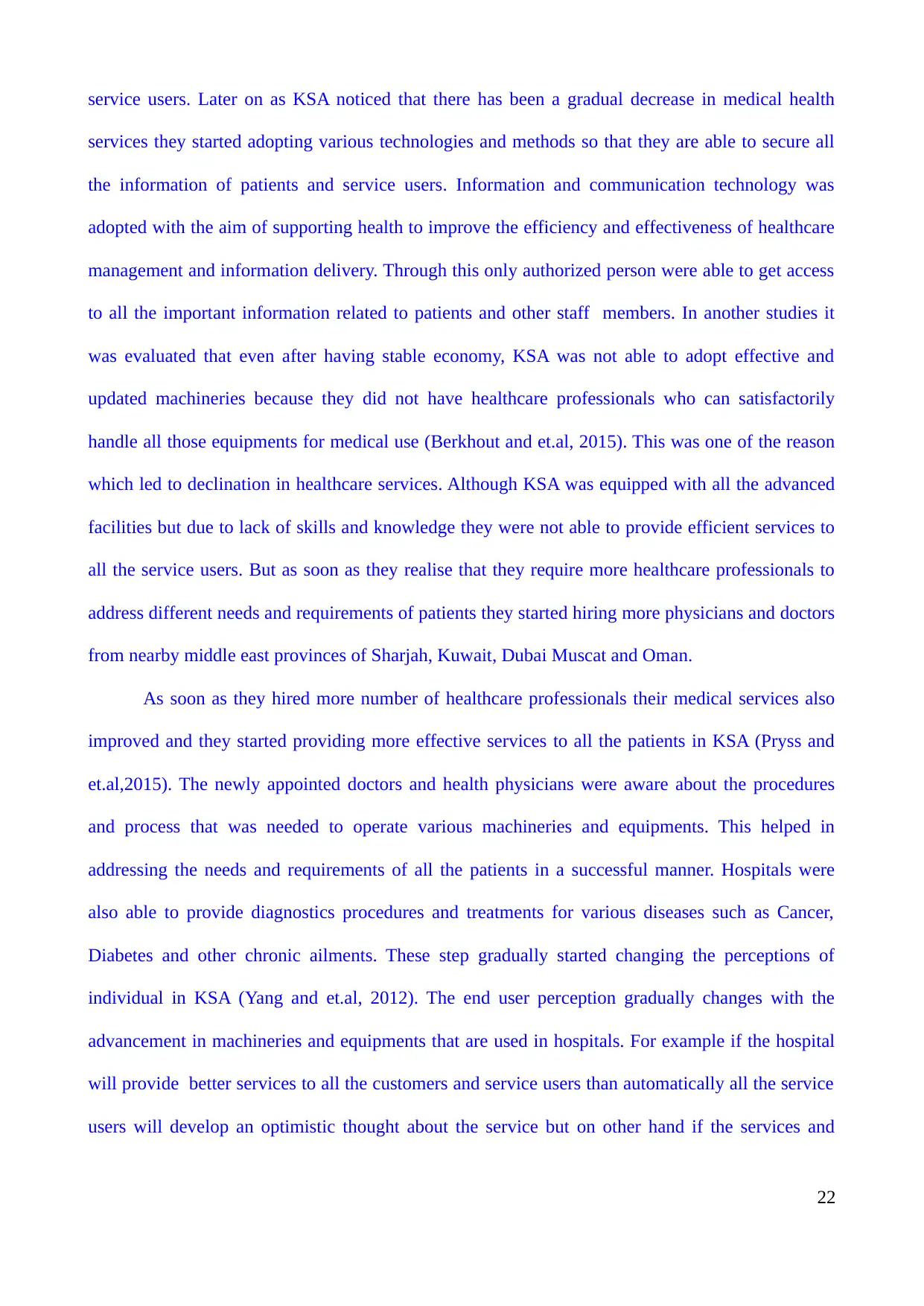
service users. Later on as KSA noticed that there has been a gradual decrease in medical health
services they started adopting various technologies and methods so that they are able to secure all
the information of patients and service users. Information and communication technology was
adopted with the aim of supporting health to improve the efficiency and effectiveness of healthcare
management and information delivery. Through this only authorized person were able to get access
to all the important information related to patients and other staff members. In another studies it
was evaluated that even after having stable economy, KSA was not able to adopt effective and
updated machineries because they did not have healthcare professionals who can satisfactorily
handle all those equipments for medical use (Berkhout and et.al, 2015). This was one of the reason
which led to declination in healthcare services. Although KSA was equipped with all the advanced
facilities but due to lack of skills and knowledge they were not able to provide efficient services to
all the service users. But as soon as they realise that they require more healthcare professionals to
address different needs and requirements of patients they started hiring more physicians and doctors
from nearby middle east provinces of Sharjah, Kuwait, Dubai Muscat and Oman.
As soon as they hired more number of healthcare professionals their medical services also
improved and they started providing more effective services to all the patients in KSA (Pryss and
et.al,2015). The newly appointed doctors and health physicians were aware about the procedures
and process that was needed to operate various machineries and equipments. This helped in
addressing the needs and requirements of all the patients in a successful manner. Hospitals were
also able to provide diagnostics procedures and treatments for various diseases such as Cancer,
Diabetes and other chronic ailments. These step gradually started changing the perceptions of
individual in KSA (Yang and et.al, 2012). The end user perception gradually changes with the
advancement in machineries and equipments that are used in hospitals. For example if the hospital
will provide better services to all the customers and service users than automatically all the service
users will develop an optimistic thought about the service but on other hand if the services and
22
services they started adopting various technologies and methods so that they are able to secure all
the information of patients and service users. Information and communication technology was
adopted with the aim of supporting health to improve the efficiency and effectiveness of healthcare
management and information delivery. Through this only authorized person were able to get access
to all the important information related to patients and other staff members. In another studies it
was evaluated that even after having stable economy, KSA was not able to adopt effective and
updated machineries because they did not have healthcare professionals who can satisfactorily
handle all those equipments for medical use (Berkhout and et.al, 2015). This was one of the reason
which led to declination in healthcare services. Although KSA was equipped with all the advanced
facilities but due to lack of skills and knowledge they were not able to provide efficient services to
all the service users. But as soon as they realise that they require more healthcare professionals to
address different needs and requirements of patients they started hiring more physicians and doctors
from nearby middle east provinces of Sharjah, Kuwait, Dubai Muscat and Oman.
As soon as they hired more number of healthcare professionals their medical services also
improved and they started providing more effective services to all the patients in KSA (Pryss and
et.al,2015). The newly appointed doctors and health physicians were aware about the procedures
and process that was needed to operate various machineries and equipments. This helped in
addressing the needs and requirements of all the patients in a successful manner. Hospitals were
also able to provide diagnostics procedures and treatments for various diseases such as Cancer,
Diabetes and other chronic ailments. These step gradually started changing the perceptions of
individual in KSA (Yang and et.al, 2012). The end user perception gradually changes with the
advancement in machineries and equipments that are used in hospitals. For example if the hospital
will provide better services to all the customers and service users than automatically all the service
users will develop an optimistic thought about the service but on other hand if the services and
22
Secure Best Marks with AI Grader
Need help grading? Try our AI Grader for instant feedback on your assignments.
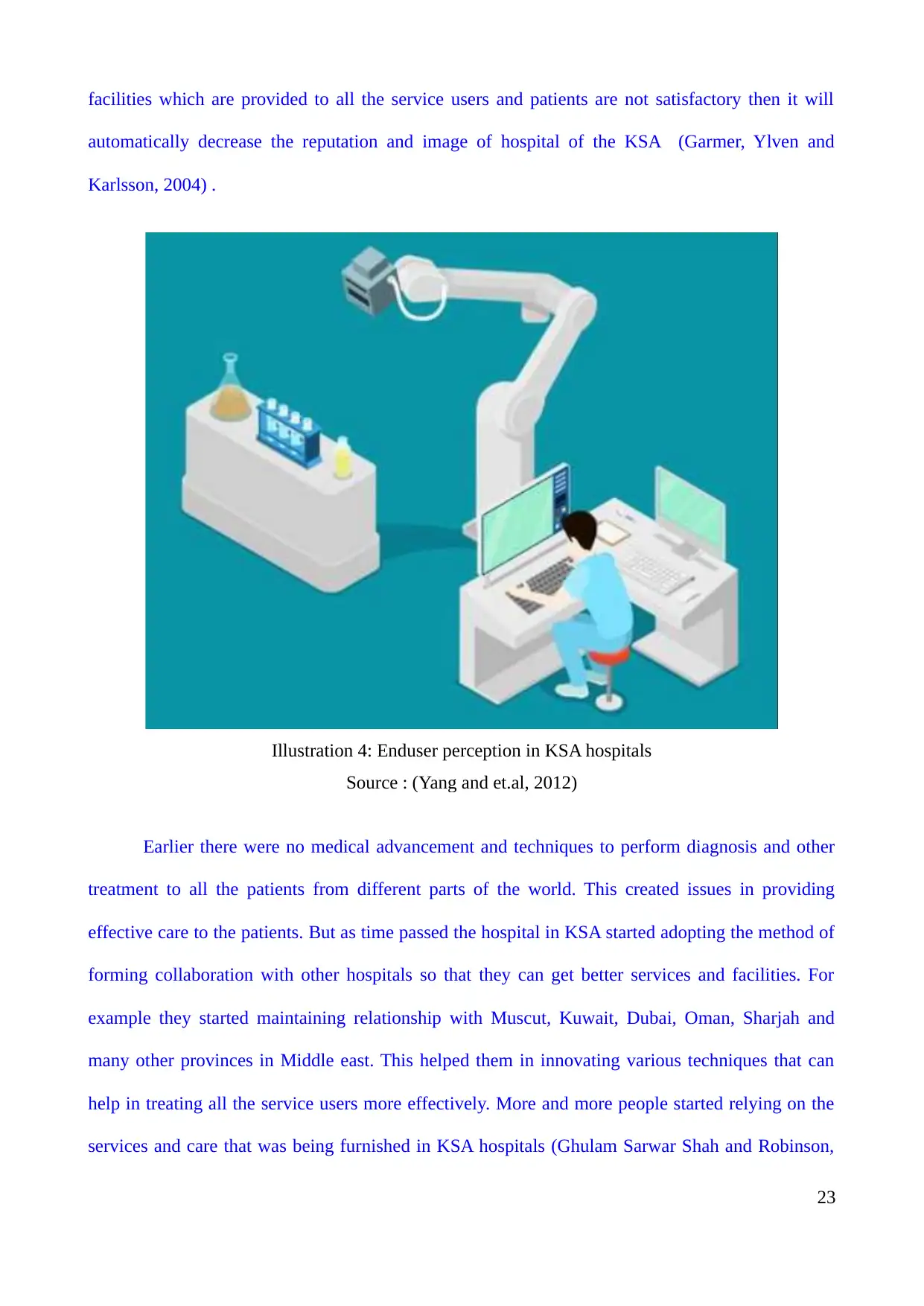
facilities which are provided to all the service users and patients are not satisfactory then it will
automatically decrease the reputation and image of hospital of the KSA (Garmer, Ylven and
Karlsson, 2004) .
Earlier there were no medical advancement and techniques to perform diagnosis and other
treatment to all the patients from different parts of the world. This created issues in providing
effective care to the patients. But as time passed the hospital in KSA started adopting the method of
forming collaboration with other hospitals so that they can get better services and facilities. For
example they started maintaining relationship with Muscut, Kuwait, Dubai, Oman, Sharjah and
many other provinces in Middle east. This helped them in innovating various techniques that can
help in treating all the service users more effectively. More and more people started relying on the
services and care that was being furnished in KSA hospitals (Ghulam Sarwar Shah and Robinson,
23
Illustration 4: Enduser perception in KSA hospitals
Source : (Yang and et.al, 2012)
automatically decrease the reputation and image of hospital of the KSA (Garmer, Ylven and
Karlsson, 2004) .
Earlier there were no medical advancement and techniques to perform diagnosis and other
treatment to all the patients from different parts of the world. This created issues in providing
effective care to the patients. But as time passed the hospital in KSA started adopting the method of
forming collaboration with other hospitals so that they can get better services and facilities. For
example they started maintaining relationship with Muscut, Kuwait, Dubai, Oman, Sharjah and
many other provinces in Middle east. This helped them in innovating various techniques that can
help in treating all the service users more effectively. More and more people started relying on the
services and care that was being furnished in KSA hospitals (Ghulam Sarwar Shah and Robinson,
23
Illustration 4: Enduser perception in KSA hospitals
Source : (Yang and et.al, 2012)
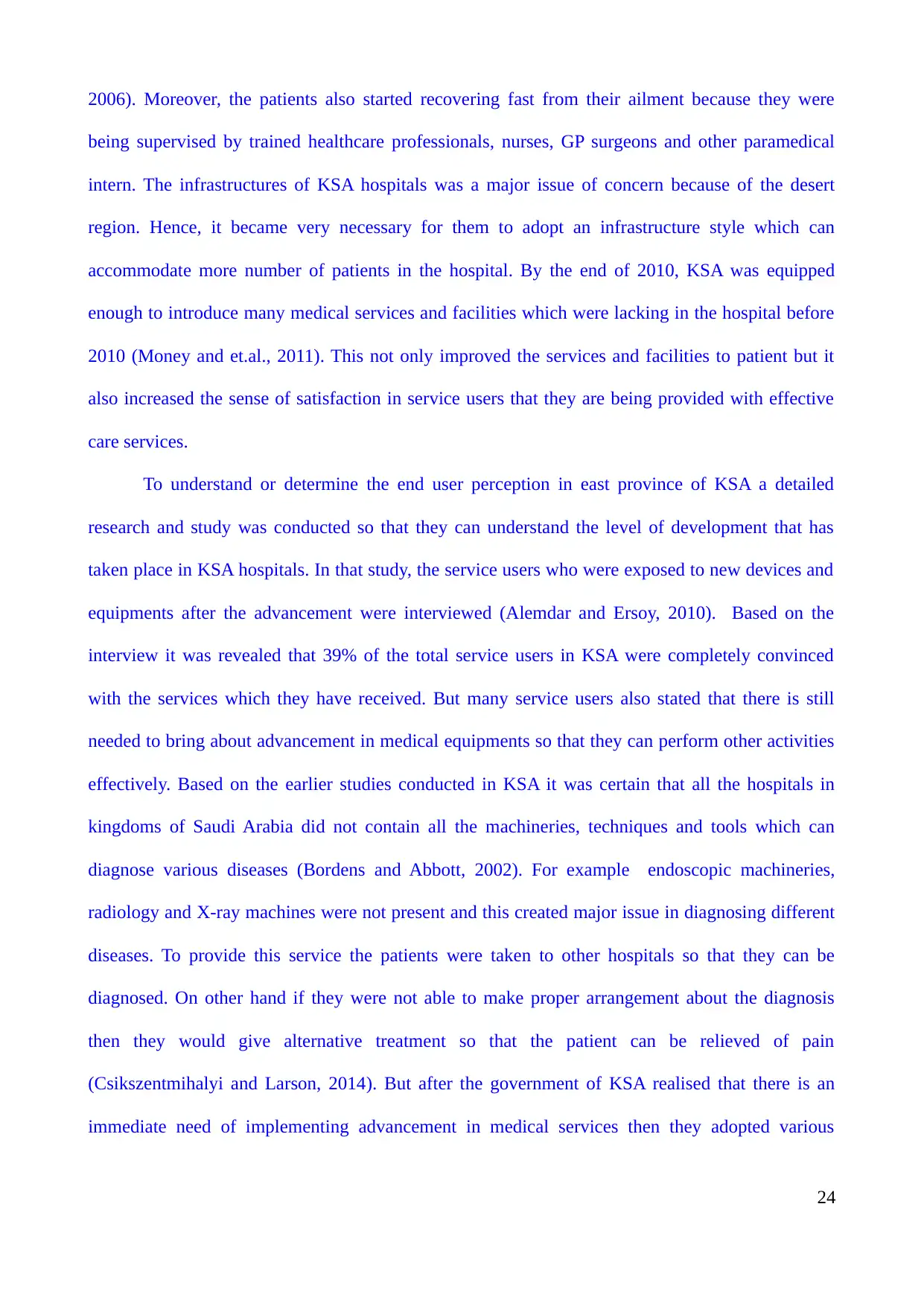
2006). Moreover, the patients also started recovering fast from their ailment because they were
being supervised by trained healthcare professionals, nurses, GP surgeons and other paramedical
intern. The infrastructures of KSA hospitals was a major issue of concern because of the desert
region. Hence, it became very necessary for them to adopt an infrastructure style which can
accommodate more number of patients in the hospital. By the end of 2010, KSA was equipped
enough to introduce many medical services and facilities which were lacking in the hospital before
2010 (Money and et.al., 2011). This not only improved the services and facilities to patient but it
also increased the sense of satisfaction in service users that they are being provided with effective
care services.
To understand or determine the end user perception in east province of KSA a detailed
research and study was conducted so that they can understand the level of development that has
taken place in KSA hospitals. In that study, the service users who were exposed to new devices and
equipments after the advancement were interviewed (Alemdar and Ersoy, 2010). Based on the
interview it was revealed that 39% of the total service users in KSA were completely convinced
with the services which they have received. But many service users also stated that there is still
needed to bring about advancement in medical equipments so that they can perform other activities
effectively. Based on the earlier studies conducted in KSA it was certain that all the hospitals in
kingdoms of Saudi Arabia did not contain all the machineries, techniques and tools which can
diagnose various diseases (Bordens and Abbott, 2002). For example endoscopic machineries,
radiology and X-ray machines were not present and this created major issue in diagnosing different
diseases. To provide this service the patients were taken to other hospitals so that they can be
diagnosed. On other hand if they were not able to make proper arrangement about the diagnosis
then they would give alternative treatment so that the patient can be relieved of pain
(Csikszentmihalyi and Larson, 2014). But after the government of KSA realised that there is an
immediate need of implementing advancement in medical services then they adopted various
24
being supervised by trained healthcare professionals, nurses, GP surgeons and other paramedical
intern. The infrastructures of KSA hospitals was a major issue of concern because of the desert
region. Hence, it became very necessary for them to adopt an infrastructure style which can
accommodate more number of patients in the hospital. By the end of 2010, KSA was equipped
enough to introduce many medical services and facilities which were lacking in the hospital before
2010 (Money and et.al., 2011). This not only improved the services and facilities to patient but it
also increased the sense of satisfaction in service users that they are being provided with effective
care services.
To understand or determine the end user perception in east province of KSA a detailed
research and study was conducted so that they can understand the level of development that has
taken place in KSA hospitals. In that study, the service users who were exposed to new devices and
equipments after the advancement were interviewed (Alemdar and Ersoy, 2010). Based on the
interview it was revealed that 39% of the total service users in KSA were completely convinced
with the services which they have received. But many service users also stated that there is still
needed to bring about advancement in medical equipments so that they can perform other activities
effectively. Based on the earlier studies conducted in KSA it was certain that all the hospitals in
kingdoms of Saudi Arabia did not contain all the machineries, techniques and tools which can
diagnose various diseases (Bordens and Abbott, 2002). For example endoscopic machineries,
radiology and X-ray machines were not present and this created major issue in diagnosing different
diseases. To provide this service the patients were taken to other hospitals so that they can be
diagnosed. On other hand if they were not able to make proper arrangement about the diagnosis
then they would give alternative treatment so that the patient can be relieved of pain
(Csikszentmihalyi and Larson, 2014). But after the government of KSA realised that there is an
immediate need of implementing advancement in medical services then they adopted various
24
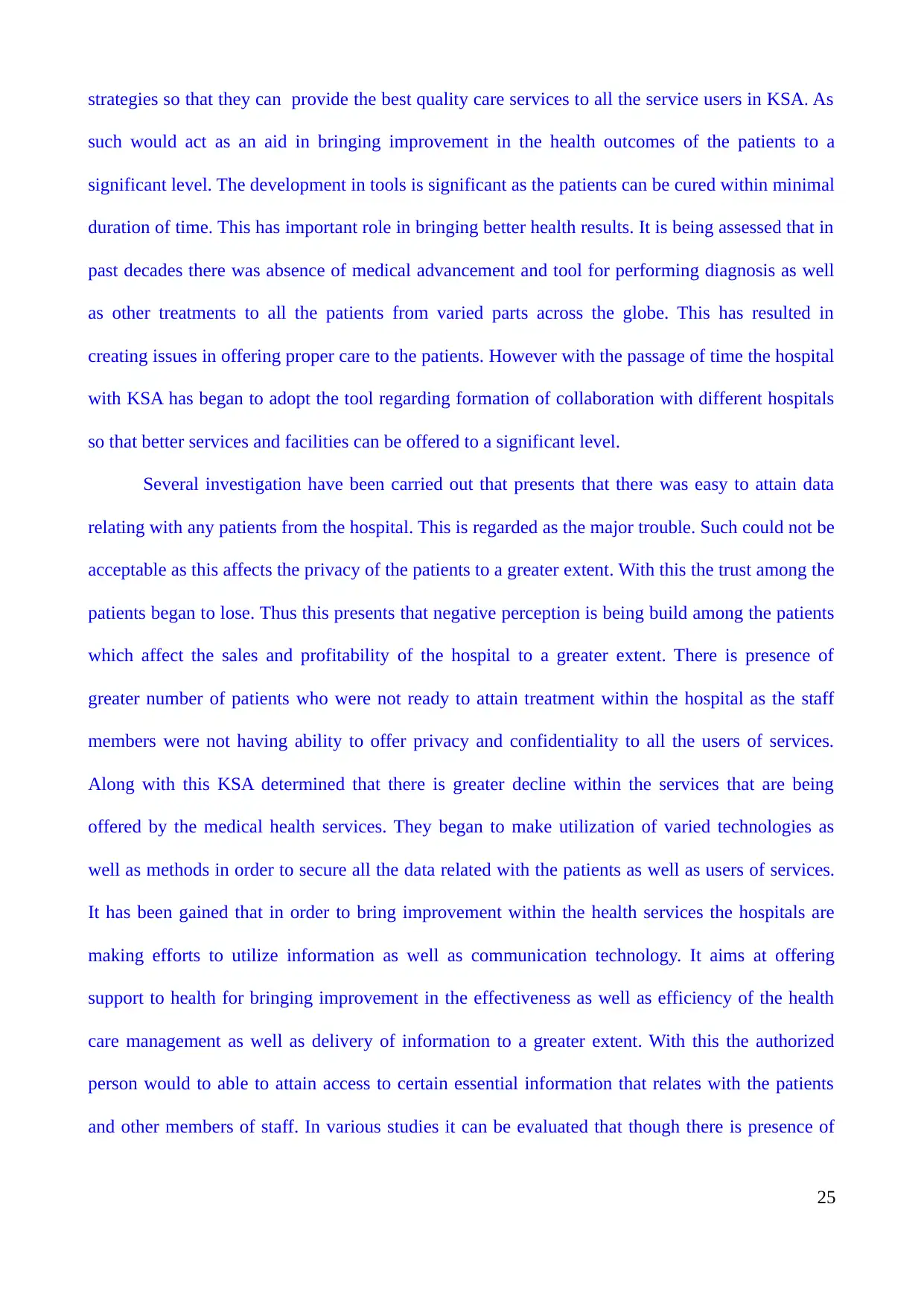
strategies so that they can provide the best quality care services to all the service users in KSA. As
such would act as an aid in bringing improvement in the health outcomes of the patients to a
significant level. The development in tools is significant as the patients can be cured within minimal
duration of time. This has important role in bringing better health results. It is being assessed that in
past decades there was absence of medical advancement and tool for performing diagnosis as well
as other treatments to all the patients from varied parts across the globe. This has resulted in
creating issues in offering proper care to the patients. However with the passage of time the hospital
with KSA has began to adopt the tool regarding formation of collaboration with different hospitals
so that better services and facilities can be offered to a significant level.
Several investigation have been carried out that presents that there was easy to attain data
relating with any patients from the hospital. This is regarded as the major trouble. Such could not be
acceptable as this affects the privacy of the patients to a greater extent. With this the trust among the
patients began to lose. Thus this presents that negative perception is being build among the patients
which affect the sales and profitability of the hospital to a greater extent. There is presence of
greater number of patients who were not ready to attain treatment within the hospital as the staff
members were not having ability to offer privacy and confidentiality to all the users of services.
Along with this KSA determined that there is greater decline within the services that are being
offered by the medical health services. They began to make utilization of varied technologies as
well as methods in order to secure all the data related with the patients as well as users of services.
It has been gained that in order to bring improvement within the health services the hospitals are
making efforts to utilize information as well as communication technology. It aims at offering
support to health for bringing improvement in the effectiveness as well as efficiency of the health
care management as well as delivery of information to a greater extent. With this the authorized
person would to able to attain access to certain essential information that relates with the patients
and other members of staff. In various studies it can be evaluated that though there is presence of
25
such would act as an aid in bringing improvement in the health outcomes of the patients to a
significant level. The development in tools is significant as the patients can be cured within minimal
duration of time. This has important role in bringing better health results. It is being assessed that in
past decades there was absence of medical advancement and tool for performing diagnosis as well
as other treatments to all the patients from varied parts across the globe. This has resulted in
creating issues in offering proper care to the patients. However with the passage of time the hospital
with KSA has began to adopt the tool regarding formation of collaboration with different hospitals
so that better services and facilities can be offered to a significant level.
Several investigation have been carried out that presents that there was easy to attain data
relating with any patients from the hospital. This is regarded as the major trouble. Such could not be
acceptable as this affects the privacy of the patients to a greater extent. With this the trust among the
patients began to lose. Thus this presents that negative perception is being build among the patients
which affect the sales and profitability of the hospital to a greater extent. There is presence of
greater number of patients who were not ready to attain treatment within the hospital as the staff
members were not having ability to offer privacy and confidentiality to all the users of services.
Along with this KSA determined that there is greater decline within the services that are being
offered by the medical health services. They began to make utilization of varied technologies as
well as methods in order to secure all the data related with the patients as well as users of services.
It has been gained that in order to bring improvement within the health services the hospitals are
making efforts to utilize information as well as communication technology. It aims at offering
support to health for bringing improvement in the effectiveness as well as efficiency of the health
care management as well as delivery of information to a greater extent. With this the authorized
person would to able to attain access to certain essential information that relates with the patients
and other members of staff. In various studies it can be evaluated that though there is presence of
25
Paraphrase This Document
Need a fresh take? Get an instant paraphrase of this document with our AI Paraphraser
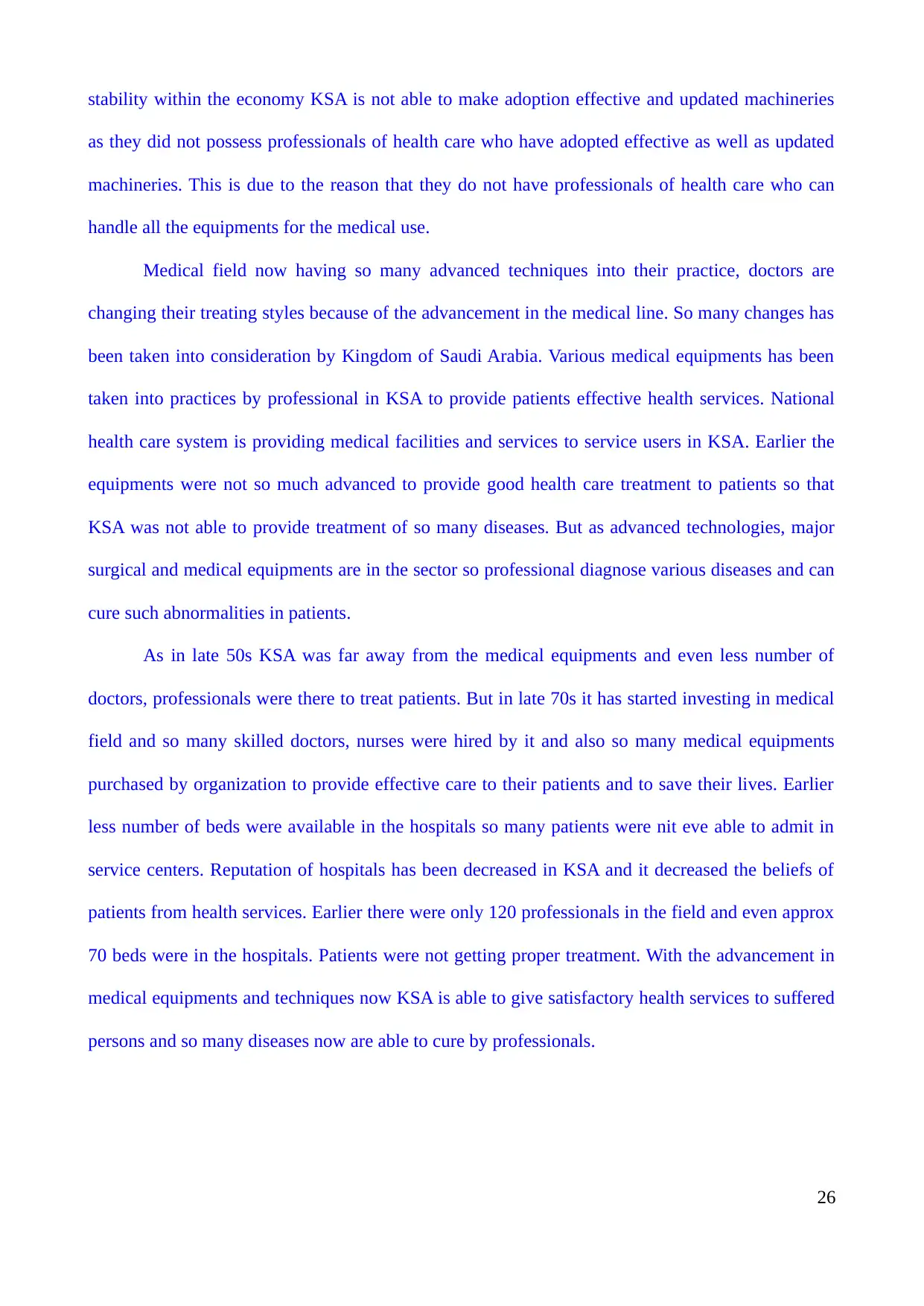
stability within the economy KSA is not able to make adoption effective and updated machineries
as they did not possess professionals of health care who have adopted effective as well as updated
machineries. This is due to the reason that they do not have professionals of health care who can
handle all the equipments for the medical use.
Medical field now having so many advanced techniques into their practice, doctors are
changing their treating styles because of the advancement in the medical line. So many changes has
been taken into consideration by Kingdom of Saudi Arabia. Various medical equipments has been
taken into practices by professional in KSA to provide patients effective health services. National
health care system is providing medical facilities and services to service users in KSA. Earlier the
equipments were not so much advanced to provide good health care treatment to patients so that
KSA was not able to provide treatment of so many diseases. But as advanced technologies, major
surgical and medical equipments are in the sector so professional diagnose various diseases and can
cure such abnormalities in patients.
As in late 50s KSA was far away from the medical equipments and even less number of
doctors, professionals were there to treat patients. But in late 70s it has started investing in medical
field and so many skilled doctors, nurses were hired by it and also so many medical equipments
purchased by organization to provide effective care to their patients and to save their lives. Earlier
less number of beds were available in the hospitals so many patients were nit eve able to admit in
service centers. Reputation of hospitals has been decreased in KSA and it decreased the beliefs of
patients from health services. Earlier there were only 120 professionals in the field and even approx
70 beds were in the hospitals. Patients were not getting proper treatment. With the advancement in
medical equipments and techniques now KSA is able to give satisfactory health services to suffered
persons and so many diseases now are able to cure by professionals.
26
as they did not possess professionals of health care who have adopted effective as well as updated
machineries. This is due to the reason that they do not have professionals of health care who can
handle all the equipments for the medical use.
Medical field now having so many advanced techniques into their practice, doctors are
changing their treating styles because of the advancement in the medical line. So many changes has
been taken into consideration by Kingdom of Saudi Arabia. Various medical equipments has been
taken into practices by professional in KSA to provide patients effective health services. National
health care system is providing medical facilities and services to service users in KSA. Earlier the
equipments were not so much advanced to provide good health care treatment to patients so that
KSA was not able to provide treatment of so many diseases. But as advanced technologies, major
surgical and medical equipments are in the sector so professional diagnose various diseases and can
cure such abnormalities in patients.
As in late 50s KSA was far away from the medical equipments and even less number of
doctors, professionals were there to treat patients. But in late 70s it has started investing in medical
field and so many skilled doctors, nurses were hired by it and also so many medical equipments
purchased by organization to provide effective care to their patients and to save their lives. Earlier
less number of beds were available in the hospitals so many patients were nit eve able to admit in
service centers. Reputation of hospitals has been decreased in KSA and it decreased the beliefs of
patients from health services. Earlier there were only 120 professionals in the field and even approx
70 beds were in the hospitals. Patients were not getting proper treatment. With the advancement in
medical equipments and techniques now KSA is able to give satisfactory health services to suffered
persons and so many diseases now are able to cure by professionals.
26
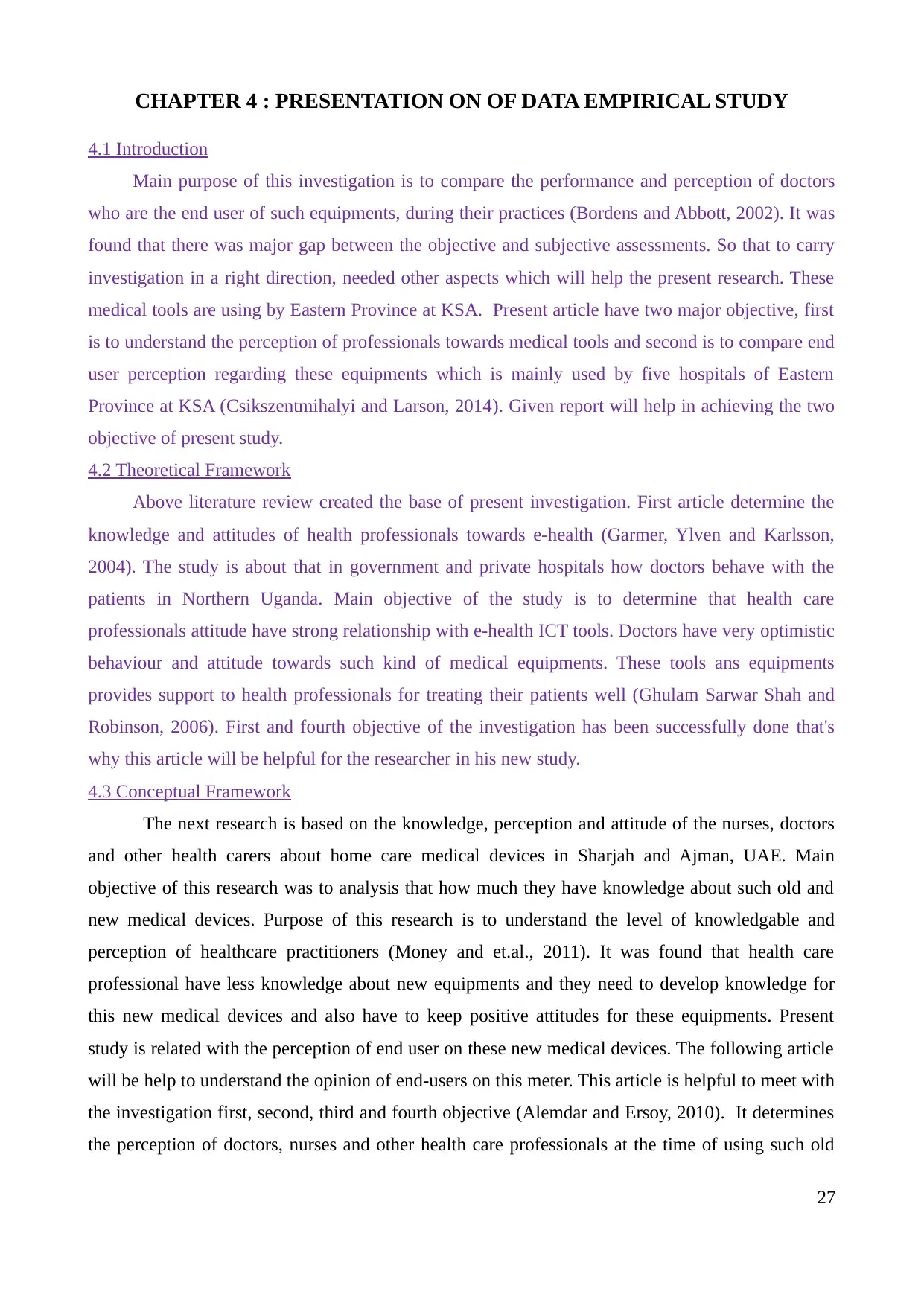
CHAPTER 4 : PRESENTATION ON OF DATA EMPIRICAL STUDY
4.1 Introduction
Main purpose of this investigation is to compare the performance and perception of doctors
who are the end user of such equipments, during their practices (Bordens and Abbott, 2002). It was
found that there was major gap between the objective and subjective assessments. So that to carry
investigation in a right direction, needed other aspects which will help the present research. These
medical tools are using by Eastern Province at KSA. Present article have two major objective, first
is to understand the perception of professionals towards medical tools and second is to compare end
user perception regarding these equipments which is mainly used by five hospitals of Eastern
Province at KSA (Csikszentmihalyi and Larson, 2014). Given report will help in achieving the two
objective of present study.
4.2 Theoretical Framework
Above literature review created the base of present investigation. First article determine the
knowledge and attitudes of health professionals towards e-health (Garmer, Ylven and Karlsson,
2004). The study is about that in government and private hospitals how doctors behave with the
patients in Northern Uganda. Main objective of the study is to determine that health care
professionals attitude have strong relationship with e-health ICT tools. Doctors have very optimistic
behaviour and attitude towards such kind of medical equipments. These tools ans equipments
provides support to health professionals for treating their patients well (Ghulam Sarwar Shah and
Robinson, 2006). First and fourth objective of the investigation has been successfully done that's
why this article will be helpful for the researcher in his new study.
4.3 Conceptual Framework
The next research is based on the knowledge, perception and attitude of the nurses, doctors
and other health carers about home care medical devices in Sharjah and Ajman, UAE. Main
objective of this research was to analysis that how much they have knowledge about such old and
new medical devices. Purpose of this research is to understand the level of knowledgable and
perception of healthcare practitioners (Money and et.al., 2011). It was found that health care
professional have less knowledge about new equipments and they need to develop knowledge for
this new medical devices and also have to keep positive attitudes for these equipments. Present
study is related with the perception of end user on these new medical devices. The following article
will be help to understand the opinion of end-users on this meter. This article is helpful to meet with
the investigation first, second, third and fourth objective (Alemdar and Ersoy, 2010). It determines
the perception of doctors, nurses and other health care professionals at the time of using such old
27
4.1 Introduction
Main purpose of this investigation is to compare the performance and perception of doctors
who are the end user of such equipments, during their practices (Bordens and Abbott, 2002). It was
found that there was major gap between the objective and subjective assessments. So that to carry
investigation in a right direction, needed other aspects which will help the present research. These
medical tools are using by Eastern Province at KSA. Present article have two major objective, first
is to understand the perception of professionals towards medical tools and second is to compare end
user perception regarding these equipments which is mainly used by five hospitals of Eastern
Province at KSA (Csikszentmihalyi and Larson, 2014). Given report will help in achieving the two
objective of present study.
4.2 Theoretical Framework
Above literature review created the base of present investigation. First article determine the
knowledge and attitudes of health professionals towards e-health (Garmer, Ylven and Karlsson,
2004). The study is about that in government and private hospitals how doctors behave with the
patients in Northern Uganda. Main objective of the study is to determine that health care
professionals attitude have strong relationship with e-health ICT tools. Doctors have very optimistic
behaviour and attitude towards such kind of medical equipments. These tools ans equipments
provides support to health professionals for treating their patients well (Ghulam Sarwar Shah and
Robinson, 2006). First and fourth objective of the investigation has been successfully done that's
why this article will be helpful for the researcher in his new study.
4.3 Conceptual Framework
The next research is based on the knowledge, perception and attitude of the nurses, doctors
and other health carers about home care medical devices in Sharjah and Ajman, UAE. Main
objective of this research was to analysis that how much they have knowledge about such old and
new medical devices. Purpose of this research is to understand the level of knowledgable and
perception of healthcare practitioners (Money and et.al., 2011). It was found that health care
professional have less knowledge about new equipments and they need to develop knowledge for
this new medical devices and also have to keep positive attitudes for these equipments. Present
study is related with the perception of end user on these new medical devices. The following article
will be help to understand the opinion of end-users on this meter. This article is helpful to meet with
the investigation first, second, third and fourth objective (Alemdar and Ersoy, 2010). It determines
the perception of doctors, nurses and other health care professionals at the time of using such old
27

and new devices.
But the previous study have some limitations. All three articles discussed only about
knowledge, perception of medical professionals for the use of such medical equipments during their
practices (Pryss and et.al,2015). Doctors, nurses already were having positive reaction and attitudes
towards the medical tools. This research did not focus on negative perception of customers towards
the medical tools. Previous research was limited to the examination of such devices like X-Ray,
ultra sound machine, caughtary unit, endoscopy unit etc (Yang and et.al, 2012). Patients are the
main person, this article did not involve perception of customers which was very much required
because medical professional already have optimistic perception towards these tools. This research
has huge gape, to overcome from this gap following research included some research models. These
theoretical framework of research models is able to explain the next section of the research. Most of
the Ministry of Health hospitals in Saudi Arabia has recently adapted a separate local heath
information system that can easily reflect the efforts which have been made by the government of
KSA to communicate various information to the service users and staff members (Pryss and
et.al,2015). The General Directorate of health affair systems, Makkah has been considered as the
largest health region which is managing more than 36 hospitals in all over the four cities of Saudi
Arabia. At the time of studying various aspects of healthcare services, out of 36 hospitals 5 major
hospitals were chosen which acquired electronic medical record systems and they were using this
system for more than 5 years. Recently, Saudi Arabia has prioritized the development of health care
services so that they are able to provide effective care services to all the patients (Yang and et.al,
2012).
Earlier when these hospitals were not equipped with proper healthcare services then they
could not increase the reputation and satisfaction level of end users. But with advancement they
have increased the level of services which have also helped in providing effective care services to
all the end-users (Shung, 2015). Many studies have been conducted in order to determine the
perception of end-users about the medical equipments in the context of functionality and advantage
(Rajan and et.al, 2013). To provide evidence to this a cross sectional study was conducted in July
2009 This study was based on structured questionnaire with five Likert scaling in which the scales
were strongly based on the degree of agree and disagree (Garmer, Ylven and Karlsson, 2004). The
end-users and physicians who were working in five different hospitals of KSA were selected so that
they can be interviewed. Descriptive data analysis methods were used so that data can be analysed
effectively. Five different hospitals namely Hera General Hospital (H1), Makkah city, (317 beds),
King Abdul Aziz Hospital (H2), Ta'if city, (691 beds), King Fahd Hospital (H3), Jeddah city, (840
beds); Maternity and Child Health Hospital (H4), Jeddah city, (390 beds); Alnoor Specialist
28
But the previous study have some limitations. All three articles discussed only about
knowledge, perception of medical professionals for the use of such medical equipments during their
practices (Pryss and et.al,2015). Doctors, nurses already were having positive reaction and attitudes
towards the medical tools. This research did not focus on negative perception of customers towards
the medical tools. Previous research was limited to the examination of such devices like X-Ray,
ultra sound machine, caughtary unit, endoscopy unit etc (Yang and et.al, 2012). Patients are the
main person, this article did not involve perception of customers which was very much required
because medical professional already have optimistic perception towards these tools. This research
has huge gape, to overcome from this gap following research included some research models. These
theoretical framework of research models is able to explain the next section of the research. Most of
the Ministry of Health hospitals in Saudi Arabia has recently adapted a separate local heath
information system that can easily reflect the efforts which have been made by the government of
KSA to communicate various information to the service users and staff members (Pryss and
et.al,2015). The General Directorate of health affair systems, Makkah has been considered as the
largest health region which is managing more than 36 hospitals in all over the four cities of Saudi
Arabia. At the time of studying various aspects of healthcare services, out of 36 hospitals 5 major
hospitals were chosen which acquired electronic medical record systems and they were using this
system for more than 5 years. Recently, Saudi Arabia has prioritized the development of health care
services so that they are able to provide effective care services to all the patients (Yang and et.al,
2012).
Earlier when these hospitals were not equipped with proper healthcare services then they
could not increase the reputation and satisfaction level of end users. But with advancement they
have increased the level of services which have also helped in providing effective care services to
all the end-users (Shung, 2015). Many studies have been conducted in order to determine the
perception of end-users about the medical equipments in the context of functionality and advantage
(Rajan and et.al, 2013). To provide evidence to this a cross sectional study was conducted in July
2009 This study was based on structured questionnaire with five Likert scaling in which the scales
were strongly based on the degree of agree and disagree (Garmer, Ylven and Karlsson, 2004). The
end-users and physicians who were working in five different hospitals of KSA were selected so that
they can be interviewed. Descriptive data analysis methods were used so that data can be analysed
effectively. Five different hospitals namely Hera General Hospital (H1), Makkah city, (317 beds),
King Abdul Aziz Hospital (H2), Ta'if city, (691 beds), King Fahd Hospital (H3), Jeddah city, (840
beds); Maternity and Child Health Hospital (H4), Jeddah city, (390 beds); Alnoor Specialist
28
Secure Best Marks with AI Grader
Need help grading? Try our AI Grader for instant feedback on your assignments.
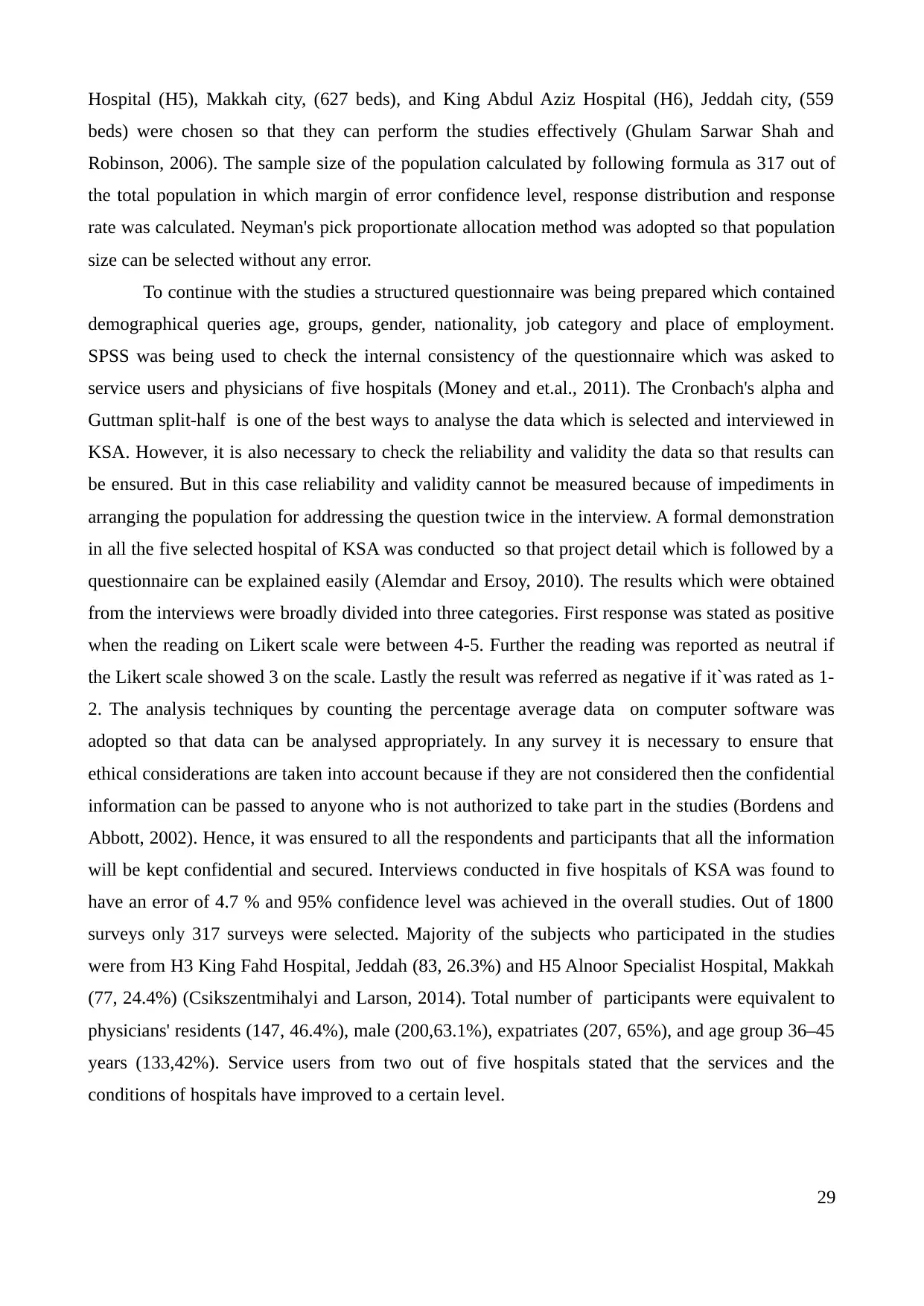
Hospital (H5), Makkah city, (627 beds), and King Abdul Aziz Hospital (H6), Jeddah city, (559
beds) were chosen so that they can perform the studies effectively (Ghulam Sarwar Shah and
Robinson, 2006). The sample size of the population calculated by following formula as 317 out of
the total population in which margin of error confidence level, response distribution and response
rate was calculated. Neyman's pick proportionate allocation method was adopted so that population
size can be selected without any error.
To continue with the studies a structured questionnaire was being prepared which contained
demographical queries age, groups, gender, nationality, job category and place of employment.
SPSS was being used to check the internal consistency of the questionnaire which was asked to
service users and physicians of five hospitals (Money and et.al., 2011). The Cronbach's alpha and
Guttman split-half is one of the best ways to analyse the data which is selected and interviewed in
KSA. However, it is also necessary to check the reliability and validity the data so that results can
be ensured. But in this case reliability and validity cannot be measured because of impediments in
arranging the population for addressing the question twice in the interview. A formal demonstration
in all the five selected hospital of KSA was conducted so that project detail which is followed by a
questionnaire can be explained easily (Alemdar and Ersoy, 2010). The results which were obtained
from the interviews were broadly divided into three categories. First response was stated as positive
when the reading on Likert scale were between 4-5. Further the reading was reported as neutral if
the Likert scale showed 3 on the scale. Lastly the result was referred as negative if it`was rated as 1-
2. The analysis techniques by counting the percentage average data on computer software was
adopted so that data can be analysed appropriately. In any survey it is necessary to ensure that
ethical considerations are taken into account because if they are not considered then the confidential
information can be passed to anyone who is not authorized to take part in the studies (Bordens and
Abbott, 2002). Hence, it was ensured to all the respondents and participants that all the information
will be kept confidential and secured. Interviews conducted in five hospitals of KSA was found to
have an error of 4.7 % and 95% confidence level was achieved in the overall studies. Out of 1800
surveys only 317 surveys were selected. Majority of the subjects who participated in the studies
were from H3 King Fahd Hospital, Jeddah (83, 26.3%) and H5 Alnoor Specialist Hospital, Makkah
(77, 24.4%) (Csikszentmihalyi and Larson, 2014). Total number of participants were equivalent to
physicians' residents (147, 46.4%), male (200,63.1%), expatriates (207, 65%), and age group 36–45
years (133,42%). Service users from two out of five hospitals stated that the services and the
conditions of hospitals have improved to a certain level.
29
beds) were chosen so that they can perform the studies effectively (Ghulam Sarwar Shah and
Robinson, 2006). The sample size of the population calculated by following formula as 317 out of
the total population in which margin of error confidence level, response distribution and response
rate was calculated. Neyman's pick proportionate allocation method was adopted so that population
size can be selected without any error.
To continue with the studies a structured questionnaire was being prepared which contained
demographical queries age, groups, gender, nationality, job category and place of employment.
SPSS was being used to check the internal consistency of the questionnaire which was asked to
service users and physicians of five hospitals (Money and et.al., 2011). The Cronbach's alpha and
Guttman split-half is one of the best ways to analyse the data which is selected and interviewed in
KSA. However, it is also necessary to check the reliability and validity the data so that results can
be ensured. But in this case reliability and validity cannot be measured because of impediments in
arranging the population for addressing the question twice in the interview. A formal demonstration
in all the five selected hospital of KSA was conducted so that project detail which is followed by a
questionnaire can be explained easily (Alemdar and Ersoy, 2010). The results which were obtained
from the interviews were broadly divided into three categories. First response was stated as positive
when the reading on Likert scale were between 4-5. Further the reading was reported as neutral if
the Likert scale showed 3 on the scale. Lastly the result was referred as negative if it`was rated as 1-
2. The analysis techniques by counting the percentage average data on computer software was
adopted so that data can be analysed appropriately. In any survey it is necessary to ensure that
ethical considerations are taken into account because if they are not considered then the confidential
information can be passed to anyone who is not authorized to take part in the studies (Bordens and
Abbott, 2002). Hence, it was ensured to all the respondents and participants that all the information
will be kept confidential and secured. Interviews conducted in five hospitals of KSA was found to
have an error of 4.7 % and 95% confidence level was achieved in the overall studies. Out of 1800
surveys only 317 surveys were selected. Majority of the subjects who participated in the studies
were from H3 King Fahd Hospital, Jeddah (83, 26.3%) and H5 Alnoor Specialist Hospital, Makkah
(77, 24.4%) (Csikszentmihalyi and Larson, 2014). Total number of participants were equivalent to
physicians' residents (147, 46.4%), male (200,63.1%), expatriates (207, 65%), and age group 36–45
years (133,42%). Service users from two out of five hospitals stated that the services and the
conditions of hospitals have improved to a certain level.
29
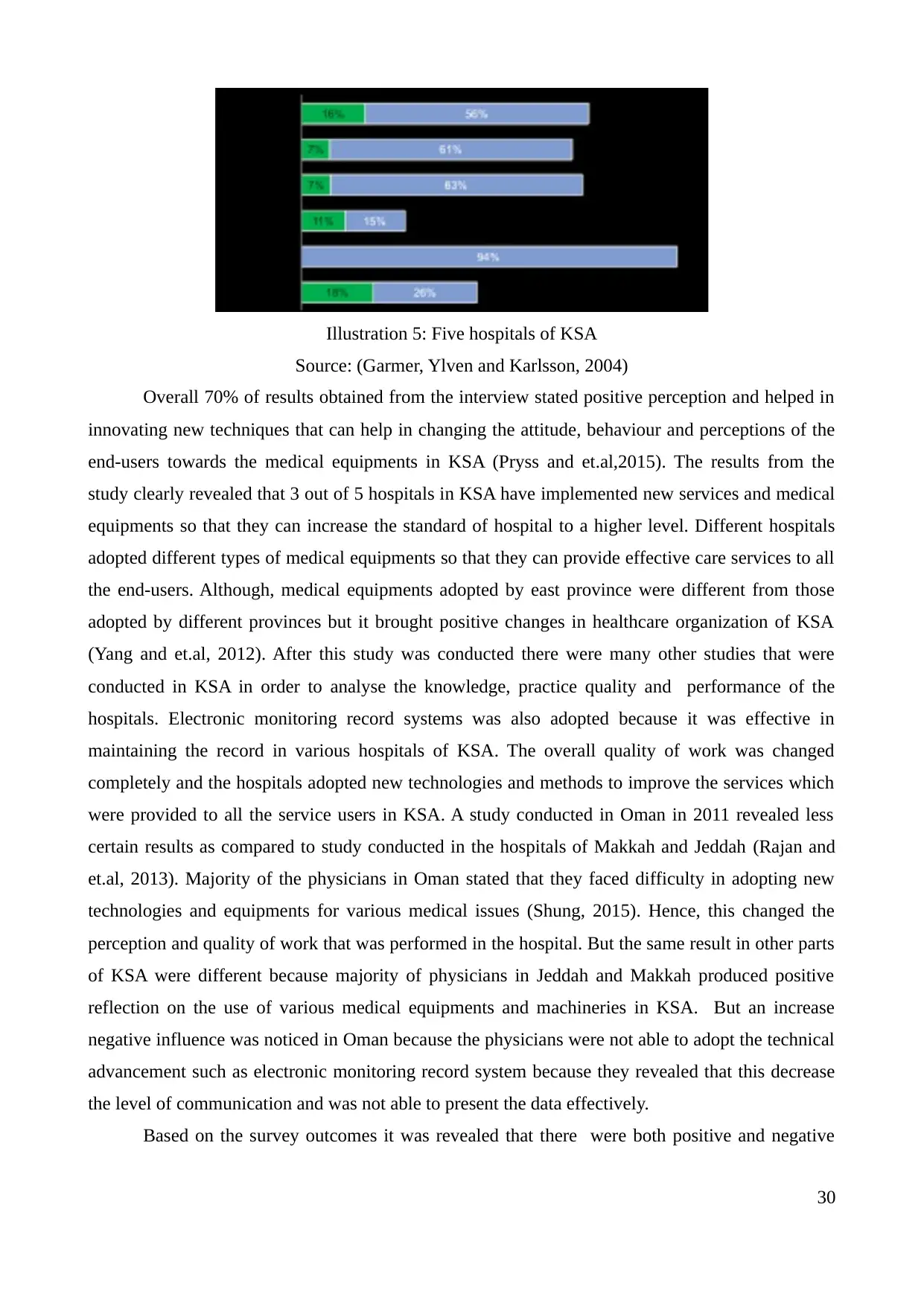
Overall 70% of results obtained from the interview stated positive perception and helped in
innovating new techniques that can help in changing the attitude, behaviour and perceptions of the
end-users towards the medical equipments in KSA (Pryss and et.al,2015). The results from the
study clearly revealed that 3 out of 5 hospitals in KSA have implemented new services and medical
equipments so that they can increase the standard of hospital to a higher level. Different hospitals
adopted different types of medical equipments so that they can provide effective care services to all
the end-users. Although, medical equipments adopted by east province were different from those
adopted by different provinces but it brought positive changes in healthcare organization of KSA
(Yang and et.al, 2012). After this study was conducted there were many other studies that were
conducted in KSA in order to analyse the knowledge, practice quality and performance of the
hospitals. Electronic monitoring record systems was also adopted because it was effective in
maintaining the record in various hospitals of KSA. The overall quality of work was changed
completely and the hospitals adopted new technologies and methods to improve the services which
were provided to all the service users in KSA. A study conducted in Oman in 2011 revealed less
certain results as compared to study conducted in the hospitals of Makkah and Jeddah (Rajan and
et.al, 2013). Majority of the physicians in Oman stated that they faced difficulty in adopting new
technologies and equipments for various medical issues (Shung, 2015). Hence, this changed the
perception and quality of work that was performed in the hospital. But the same result in other parts
of KSA were different because majority of physicians in Jeddah and Makkah produced positive
reflection on the use of various medical equipments and machineries in KSA. But an increase
negative influence was noticed in Oman because the physicians were not able to adopt the technical
advancement such as electronic monitoring record system because they revealed that this decrease
the level of communication and was not able to present the data effectively.
Based on the survey outcomes it was revealed that there were both positive and negative
30
Illustration 5: Five hospitals of KSA
Source: (Garmer, Ylven and Karlsson, 2004)
innovating new techniques that can help in changing the attitude, behaviour and perceptions of the
end-users towards the medical equipments in KSA (Pryss and et.al,2015). The results from the
study clearly revealed that 3 out of 5 hospitals in KSA have implemented new services and medical
equipments so that they can increase the standard of hospital to a higher level. Different hospitals
adopted different types of medical equipments so that they can provide effective care services to all
the end-users. Although, medical equipments adopted by east province were different from those
adopted by different provinces but it brought positive changes in healthcare organization of KSA
(Yang and et.al, 2012). After this study was conducted there were many other studies that were
conducted in KSA in order to analyse the knowledge, practice quality and performance of the
hospitals. Electronic monitoring record systems was also adopted because it was effective in
maintaining the record in various hospitals of KSA. The overall quality of work was changed
completely and the hospitals adopted new technologies and methods to improve the services which
were provided to all the service users in KSA. A study conducted in Oman in 2011 revealed less
certain results as compared to study conducted in the hospitals of Makkah and Jeddah (Rajan and
et.al, 2013). Majority of the physicians in Oman stated that they faced difficulty in adopting new
technologies and equipments for various medical issues (Shung, 2015). Hence, this changed the
perception and quality of work that was performed in the hospital. But the same result in other parts
of KSA were different because majority of physicians in Jeddah and Makkah produced positive
reflection on the use of various medical equipments and machineries in KSA. But an increase
negative influence was noticed in Oman because the physicians were not able to adopt the technical
advancement such as electronic monitoring record system because they revealed that this decrease
the level of communication and was not able to present the data effectively.
Based on the survey outcomes it was revealed that there were both positive and negative
30
Illustration 5: Five hospitals of KSA
Source: (Garmer, Ylven and Karlsson, 2004)
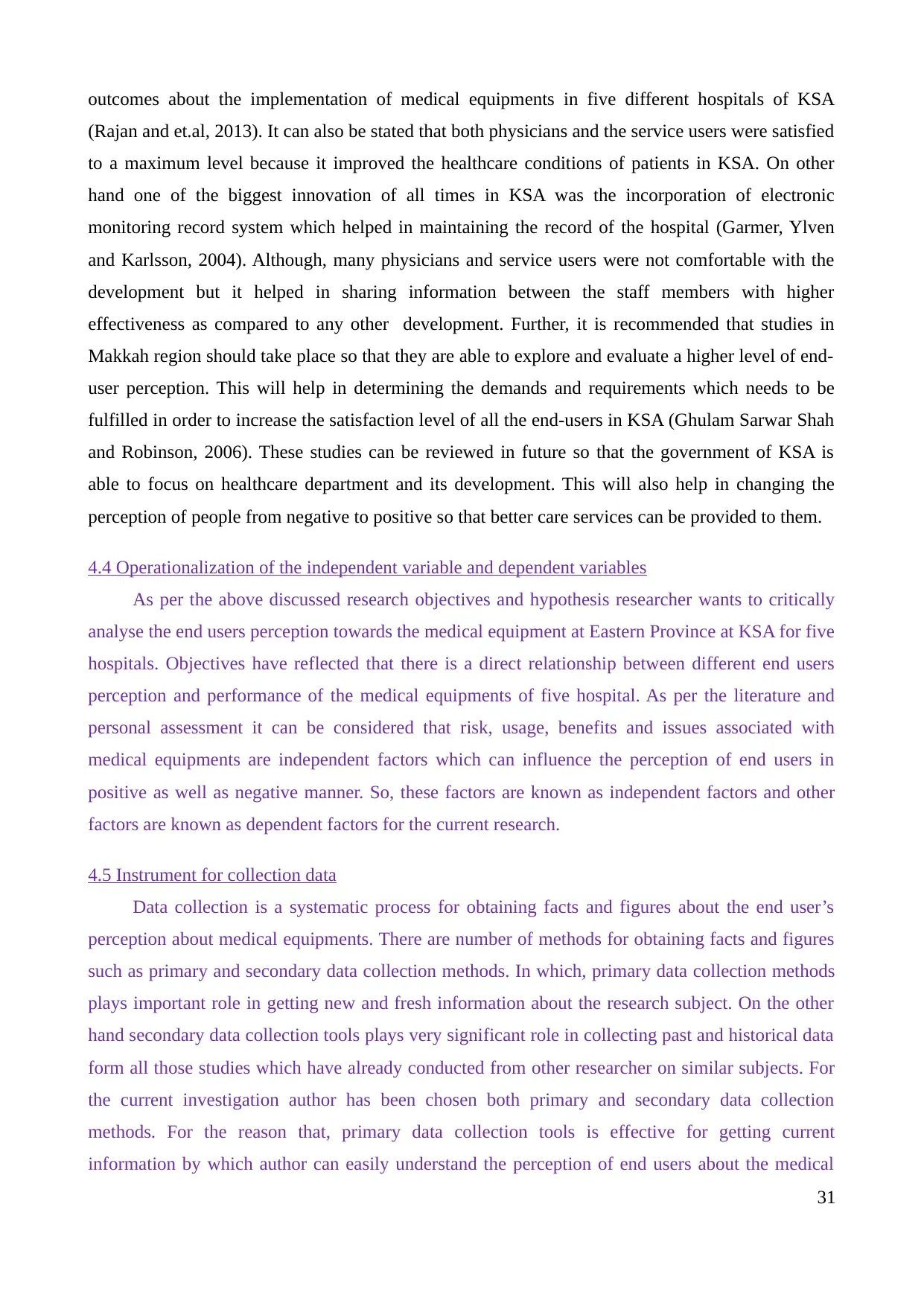
outcomes about the implementation of medical equipments in five different hospitals of KSA
(Rajan and et.al, 2013). It can also be stated that both physicians and the service users were satisfied
to a maximum level because it improved the healthcare conditions of patients in KSA. On other
hand one of the biggest innovation of all times in KSA was the incorporation of electronic
monitoring record system which helped in maintaining the record of the hospital (Garmer, Ylven
and Karlsson, 2004). Although, many physicians and service users were not comfortable with the
development but it helped in sharing information between the staff members with higher
effectiveness as compared to any other development. Further, it is recommended that studies in
Makkah region should take place so that they are able to explore and evaluate a higher level of end-
user perception. This will help in determining the demands and requirements which needs to be
fulfilled in order to increase the satisfaction level of all the end-users in KSA (Ghulam Sarwar Shah
and Robinson, 2006). These studies can be reviewed in future so that the government of KSA is
able to focus on healthcare department and its development. This will also help in changing the
perception of people from negative to positive so that better care services can be provided to them.
4.4 Operationalization of the independent variable and dependent variables
As per the above discussed research objectives and hypothesis researcher wants to critically
analyse the end users perception towards the medical equipment at Eastern Province at KSA for five
hospitals. Objectives have reflected that there is a direct relationship between different end users
perception and performance of the medical equipments of five hospital. As per the literature and
personal assessment it can be considered that risk, usage, benefits and issues associated with
medical equipments are independent factors which can influence the perception of end users in
positive as well as negative manner. So, these factors are known as independent factors and other
factors are known as dependent factors for the current research.
4.5 Instrument for collection data
Data collection is a systematic process for obtaining facts and figures about the end user’s
perception about medical equipments. There are number of methods for obtaining facts and figures
such as primary and secondary data collection methods. In which, primary data collection methods
plays important role in getting new and fresh information about the research subject. On the other
hand secondary data collection tools plays very significant role in collecting past and historical data
form all those studies which have already conducted from other researcher on similar subjects. For
the current investigation author has been chosen both primary and secondary data collection
methods. For the reason that, primary data collection tools is effective for getting current
information by which author can easily understand the perception of end users about the medical
31
(Rajan and et.al, 2013). It can also be stated that both physicians and the service users were satisfied
to a maximum level because it improved the healthcare conditions of patients in KSA. On other
hand one of the biggest innovation of all times in KSA was the incorporation of electronic
monitoring record system which helped in maintaining the record of the hospital (Garmer, Ylven
and Karlsson, 2004). Although, many physicians and service users were not comfortable with the
development but it helped in sharing information between the staff members with higher
effectiveness as compared to any other development. Further, it is recommended that studies in
Makkah region should take place so that they are able to explore and evaluate a higher level of end-
user perception. This will help in determining the demands and requirements which needs to be
fulfilled in order to increase the satisfaction level of all the end-users in KSA (Ghulam Sarwar Shah
and Robinson, 2006). These studies can be reviewed in future so that the government of KSA is
able to focus on healthcare department and its development. This will also help in changing the
perception of people from negative to positive so that better care services can be provided to them.
4.4 Operationalization of the independent variable and dependent variables
As per the above discussed research objectives and hypothesis researcher wants to critically
analyse the end users perception towards the medical equipment at Eastern Province at KSA for five
hospitals. Objectives have reflected that there is a direct relationship between different end users
perception and performance of the medical equipments of five hospital. As per the literature and
personal assessment it can be considered that risk, usage, benefits and issues associated with
medical equipments are independent factors which can influence the perception of end users in
positive as well as negative manner. So, these factors are known as independent factors and other
factors are known as dependent factors for the current research.
4.5 Instrument for collection data
Data collection is a systematic process for obtaining facts and figures about the end user’s
perception about medical equipments. There are number of methods for obtaining facts and figures
such as primary and secondary data collection methods. In which, primary data collection methods
plays important role in getting new and fresh information about the research subject. On the other
hand secondary data collection tools plays very significant role in collecting past and historical data
form all those studies which have already conducted from other researcher on similar subjects. For
the current investigation author has been chosen both primary and secondary data collection
methods. For the reason that, primary data collection tools is effective for getting current
information by which author can easily understand the perception of end users about the medical
31
Paraphrase This Document
Need a fresh take? Get an instant paraphrase of this document with our AI Paraphraser
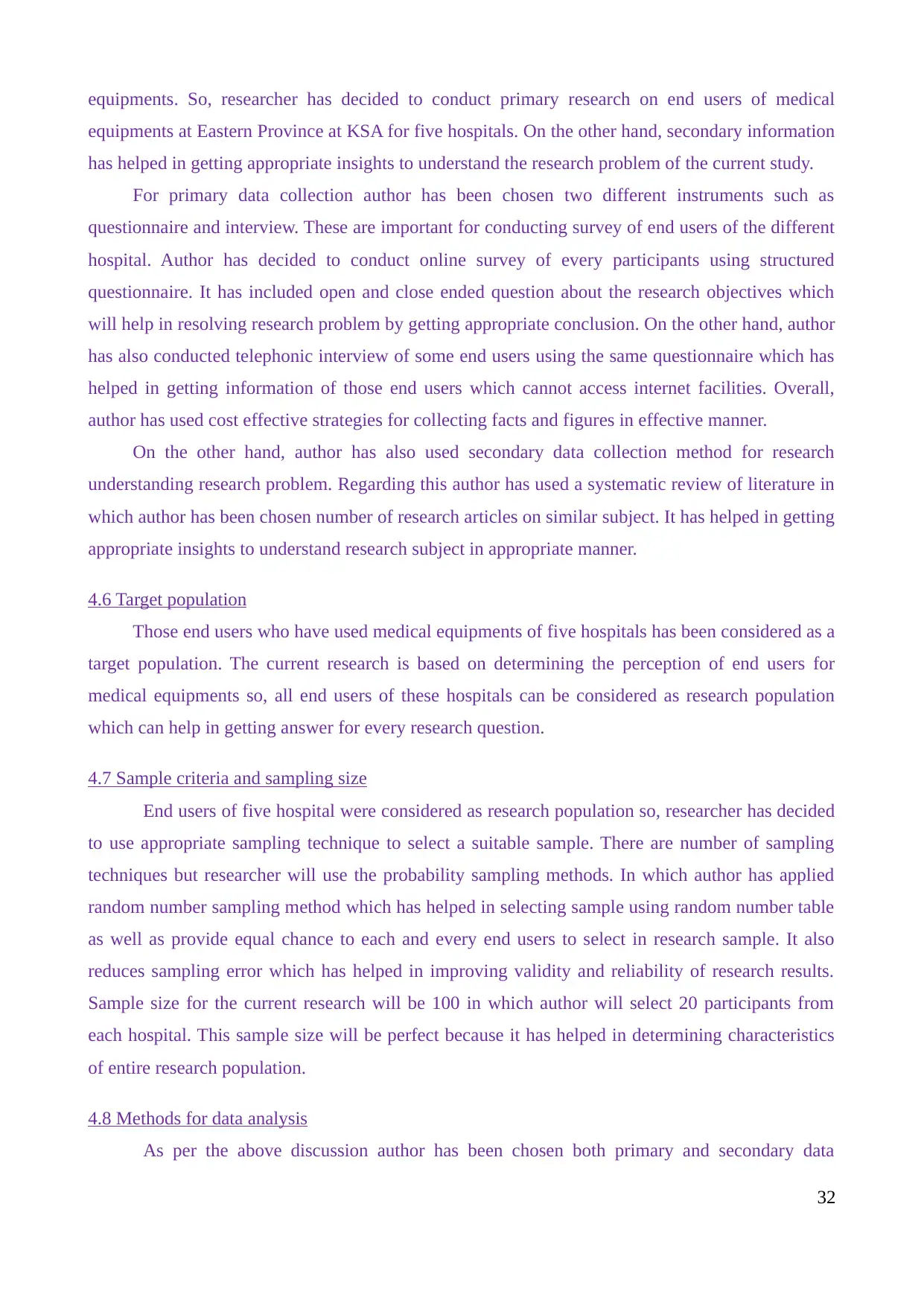
equipments. So, researcher has decided to conduct primary research on end users of medical
equipments at Eastern Province at KSA for five hospitals. On the other hand, secondary information
has helped in getting appropriate insights to understand the research problem of the current study.
For primary data collection author has been chosen two different instruments such as
questionnaire and interview. These are important for conducting survey of end users of the different
hospital. Author has decided to conduct online survey of every participants using structured
questionnaire. It has included open and close ended question about the research objectives which
will help in resolving research problem by getting appropriate conclusion. On the other hand, author
has also conducted telephonic interview of some end users using the same questionnaire which has
helped in getting information of those end users which cannot access internet facilities. Overall,
author has used cost effective strategies for collecting facts and figures in effective manner.
On the other hand, author has also used secondary data collection method for research
understanding research problem. Regarding this author has used a systematic review of literature in
which author has been chosen number of research articles on similar subject. It has helped in getting
appropriate insights to understand research subject in appropriate manner.
4.6 Target population
Those end users who have used medical equipments of five hospitals has been considered as a
target population. The current research is based on determining the perception of end users for
medical equipments so, all end users of these hospitals can be considered as research population
which can help in getting answer for every research question.
4.7 Sample criteria and sampling size
End users of five hospital were considered as research population so, researcher has decided
to use appropriate sampling technique to select a suitable sample. There are number of sampling
techniques but researcher will use the probability sampling methods. In which author has applied
random number sampling method which has helped in selecting sample using random number table
as well as provide equal chance to each and every end users to select in research sample. It also
reduces sampling error which has helped in improving validity and reliability of research results.
Sample size for the current research will be 100 in which author will select 20 participants from
each hospital. This sample size will be perfect because it has helped in determining characteristics
of entire research population.
4.8 Methods for data analysis
As per the above discussion author has been chosen both primary and secondary data
32
equipments at Eastern Province at KSA for five hospitals. On the other hand, secondary information
has helped in getting appropriate insights to understand the research problem of the current study.
For primary data collection author has been chosen two different instruments such as
questionnaire and interview. These are important for conducting survey of end users of the different
hospital. Author has decided to conduct online survey of every participants using structured
questionnaire. It has included open and close ended question about the research objectives which
will help in resolving research problem by getting appropriate conclusion. On the other hand, author
has also conducted telephonic interview of some end users using the same questionnaire which has
helped in getting information of those end users which cannot access internet facilities. Overall,
author has used cost effective strategies for collecting facts and figures in effective manner.
On the other hand, author has also used secondary data collection method for research
understanding research problem. Regarding this author has used a systematic review of literature in
which author has been chosen number of research articles on similar subject. It has helped in getting
appropriate insights to understand research subject in appropriate manner.
4.6 Target population
Those end users who have used medical equipments of five hospitals has been considered as a
target population. The current research is based on determining the perception of end users for
medical equipments so, all end users of these hospitals can be considered as research population
which can help in getting answer for every research question.
4.7 Sample criteria and sampling size
End users of five hospital were considered as research population so, researcher has decided
to use appropriate sampling technique to select a suitable sample. There are number of sampling
techniques but researcher will use the probability sampling methods. In which author has applied
random number sampling method which has helped in selecting sample using random number table
as well as provide equal chance to each and every end users to select in research sample. It also
reduces sampling error which has helped in improving validity and reliability of research results.
Sample size for the current research will be 100 in which author will select 20 participants from
each hospital. This sample size will be perfect because it has helped in determining characteristics
of entire research population.
4.8 Methods for data analysis
As per the above discussion author has been chosen both primary and secondary data
32
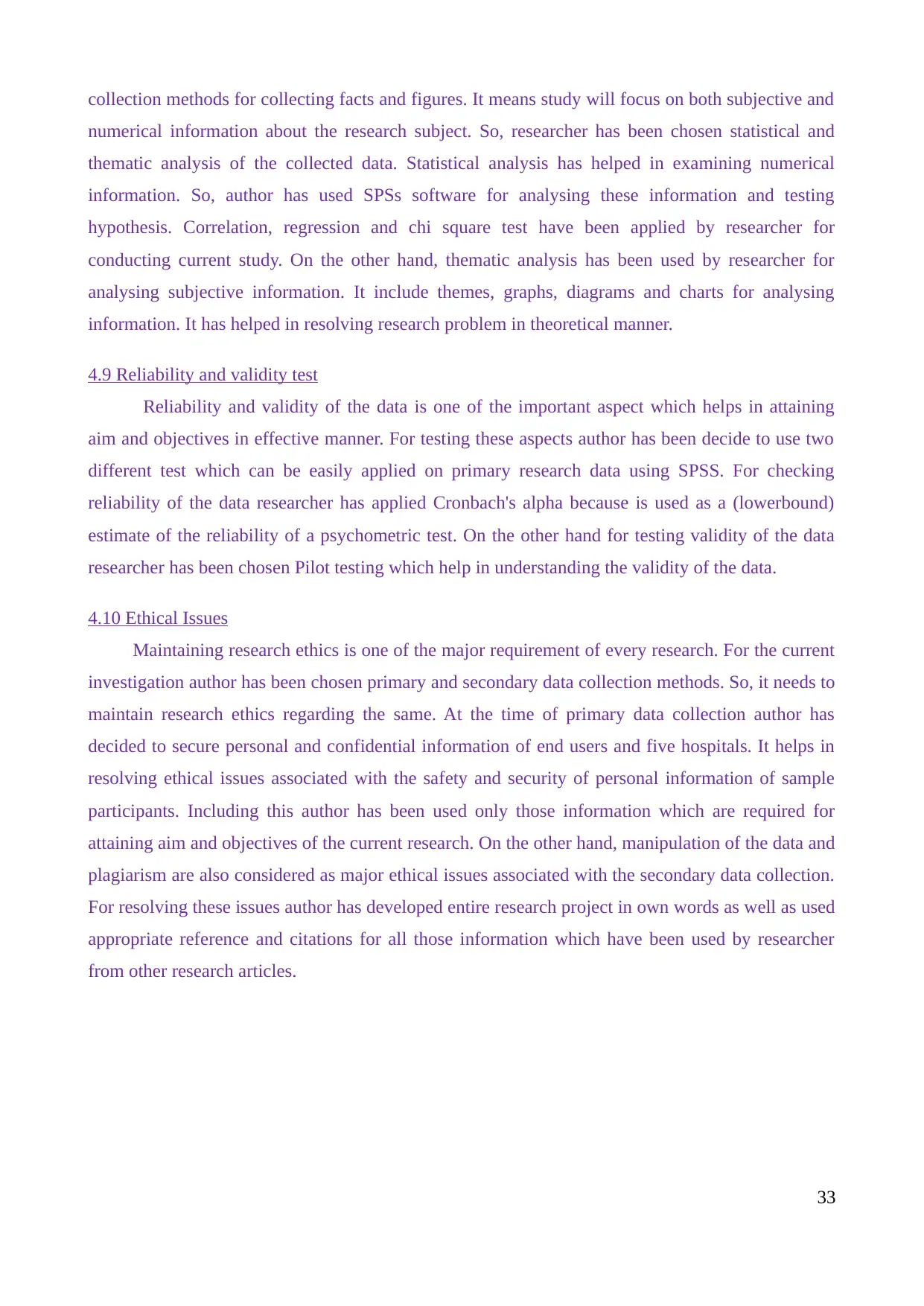
collection methods for collecting facts and figures. It means study will focus on both subjective and
numerical information about the research subject. So, researcher has been chosen statistical and
thematic analysis of the collected data. Statistical analysis has helped in examining numerical
information. So, author has used SPSs software for analysing these information and testing
hypothesis. Correlation, regression and chi square test have been applied by researcher for
conducting current study. On the other hand, thematic analysis has been used by researcher for
analysing subjective information. It include themes, graphs, diagrams and charts for analysing
information. It has helped in resolving research problem in theoretical manner.
4.9 Reliability and validity test
Reliability and validity of the data is one of the important aspect which helps in attaining
aim and objectives in effective manner. For testing these aspects author has been decide to use two
different test which can be easily applied on primary research data using SPSS. For checking
reliability of the data researcher has applied Cronbach's alpha because is used as a (lowerbound)
estimate of the reliability of a psychometric test. On the other hand for testing validity of the data
researcher has been chosen Pilot testing which help in understanding the validity of the data.
4.10 Ethical Issues
Maintaining research ethics is one of the major requirement of every research. For the current
investigation author has been chosen primary and secondary data collection methods. So, it needs to
maintain research ethics regarding the same. At the time of primary data collection author has
decided to secure personal and confidential information of end users and five hospitals. It helps in
resolving ethical issues associated with the safety and security of personal information of sample
participants. Including this author has been used only those information which are required for
attaining aim and objectives of the current research. On the other hand, manipulation of the data and
plagiarism are also considered as major ethical issues associated with the secondary data collection.
For resolving these issues author has developed entire research project in own words as well as used
appropriate reference and citations for all those information which have been used by researcher
from other research articles.
33
numerical information about the research subject. So, researcher has been chosen statistical and
thematic analysis of the collected data. Statistical analysis has helped in examining numerical
information. So, author has used SPSs software for analysing these information and testing
hypothesis. Correlation, regression and chi square test have been applied by researcher for
conducting current study. On the other hand, thematic analysis has been used by researcher for
analysing subjective information. It include themes, graphs, diagrams and charts for analysing
information. It has helped in resolving research problem in theoretical manner.
4.9 Reliability and validity test
Reliability and validity of the data is one of the important aspect which helps in attaining
aim and objectives in effective manner. For testing these aspects author has been decide to use two
different test which can be easily applied on primary research data using SPSS. For checking
reliability of the data researcher has applied Cronbach's alpha because is used as a (lowerbound)
estimate of the reliability of a psychometric test. On the other hand for testing validity of the data
researcher has been chosen Pilot testing which help in understanding the validity of the data.
4.10 Ethical Issues
Maintaining research ethics is one of the major requirement of every research. For the current
investigation author has been chosen primary and secondary data collection methods. So, it needs to
maintain research ethics regarding the same. At the time of primary data collection author has
decided to secure personal and confidential information of end users and five hospitals. It helps in
resolving ethical issues associated with the safety and security of personal information of sample
participants. Including this author has been used only those information which are required for
attaining aim and objectives of the current research. On the other hand, manipulation of the data and
plagiarism are also considered as major ethical issues associated with the secondary data collection.
For resolving these issues author has developed entire research project in own words as well as used
appropriate reference and citations for all those information which have been used by researcher
from other research articles.
33
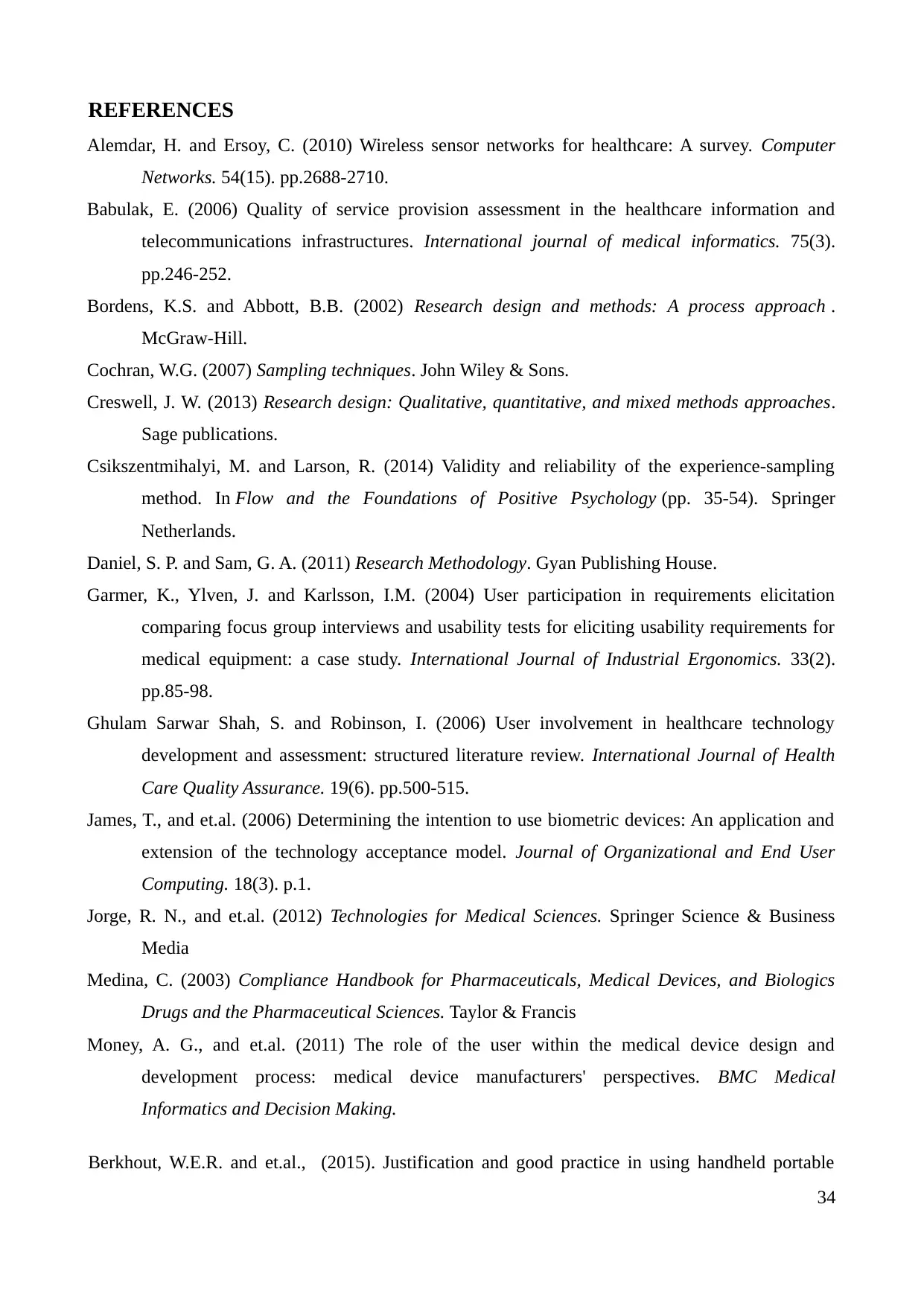
REFERENCES
Alemdar, H. and Ersoy, C. (2010) Wireless sensor networks for healthcare: A survey. Computer
Networks. 54(15). pp.2688-2710.
Babulak, E. (2006) Quality of service provision assessment in the healthcare information and
telecommunications infrastructures. International journal of medical informatics. 75(3).
pp.246-252.
Bordens, K.S. and Abbott, B.B. (2002) Research design and methods: A process approach .
McGraw-Hill.
Cochran, W.G. (2007) Sampling techniques. John Wiley & Sons.
Creswell, J. W. (2013) Research design: Qualitative, quantitative, and mixed methods approaches.
Sage publications.
Csikszentmihalyi, M. and Larson, R. (2014) Validity and reliability of the experience-sampling
method. In Flow and the Foundations of Positive Psychology (pp. 35-54). Springer
Netherlands.
Daniel, S. P. and Sam, G. A. (2011) Research Methodology. Gyan Publishing House.
Garmer, K., Ylven, J. and Karlsson, I.M. (2004) User participation in requirements elicitation
comparing focus group interviews and usability tests for eliciting usability requirements for
medical equipment: a case study. International Journal of Industrial Ergonomics. 33(2).
pp.85-98.
Ghulam Sarwar Shah, S. and Robinson, I. (2006) User involvement in healthcare technology
development and assessment: structured literature review. International Journal of Health
Care Quality Assurance. 19(6). pp.500-515.
James, T., and et.al. (2006) Determining the intention to use biometric devices: An application and
extension of the technology acceptance model. Journal of Organizational and End User
Computing. 18(3). p.1.
Jorge, R. N., and et.al. (2012) Technologies for Medical Sciences. Springer Science & Business
Media
Medina, C. (2003) Compliance Handbook for Pharmaceuticals, Medical Devices, and Biologics
Drugs and the Pharmaceutical Sciences. Taylor & Francis
Money, A. G., and et.al. (2011) The role of the user within the medical device design and
development process: medical device manufacturers' perspectives. BMC Medical
Informatics and Decision Making.
Berkhout, W.E.R. and et.al., (2015). Justification and good practice in using handheld portable
34
Alemdar, H. and Ersoy, C. (2010) Wireless sensor networks for healthcare: A survey. Computer
Networks. 54(15). pp.2688-2710.
Babulak, E. (2006) Quality of service provision assessment in the healthcare information and
telecommunications infrastructures. International journal of medical informatics. 75(3).
pp.246-252.
Bordens, K.S. and Abbott, B.B. (2002) Research design and methods: A process approach .
McGraw-Hill.
Cochran, W.G. (2007) Sampling techniques. John Wiley & Sons.
Creswell, J. W. (2013) Research design: Qualitative, quantitative, and mixed methods approaches.
Sage publications.
Csikszentmihalyi, M. and Larson, R. (2014) Validity and reliability of the experience-sampling
method. In Flow and the Foundations of Positive Psychology (pp. 35-54). Springer
Netherlands.
Daniel, S. P. and Sam, G. A. (2011) Research Methodology. Gyan Publishing House.
Garmer, K., Ylven, J. and Karlsson, I.M. (2004) User participation in requirements elicitation
comparing focus group interviews and usability tests for eliciting usability requirements for
medical equipment: a case study. International Journal of Industrial Ergonomics. 33(2).
pp.85-98.
Ghulam Sarwar Shah, S. and Robinson, I. (2006) User involvement in healthcare technology
development and assessment: structured literature review. International Journal of Health
Care Quality Assurance. 19(6). pp.500-515.
James, T., and et.al. (2006) Determining the intention to use biometric devices: An application and
extension of the technology acceptance model. Journal of Organizational and End User
Computing. 18(3). p.1.
Jorge, R. N., and et.al. (2012) Technologies for Medical Sciences. Springer Science & Business
Media
Medina, C. (2003) Compliance Handbook for Pharmaceuticals, Medical Devices, and Biologics
Drugs and the Pharmaceutical Sciences. Taylor & Francis
Money, A. G., and et.al. (2011) The role of the user within the medical device design and
development process: medical device manufacturers' perspectives. BMC Medical
Informatics and Decision Making.
Berkhout, W.E.R. and et.al., (2015). Justification and good practice in using handheld portable
34
Secure Best Marks with AI Grader
Need help grading? Try our AI Grader for instant feedback on your assignments.
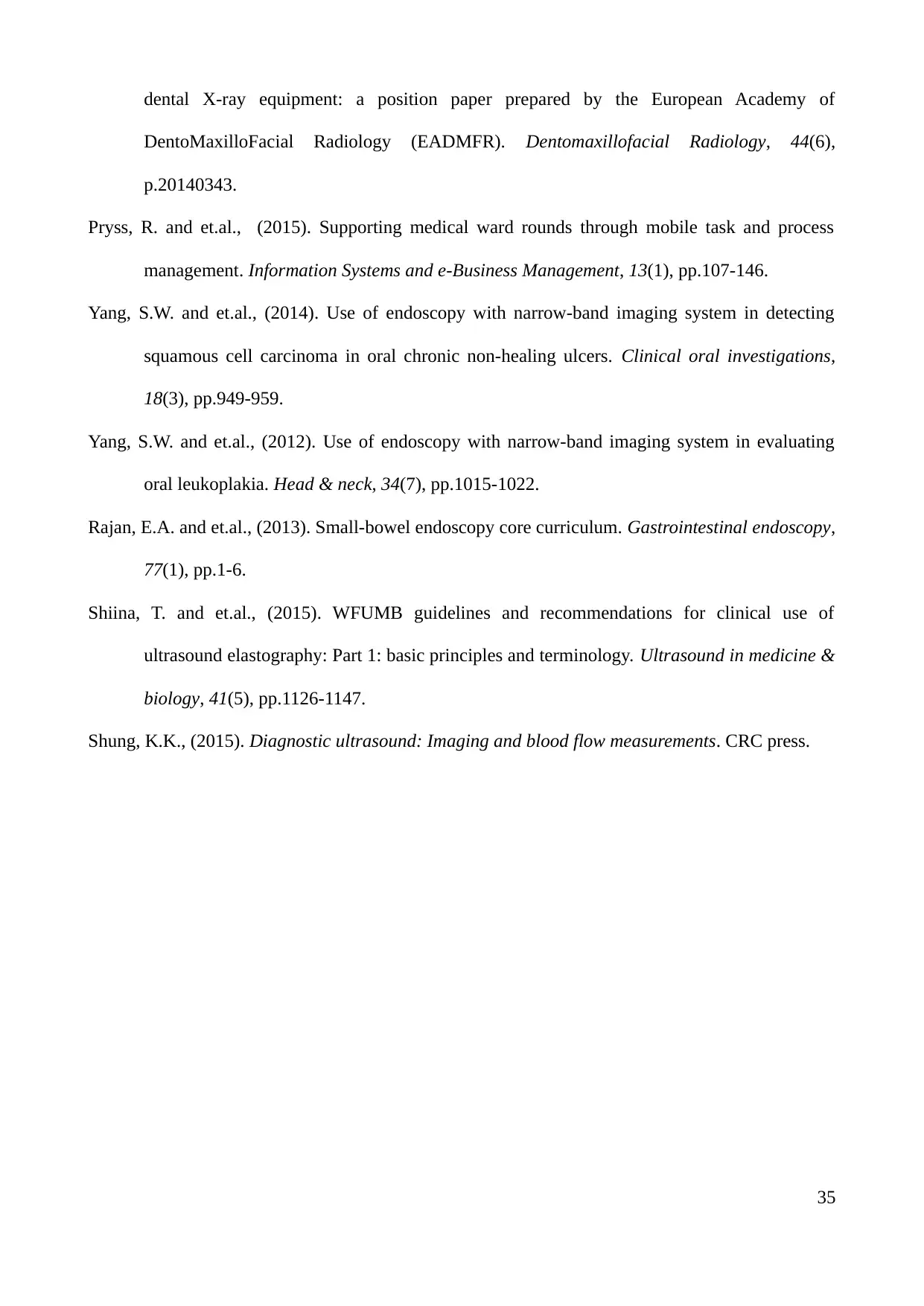
dental X-ray equipment: a position paper prepared by the European Academy of
DentoMaxilloFacial Radiology (EADMFR). Dentomaxillofacial Radiology, 44(6),
p.20140343.
Pryss, R. and et.al., (2015). Supporting medical ward rounds through mobile task and process
management. Information Systems and e-Business Management, 13(1), pp.107-146.
Yang, S.W. and et.al., (2014). Use of endoscopy with narrow-band imaging system in detecting
squamous cell carcinoma in oral chronic non-healing ulcers. Clinical oral investigations,
18(3), pp.949-959.
Yang, S.W. and et.al., (2012). Use of endoscopy with narrow‐band imaging system in evaluating
oral leukoplakia. Head & neck, 34(7), pp.1015-1022.
Rajan, E.A. and et.al., (2013). Small-bowel endoscopy core curriculum. Gastrointestinal endoscopy,
77(1), pp.1-6.
Shiina, T. and et.al., (2015). WFUMB guidelines and recommendations for clinical use of
ultrasound elastography: Part 1: basic principles and terminology. Ultrasound in medicine &
biology, 41(5), pp.1126-1147.
Shung, K.K., (2015). Diagnostic ultrasound: Imaging and blood flow measurements. CRC press.
35
DentoMaxilloFacial Radiology (EADMFR). Dentomaxillofacial Radiology, 44(6),
p.20140343.
Pryss, R. and et.al., (2015). Supporting medical ward rounds through mobile task and process
management. Information Systems and e-Business Management, 13(1), pp.107-146.
Yang, S.W. and et.al., (2014). Use of endoscopy with narrow-band imaging system in detecting
squamous cell carcinoma in oral chronic non-healing ulcers. Clinical oral investigations,
18(3), pp.949-959.
Yang, S.W. and et.al., (2012). Use of endoscopy with narrow‐band imaging system in evaluating
oral leukoplakia. Head & neck, 34(7), pp.1015-1022.
Rajan, E.A. and et.al., (2013). Small-bowel endoscopy core curriculum. Gastrointestinal endoscopy,
77(1), pp.1-6.
Shiina, T. and et.al., (2015). WFUMB guidelines and recommendations for clinical use of
ultrasound elastography: Part 1: basic principles and terminology. Ultrasound in medicine &
biology, 41(5), pp.1126-1147.
Shung, K.K., (2015). Diagnostic ultrasound: Imaging and blood flow measurements. CRC press.
35
1 out of 35
Related Documents
Your All-in-One AI-Powered Toolkit for Academic Success.
+13062052269
info@desklib.com
Available 24*7 on WhatsApp / Email
![[object Object]](/_next/static/media/star-bottom.7253800d.svg)
Unlock your academic potential
© 2024 | Zucol Services PVT LTD | All rights reserved.





